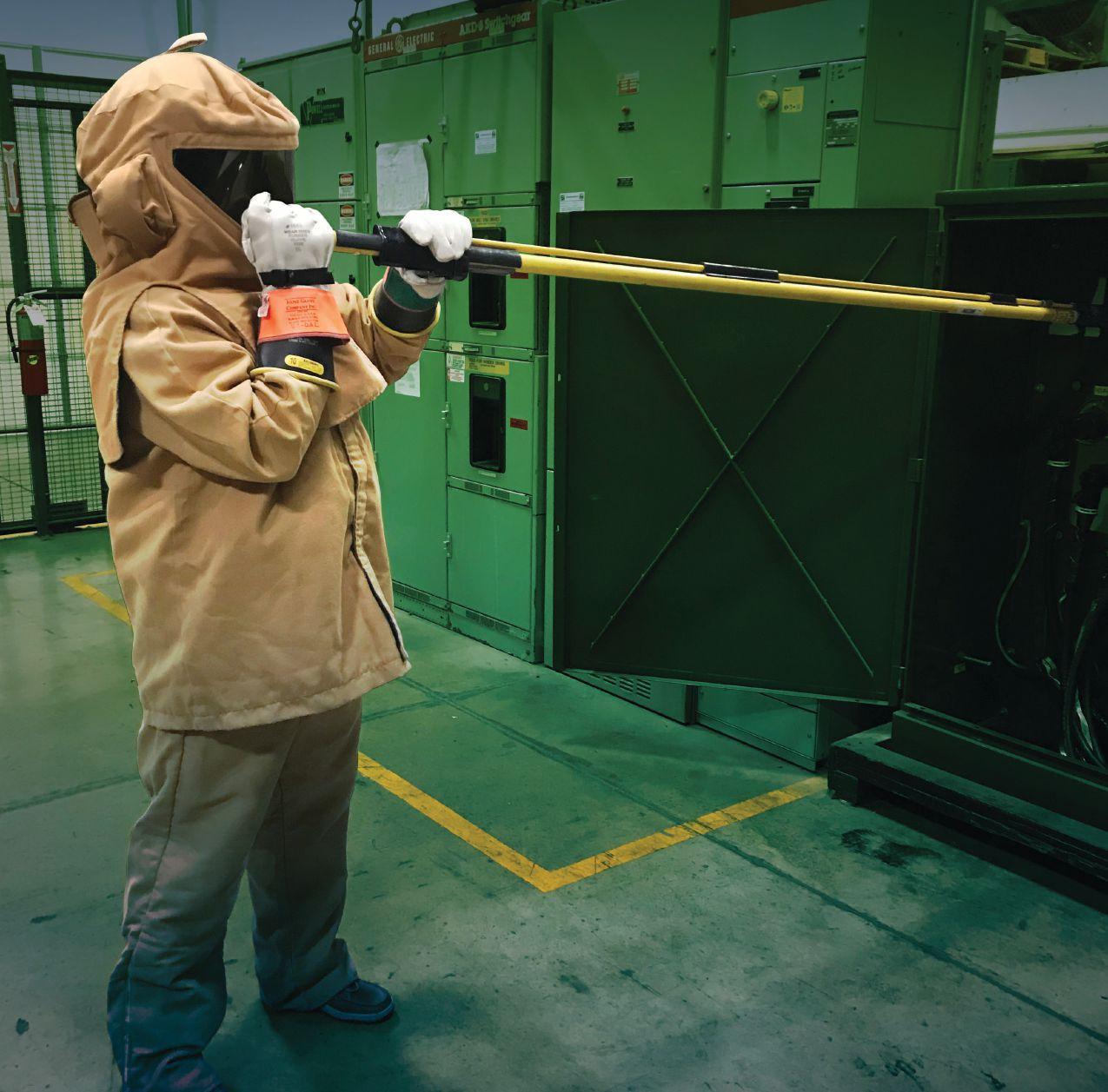




ISSN 2167-3594 NETA WORLD JOURNAL PRINT ISSN 2167-3586 NETA WORLD JOURNAL ONLINE SPRING 2013SUMMER 2020 NETA OUTSTANDING ACHIEVEMENT AND ALLIANCE RECOGNITION AWARDS PAGE 110 USING NFPA 70E TO DETERMINE SHOCK AND ARC FLASH BOUNDARIES








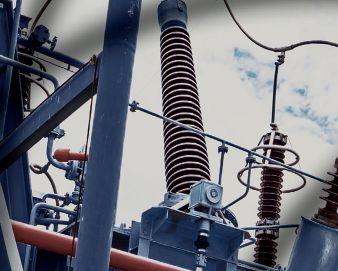







































Megger’s Multi-Function Transformer and Substation Test Systems give you more tests, more features and the clearest picture of your assets’ health… all from a single unit.
A Megger Multi-Function Test System eliminates the need for multiple instruments, simplifies training, decreases testing time, and lowers your costs while still delivering the accurate testing you need. Megger’s Multi-Function Test Systems prove you can get more with less.
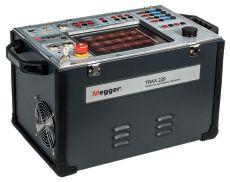
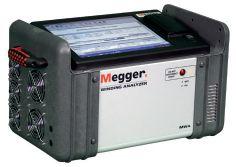


























Multi-Function Transformer and Substation Test System
3-Phase Ratio and Winding Resistance Analyzer
TRAX
MWA
1-800-723-2861 us.megger.com See More With Less



Electrical Power Systems Industry Resource on Technical and Professional Training SUMMER 2020: VOL. 5. NO. 1
NEW
TRAIN LIVE & REMOTE WITHOUT SACRIFICING QUALITY
FREE monthly webinars
*Earn 1 NETA CTD and 1 PDH or 0.1 CEU
Learn valuable testing tips and tricks
Can’t attend? View video recordings

TRAINING INSTITUTE


Virtual Training Options
• VIRTUAL NFPA 70E® 2018 (2-day)
• VIRTUAL NATIONAL ELECTRICAL CODE CHANGES 2020 (2-day)
• VIRTUAL ELECTRICAL SAFETY FOR INDUSTRIAL FACILITIES (4-day)
• VIRTUAL ELECTRICAL SAFETY FOR UTILITIES (4-day)
Virtual courses can be scheduled as open-enrollment dates or requested for an on-site training at your facility.
For questions or to enroll, please call us at 877-594-3156 or visit us at avotraining.com/virtual
Testing Tactics Webinar Series
Megger has partnered with NETA (International Electrical Testing Association) to present Testing Tactics, a special monthly webinar series that allows registrants to receive NETA CTDs (Continuing Technical Development Credits)* for attending the live webinar.
The Megger Testing Tactics Webinar Series provides valuable educational electrical testing knowledge in areas including theory and applications, best practices, industry standards / procedures, and safety. These FREE webinars are presented by Megger’s expert Applications Engineers and Product Managers, who utilize their experiences in the field and industry to give you greater insight into electrical testing so you can test with confidence.


Upcoming Webinars
Jun 19
Rotating machines
Off-line Partial Discharge Testing of Rotating Machines
Aug 21
Transformer
Narrow Band Dielectric Frequency Response – Application on HV and EHV OIP Bushings
us.megger.com/webinars
Jul 17
Protection
Feeder Protection in Power
Distribution Systems
Sep 18
Protection
MV and HV Circuit Breaker
Testing beyond Timing and Travel Measurements
LIVE VIRTUAL ONLINE TRAINING
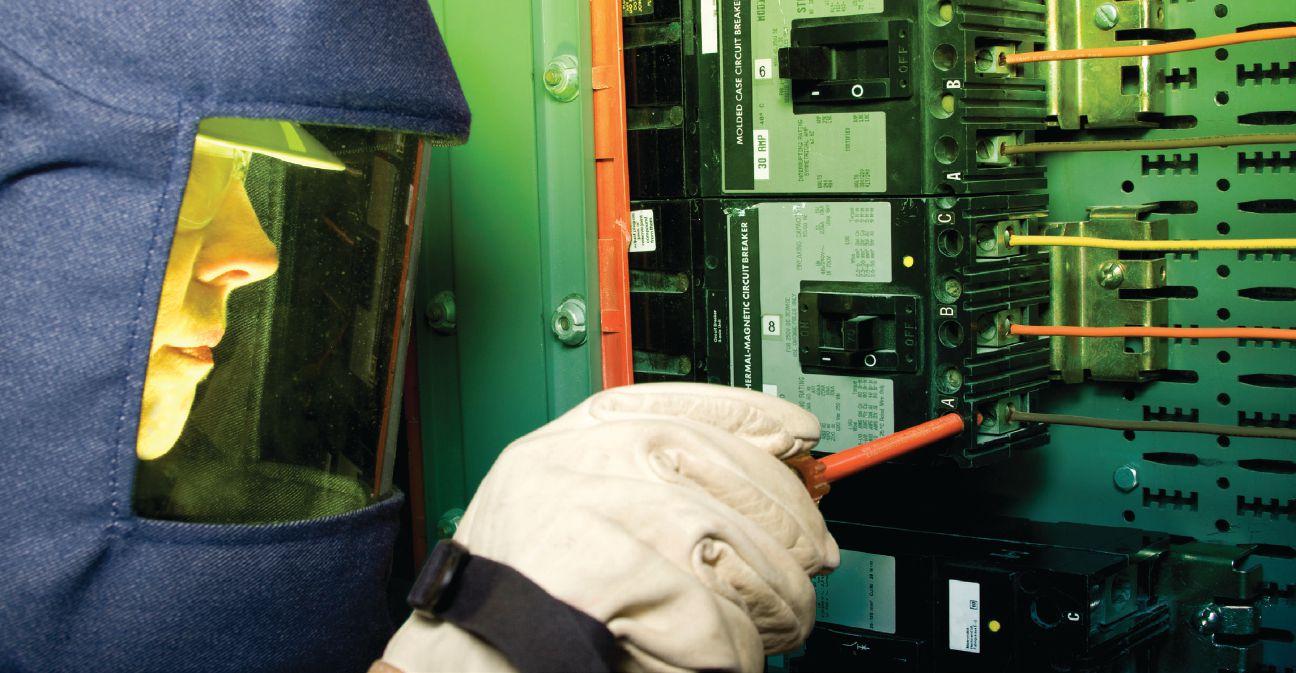
AUTOMATED VS MANUAL TESTING: BENEFITS AND CONSEQUENCES
By Ralph Parrett, AVO Training Institute
HOW TO TEST LOW-VOLTAGE CIRCUIT BREAKER GROUND FAULT PROTECTION — PART 1
By Daniel Carreño and Volney Naranjo, Megger HOW DO YOU START TRAINING YOUR TEAM?

Chuck Baker, SDMyers
INSIDE
SUMMER 2020 04 08 13 16 A
Journal Special Publication A
for
industry
By
COMPUTER-BASED TRAINING: PLEASE STEP
By James R. White, Shermco Industries
NETA World
publication dedicated to disseminating information on technical and professional training
the advancement of the electrical power systems
AUTOMATED vs MANUAL TESTING:
BENEFITS AND CONSEQUENCES
BY RALPH PARRETT , AVO Training Institute
The importance of obtaining data for the purpose of trending equipment life expectancy is a well-established topic. Today’s challenge is with the testing techniques and equipment used to obtain that data.
Organizations such as the InterNational Electrical Testing Association (NETA), the National Fire Protection Association (NFPA), and the Institute of Electrical and Electronic Engineers (IEEE) all release testing standards that must be followed. NFPA 70B, Recommended Practice for Electrical Equipment Maintenance provides general requirements such as testing the function of a protective relay, but does not get into the detail of which tests are to be conducted for each type of protective element. NETA standards provide a foundation for the tests that should be conducted including such as insulation resistance, high-potential testing, digital low-resistance ohmmeter testing, pickup, timing, differential, etc. However, these publications do not provide detail on how to use the tests to obtain optimal results. This article looks at opportunities presented by today’s test equipment capabilities.
Given today’s technology, it is no surprise the automation capabilities of modern electrical test
equipment have spoiled us. Automated testing has proven to be more cost and time effective and, due to its repeatability, has proven viable for creating the trending data required to foresee equipment issues. It is easy to see the benefits of automated testing, but we need to take a closer look to see where we might be left vulnerable to our dependency on the test equipment and its operating software capabilities.
TRANSFORMER TESTING
The first example is a test form that can be used when performing power factor testing on a two-winding transformer. The test form does a remarkable job at providing an interface between the user and the tests to be conducted (Figure 1). It takes approximately 20 minutes to set up the piece of equipment and 5 minutes to conduct all required tests on a two-winding transformer. Three tests on the high-side winding — high-to-ground, high-to-ground (guard low), and high-to-low — are conducted with a common, one-time connection setup and are cycled through automatically. The test set automatically switches the measurement method to obtain each reading. The technician next follows safety precautions to verify the circuit is de-energized and grounded, switches the high-voltage and return (guard) leads, and performs the same evolution for the low-side winding.
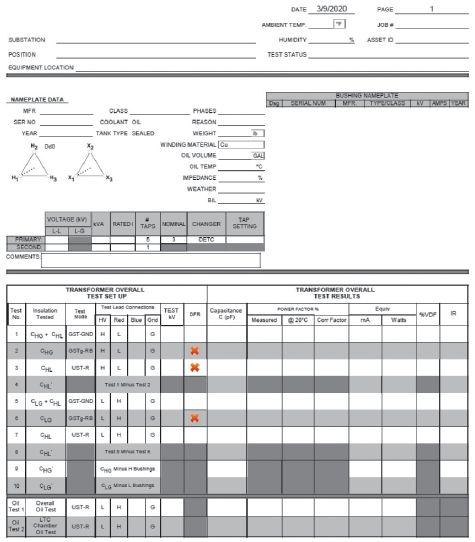
4 | TRAINING TALK | A NETA WORLD JOURNAL SPECIAL PUBLICATION
Figure 1: Insulation Tests on Two-Winding Transformer
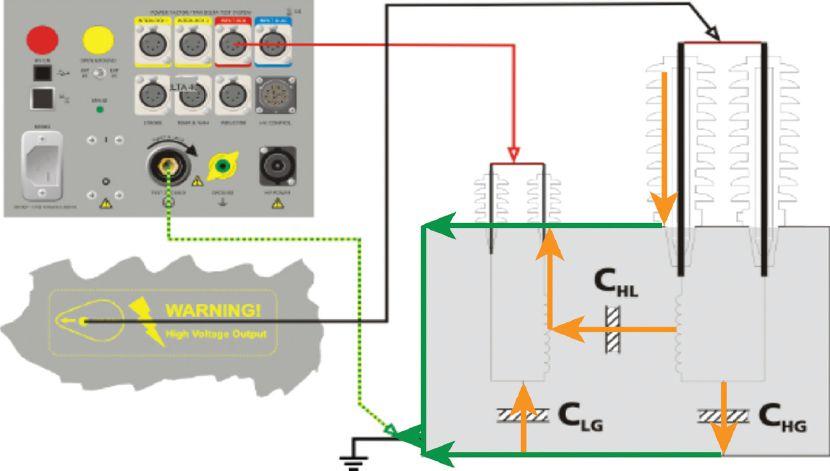

One downside could be that the technicians performing the tests are no longer required to have a deeper understanding of how the tests are conducted, especially the importance using various measuring methodologies to obtain each reading.
First, the high-to-ground test uses the grounded specimen test (GST) mode, which measures all leakage current found to ground (Figure 2). All leakage current sources, indicated with amber arrows, are from the high-side bushings, highto-ground, and high-side-to-low-side-to-ground.
When a GST is conducted, all currents returning to ground will be measured as indicated by the green arrows.
The second test, high-to-ground (guard low), uses the grounded specimen test using a guard terminal (GSTg); any leakage current found on the guard terminal will be subtracted, ignored, or not measured in relation to the current measured on the ground terminal (Figure 3). All leakage current sources, indicated with amber and purple arrows, are again from the high side bushings, high-to-ground,
A NETA WORLD JOURNAL SPECIAL PUBLICATION | TRAINING TALK | 5
Figure 2: High-to-Ground Test Using GST Mode
Figure 3: Grounded Specimen Test Using Guard Terminal (GSTg) and Ungrounded Specimen Test (UST) Mode
and high-side-to-low-side-to-ground. However, the leakage current measured at the guard terminal, indicated with purple arrows, will be ignored by the test equipment and removed from the leakage current measured during the GST mode used in the first test. The GSTg mode removes leakage currents associated with the low-side winding.
The final high-to-low test uses the ungrounded specimen test (UST) measurement mode; any leakage current found on the ground terminal will be subtracted, ignored, or not measured in relation to the current measured on the guard terminal (Figure 3). All leakage current sources are again from the high side bushings, high-toground, and high-side-to-low-side-to-ground, indicated with amber and purple arrows. However, the test equipment measures the leakage current measured at the guard terminal, indicated with purple arrows, thus providing the leakage current between the high- and low-side windings. The leakage current measured at the ground terminal is now removed from the leakage current measured during the GST and GSTg modes used in the first and second tests.
Using the GST, GSTg, and UST modes results together, it is possible to determine whether there is an internal issue due to winding shifting, for example, versus degrading or dirty bushings. Prior to development of the test forms, technicians were

required to understand the required test modes for each test or depend on operating procedures that detailed the test methods step-by-step. In comparison, automated versus manual testing should give the same results given environmental conditions and test connections are consistent.
For some readers, this merely reviews prior knowledge and understanding. In some cases, however, it is difficult to convey this information to new up-and-coming technicians. This is where manual testing can benefit technicians new to power factor testing, and various companies offer a manual testing interface that can be used by technicians (Figure 4). Operating in manual mode requires a technician to understand which measurement mode is required based on the equipment being tested. While the manual method requires more time to accomplish the same measurements, a technician is able to exercise his or her knowledge and put skills into practice.
PROTECTIVE RELAY TESTING
Microprocessor-based protective relays can be tested using manual or automated methods that present multiple opportunities for technicians to exercising their knowledge and skills. This is due to the relay’s inherent flexibility through different settings dependent on system configuration. NETA recognizes the efficiency of these relays by making the protective element testing optional, but there is value in manual single-element testing because it exercises a technician’s knowledge of the element and the ability to test the element characteristics. It also keeps the industry following standardized tests for all relays regardless of their technology or application.
COMTRADE TESTING
Comtrade testing as a replacement for standardized testing may not be valid because Comtrade files only present a single scenario previously captured during a fault condition that most likely caused undesirable or nuisance tripping. However, one benefit of testing based on a Comtrade file is that it will prove that the given settings will operate accordingly.
Comtrade file testing can present negative consequences in certain instances. While a Comtrade file presents a real event, a fault characteristic is
6 | TRAINING TALK | A NETA WORLD JOURNAL SPECIAL PUBLICATION
Figure 4: Example of Software with Manual Testing Interface
based on a number of uncontrollable factors such as weather. For example, if a Comtrade file was captured in a very dry area, the same fault would present different values if the ground was saturated due to rain. This could cause the protection scheme to operate differently.
It is also possible to edit a Comtrade file with additional characteristics to further improve the file. However, this is no longer a real event, which takes away from the major benefit or selling point that the test is from a true event.
Finally, if a Comtrade file or automated element test does not result in desired relay operation, the technician is faced with a several questions: What could have caused the undesirable operation? The relay? The test method? The connections? The test equipment? I have personally encountered each of these options and had to revert to manual testing to find the underlying issue. When a relay testing technician is trained to rely solely on automated tests — whether Comtrade file or single element — they will not be equipped to provide efficient reporting or correction when it does not perform as expected. This will require the organization to bring in a technician with higher knowledge, skills, and pay rate to resolve the issue. If the original technician had been trained on manual single-element testing and test equipment operation, perhaps they could have found and corrected the issue.

e best way to build up workforce knowledge for technicians is to ensure they understand what they are testing, the test method(s) being used, and the function of the test equipment.

CONCLUSION
Manual and automated testing must go hand in hand. The best way to build up workforce knowledge for technicians is to ensure they understand what they are testing, the test method(s) being used, and the function of the test equipment. Nothing supports the growth of that knowledge and skills like manual testing. On the other hand, manual testing in general cannot compete with the efficiency of automated testing, which saves time for the company and provides test data that is retrieved the same way every time — no matter who is operating the test equipment.
RALPH PARRETT is a United States Navy veteran with over 13 years of professional experience relating to electrical safety and maintenance training. During his time at AVO Training Institute, his proven dedication to training led to his position as Manager of Content & Delivery. His passion has always been to provide a topnotch training experience to ensure his students are more effective and safer when they return to the workplace. Ralph has extensive knowledge of maintenance, repair, and troubleshooting of control and instrumentation, relay logic systems, ABB control systems, central control station programs, power system equipment testing and maintenance, and other various types of equipment. He has developed and taught theory, operation, maintenance, and safety of various engineering systems.
A NETA WORLD JOURNAL SPECIAL PUBLICATION | TRAINING TALK | 7
HOW TO TEST LOW-VOLTAGE CIRCUIT BREAKER GROUND FAULT PROTECTION
PART 1
BY DANIEL CARREÑO and VOLNEY NARANJO, Megger
Selective coordination of a power system to ensure that the system is protected and power is maintained properly can be a large investment. Part of commissioning standards and maintenance procedures for low-voltage circuit breaker testing is to determine whether the circuit breaker is able to respond correctly to the faults and/or overloading conditions set in the coordination study.
When the coordination study includes ground fault (GF) as a part of the low-voltage circuit breaker protection scheme, the best approach to test these elements is to use primary injection. Techniques for detecting a ground fault in low-voltage circuit breakers include residual earth-fault, zero sequence, neutral protection, and earth leakage. Testing with primary injection ensures the applicable current transformers (CTs), main contacts, wiring, and trip unit are tested together as one complete circuit.
This paper covers the testing procedures and the challenges of ground fault testing low-voltage molded-case and power circuit breakers using primary injection such as cable length, power
sources, breaker configurations, CT polarity, CT sizing, as well as why primary injection is specified by NEC standards and NETA.
NFPA 70 REQUIREMENTS
NFPA 70–2017, National Electric Code includes an update to Article 230.95(C) Performance Testing stating that the ground fault protection system shall be tested using a process of primary current injection for newly installed ground-fault protection systems. Previously, NFPA 70–2014 Article 230.95(C) stated that the test shall be conducted in accordance with instructions that shall be provided with the equipment. This often left the testing method up to an installer who may or may not be familiar with how to properly test or install the ground fault protection system. Thus, prior to 2017, it would have been acceptable to use a secondary injection method or press the trip button to test the circuit breaker.
Testing a circuit breaker with the primary injection method will ensure all circuit breaker elements are tested, including breaker contacts, current sensors, wiring, and trip unit.
GROUND FAULT DETECTION METHODS
Methods of detecting ground faults on LV systems (Figure 1) include residual sensing 3-pole (3P) or 4-pole (4P), residual sensing 3-pole with external neutral CT, zero sequence, and source ground return. Note that manufacturers may use different terminology for similar methods.
Residual sensing is known as integral ground fault sensing. It can be set up as 3P, 4P, or 3P with an external neutral CT. Residual sensing uses vectorial summation of the currents on each phase and neutral (if applicable) using separate CTs to determine a possible path to ground. If the system has a balanced load, the resulting current flow through the GF protection circuit would be equal to 0 (Ia + Ib + Ic + In = 0 = No operating current). This method detects faults downstream of the circuit breaker.
Zero sequence is similar to residual sensing where the vectorial summation of the currents is monitored, but instead of multiple CTs, there is only a single CT that encompasses all phases including the neutral (if applicable) and is external to the circuit breaker.
8 | TRAINING TALK | A NETA WORLD JOURNAL SPECIAL PUBLICATION
Source ground return utilizes a CT on the ground conductor and monitors for any ground current returning to the source.
GROUND FAULT TESTING PROCEDURES
In this article, the two most common GF configurations — 3P residual sensing and 3P residual with external neutral CT — are explained in detail. These are general guidelines for ground fault testing. Please refer to the manufacturer’s recommended procedures for specific testing sequences. As in any test, field challenges may be encountered that require additional actions to be able to complete the tests successfully. Examples of these challenges are related to the power source, breaker configurations, and testing leads.
Type of Tests
■ Trip test. A trip test ensures that pickup (PU) and timing of the GF element in the trip unit is operating correctly in accordance with the manufacturer’s time current curve (TCC). When the current flow direction properly replicates that of an actual ground fault, the GF element will trip the breaker if the current is high enough to be within the setting parameters.
■ No-trip test. A no-trip test ensures the trip unit will not give a false trip, the CTs are phased and sized correctly, and the GF element is working correctly. When current flow direction is representative of load current, and the setting parameters are exceeded, the GF element will not trip the breaker because the currents have vectorially canceled each other out.
■ External neutral CT phasing and sizing (ratio verification). Units equipped with external neutral CTs may require additional testing if those elements are activated in the trip unit. CT phasing is used to determine that the CT and connections are terminated correctly and that the polarity is correct. CT sizing is used to ensure the CT is sized to match the breaker CTs.
PROCEDURES
Prior to performing the measurements, follow the steps below to first ensure a safe test environment, and then set the circuit breaker settings. These tests are to be conducted on de-energized equipment only.
1. Circuit breaker lockout/tagout. Isolate the power source from the circuit breaker and follow all safety and lockout/tagout protocol before connecting any test equipment.
2. Nameplate. Record the circuit breaker nameplate information.
3. Circuit breaker settings check. Record the trip unit pickup and delay settings of all the protection elements before making any adjustments.
4. Zone interlocking. If the breaker is equipped with zone interlocking, it may need to be defeated before testing. Refer to the manufacturer’s manual.
5. Circuit breaker settings adjustment. a. Set all long, short, and instantaneous settings to the maximum value.
A NETA WORLD JOURNAL SPECIAL PUBLICATION | TRAINING TALK | 9
B A C B A C N B A C B A C N B A C N 3P
3P External
CT Zero Sequence Source Ground
Figure 1: Ground Fault Detection Methods on Low-Voltage Circuit Breakers: 3-Pole Residual, 4-Pole Residual, 3-Pole Residual with External Neutral CT, Zero Sequence, and Source Ground Return.
Residual 4P Residual
Neutral
Return
b. Set GF pickup to the minimum value.
c. Set GF delay = 0.2 or 0.3. Setting to minimum may cause a nuisance trip, as a slightly higher setting may be required for better timing accuracy depending on test equipment.
Trip Test
For 3P breakers with external neutral CT, perform CT phasing and the sizing test first.
1. Test set connections (Figure 2)
a. Connect the output lead (polarity lead) to the Phase A line side.
b. Connect the return lead (common lead) to the Phase A load side.
2. GF pickup
a. The pulse method is recommended over the run-up method.
b. Apply current starting at 70% of the expected trip value in 10-,15-, or 20-cycle pulses depending on the GF delay setting.
c. Pulse up the current until the breaker trips or exceeds the accuracy percentage of the maximum trip current on the TCC.
d. Reset the breaker and decrease the current per pulse if further accuracy is needed.
3. GF delay
a. Inject a current with a magnitude of 150% of the GF pickup value.
b. Inject the current for longer than the GF delay setting. This can be accomplished by applying current in a continuous mode.
4. Verification
a. Compare the trip time against the TCC .
5. B and C phase tests: Reset the breaker and repeat this process on Phase B and then Phase C.
No-Trip
Test
This procedure applies to 3P residual configurations. For 3P external neutral CT, this verification is conducted in the CT polarity test.
1. Test lead setup (Figure 3)
a. Connect the output lead from the test instrument to Phase A line side.
b. Connect a jumper from Phase A load side to Phase B load side.
c. Connect the return lead to Phase B line Side.
2. Apply current
a. Identify GF pickup setting and delay.
b. Apply 125% to 150% of GF pickup setting for longer than the delay time. Example: GF PU = 500A and GF delay = 0.3 seconds. The test could be conducted at 750A for 1.0 second.
3. Test result: Breaker SHOULD NOT trip. This confirms CT phasing is correct and the trip unit is operating correctly.
4. Repeat for other phases
a. Run test for Phase B: output lead to Phase B line side, jumper from Phase B load side to Phase C load side, return lead to Phase C line side.
10 | TRAINING TALK | A NETA WORLD JOURNAL SPECIAL PUBLICATION
B A C Is Trip Test I > Ig N H2 H1 Line Load B A C Is Trip Test I > Ig Line Load
Trip Test Connections
Figure 2:
b. Run test for Phase C: output lead to Phase C line side, jumper from Phase C load side to Phase A load side, return lead to Phase A line side.
EXTERNAL NEUTRAL CT RATIO AND POLARITY
This stage of the testing verifies that the CT polarity and ratio are appropriate for the application. Each ratio and each polarity is verified separately.
Neutral CT Polarity
The polarity marking is on H1 side of the neutral CT and may be noted with a white or red dot to help identify the side. The test verifies the orientation of the CT and the line/load termination configuration.
1. Identify marking
a. Locate the line side of the breaker.
b. Locate the polarity marking of the neutral CT.
c. Test current flow should enter through line side and follow to the polarity marking of the CT.
2. Setup test lead (Figure 4)
a. Connect the output lead from the test instrument to Phase A line side.
b. Connect a jumper from Phase A load side to neutral CT H1 side.
c. Connect the return lead to neutral CT H2 side.
3. Apply current
a. Identify GF pickup setting and delay.
b. Apply 125% to 150% of GF pickup setting for longer than the delay time. Example: GF PU = 500A and GF delay = 0.3 seconds. The test could be conducted at 750A for 1.0 second.
4. Test result
a. Breaker SHOULD NOT trip. This confirms correct phasing of the breaker and neutral CT.
b. If the breaker trips, verify and correct: Test lead setup, line/load termination configuration, neutral CT orientation, trip unit settings, and/or wiring.
Neutral CT Ratio
CT ratio should be performed to ensure the external neutral CT is properly sized with the internal breaker CTs for correct ratio.
1. Identify marking
a. Locate the load side of the circuit breaker.
b. Locate the polarity marking of the neutral CT.
c. Test current flow should enter the load side and follow to the polarity marking of the CT.
A NETA WORLD JOURNAL SPECIAL PUBLICATION | TRAINING TALK | 11
B A C Is No-Trip Test I > Ig Line Load No-Trip Test I > Ig B A C Is N H2 H1 Line Load
Figure 3: No-Trip Test
Figure 4: Neutral CT Polarity
2. Set up test lead (Figure 5)
a. Connect the output lead from the test instrument to Phase A load side.
b. Connect a jumper from Phase A line side to neutral CT H1 side.
c. Connect the return lead to neutral CT H2 side.
3. Apply current
a. Identify GF pickup setting and delay.
b. Set the instrument to pulsing method and set current at around 40% of the pickup setting.


c. Apply current and ramp up the current in small increments toward 50% of the pickup current. Example: GF PU = 500A. Start current: 200A, increments of 5A up to 250A.
4. Test Result
a. The current being sensed by the trip unit should appear as double the injected current.
b. The circuit breaker should trip at half of the trip unit setting if the ratios are matched between the external and internal CTs.
Example: The injected current approaching 250A will look like 500A to the trip unit, which should pick up or trip.
CONCLUSION
These steps are the general framework to test the most common ground fault detection systems for low-voltage protection. Adapting these to each specific condition and documenting the results will comply with NEC –2017 230.95(C) requirements.
There will be challenges to overcome when implementing these steps in each case. These will be covered in Part 2 of this article in the next issue of NETA World. Aspects such as power source requirements, breaker configurations, trip units, connection methods, and test leads will provide a thorough resource to achieve efficient and effective testing and compliance.
DANIEL CARREÑO is an Applications Engineer with Megger specializing in transformer testing, batteries, and high-voltage circuit breakers. His previous experience includes working for power transformer manufacturers in the United States and Mexico. Daniel is an IEEE-PES member and actively participates in substation equipment condition assessment and applications development. He graduated from Instituto Politécnico Nacional in Mexico City, with a BS in mechatronic engineering.
VOLNEY NARANJO has been with Megger for over eight years as an Application Engineer focusing on power transformers, high-voltage circuit breakers, battery, and power quality testing. He has over 17 years of experience working in the power engineering industry, providing professional services for design, and testing and commissioning of power systems as a Field Engineer and Project Manager. Volney is a member of IEEE-PES. He graduated from the University of Valle in Cali, Colombia, with a BS in electrical engineering.
12 | TRAINING TALK | A NETA WORLD JOURNAL SPECIAL PUBLICATION
B A C Is N External Neutral CT Sizing Line Load H2 H1
Figure 5: External Neutral CT Sizing (Ratio Verification)
HOW DO YOU START TRAINING YOUR TEAM?
BY CHUCK BAKER, SDMyers
Jim worked in the field as an electrical test technician for 16 years before he was promoted to operations coordinator. He filled that role for three years and eventually became the operations manager. He has been in this role for more than four years and is considered excellent at what he does.
The company Jim works for provides electrical testing, breaker and relay services, base transformer services, and an electrical system maintenance inspection service. Jim manages seven senior technicians, three technicians in their last year of apprenticeship, and three technicians in their first two years of apprenticeship — and as of this spring, four new hires… total newbies.
Phillip, a senior technician, is teamed with Eric, one of the newbies. This is the historic method of training newbies: Team them with an expert. Phillip is an eighteen-year veteran and a true expert in this business. Eric is only a year into the program, but he enjoys working with Phillip.
Jim paired Phillip and Eric to ensure good crosstraining during the apprenticeship. After 6 months, Jim sits down with Phillip to see how Eric is doing and how he is reacting to the challenges in the field.
Phillip explains some of the highlights of this working relationship and Eric’s growth:
■ Intelligent, learns quickly and retains
■ Good initiative, self-motivated
■ Still in the early stages with breaker servicing and testing
■ Still in the early stages with testing relays and transformers
■ Hasn’t started providing the maintenance inspection services
Jim says thank you, keep me posted; they shake hands and head their separate ways.
The problem is Jim and Phillip are both falling short on training Eric… and it is not going to get any better. Jim forgets that during his 16 years in the field, he learned the hard way, trial and error in a business where we can’t make mistakes. He was average but slowly learned by observing and doing.
Today, Jim is getting work done by counting on the seven senior technicians on all key projects. What he hasn’t taken the time to think through is that over the next four years, two of these seven will retire, one will be promoted into ops management, and one will leave the company. These four vacancies will not be filled with equally experienced candidates — they represent an average of 21 years of experience. The apprentices won’t be near where they need to be to fill in. This is going to happen, and there is no natural way to prevent or manage it.
In the 70s, 80s, and 90s, we had steady growth on new hires being trained by experience and exposure. Most averaged 8 to 10 years to secure the fundamentals. Training regulations, work hours, DOT hours, and annual training were much less stringent than they are today. Over the last 20 years, we have had such strong expertise we could just tackle things as they come. Today, we have high rates of retirement that can’t be replaced by the natural field experience training we had in the past.
Now back to the story.
Kevin is a senior technician. Wednesday morning, Kevin’s wife called to let Jim know that Kevin was in the hospital with appendicitis; surgery was
A NETA WORLD JOURNAL SPECIAL PUBLICATION | TRAINING TALK | 13
scheduled for later today. Jim asked her to keep him posted and let her know he would help wherever possible.
Jim checked the schedule board. In two weeks, a 36hour outage at a customer’s site included servicing a large number of low-voltage breakers. Kevin was scheduled to perform the high-current breaker testing during the second of the three 12-hour shifts. No one else was available. The rest of the crew were the newer guys, and they were assigned to remove the breaker, clean the contacts and arc chutes, torque test the connections, and move the breaker to the test stand. The schedule is so tight Jim doesn’t have an alternative lead test tech to meet the schedule.
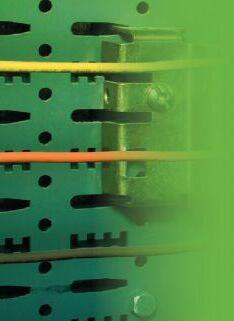
Today, we have high rates of retirement that can’t be replaced by the natural eld experience training we had in the past.
At 1:15 AM two weeks later, Jim stood on the factory floor with breakers lined up for testing. He wiped the sweat off of his brow, took a deep breath, and determined that things were going to get worse before they got better unless he made some changes.
He headed into the office and started one of the best projects to help the company: He assembled an aggressive training program. He acknowledged his shortfalls and the fact he was going to lose expertise faster than it could be generated through traditional means, and he developed an alternative program.
He researched and mapped out some key points:
1. Current and future market demands and the required manpower to accomplish this work:
a) Lead test person
b) Lead mechanical person
c) Laborer
2. He looked at the trends of workflow, typical scheduled outages, frequency, and required manpower.
3. He set up an outline of the ideal number of workers that would be needed and the level of expertise that would be required.
4. He did some industry research and determined the impact of worker retirement and worker turnover.
5. He put the numbers together and determined the best scenario he could create to make the program work and combat the reality they faced.
Next, he called a meeting with Otto, Vice President of Operations, and Karen, President. The meeting started out with an interesting approach. He explained he had mapped out the direction they were heading with work steadily increasing and expertise steadily decreasing. He explained that the traditional learning-by-doing couldn’t keep up with this pace. He jumped to the bottom line when he said, “And I need $90,000 over the next 6 months to turn this around.” Karen’s left eyebrow slowly lifted, and Otto cleared his throat and asked for some explanation on why this money was needed and what was going to be accomplished.
Jim had their attention and began to walk through what this investment would do.
1. We will send the three technicians in their last year of apprenticeship to two weeks of training on breaker testing and services.
2. We will send three of our senior technicians to two weeks of relay testing (currently only three of the seven have this expertise).
3. We will purchase a variety of used breakers and relays and set up a test training station in the shop. He explained that 25% of the time 25% of their crews are unapplied. With this investment, every available minute would be used to aggressively have our experienced techs train our less experienced techs. This training would be proactively scheduled, performed, and recorded, and everyone would be tested for expertise.
4. We will send two of our senior techs and two of our newbie techs to transformer maintenance training, levels 1–3.
5. Everyone who attends formal training will work with Cindi to walk through our current SOPs and make sure all are up to date. We will create quarterly refreshers on all SOPs for every technician.
14 | TRAINING TALK | A NETA WORLD JOURNAL SPECIAL PUBLICATION
6. Most important — and it’s included in the $90,000 budget — unscheduled crews will be sent to jobs that would further their training goals. They will shadow the experts and perform work under the direction of the senior technicians.
7. The $90,000 budget is for the first year and includes the purchase of used equipment. Jim estimated that a continual and aggressive training program would average about $25,000 per year thereafter.
Jim showed Otto and Karen the various training programs he wanted to use for the specialized training, walked through each technician, and explained which technicians would best be sent to the various training options.
When he finished, he added one more key summary they needed to hear before discussion opened. He explained that, on average:
■ A fully trained technician would provide:
a) Additional adders on site because he will see other problems outside the scope.
b) Scheduling flexibility because if the tech can handle whatever opportunities pop up, then additional work will be quoted, won, and performed.
c) The unplanned loss of a technician due to attrition will have reduced impact.
d) The quality and margin on field jobs will increase due to expertise and efficiency.
■ The company’s preventive maintenance inspection business could grow with the increased expertise, and it was a great business to fill in openings between key jobs
■ Jim would find himself in the steel mill wiping his brow at 1:15 AM a lot less often.

e most ine cient method of training is during a normal eld job.

“Any questions?” he asked. Otto smiled, and Karen said, “Let’s do it; we should have started years ago.”
CONCLUSION
The most inefficient method of training is during a normal field job. When techs have to work a 12hour day, there are endless trips to the truck, splitting up the work between the two techs, the senior tech having to do the high-tech work, and traveling between jobs… you get the point. You have to take a step back, evaluate what you want, where you are, and how you are going to close the gap.
Because of the strong need for advanced technical training, the market has responded, and fantastic training is available. The more we train, the more secure and profitable our services businesses will be. We are losing expertise faster than we can create it, and we need outside help from training experts. If you think about it, this is an exciting time for our business, and our growth over the last 36 months has been fantastic. Let’s match that with the growth of our expertise and provide more opportunities for our field crews.
CHUCK BAKER is the General Manager of the SDMyers Electric IQ Division, which offers a variety of training courses related to transformer maintenance. Chuck entered the world of substation and power maintenance 36 years ago and has spent a majority of that career on the operations side of power and distribution system maintenance and the development of power system maintenance programs.
A NETA WORLD JOURNAL SPECIAL PUBLICATION | TRAINING TALK | 15
COMPUTER-BASED PLEASE STEP INSIDE
BY JAMES R. WHITE , Shermco Industries
How does computer-based training (CBT) fit into the training plan?
CBT includes video tape, YouTube or anything like it, computer interactive programs, and satellite training. The advantages of CBT are obvious: lower per-person cost, ability to train whenever employees are available, more employees can participate, and ease of running CBT. All these make CBT desirable.
Using CBT poses several problems, however:
■ It has been proven to be the least effective methodology, which is why NFPA 70E has not approved of it in past editions.

Use of computer-based training by itself would not be su cient to meet the intent of most of OSHA’s training requirements.
■ Initial costs to develop interactive training can be quite high.
■ OSHA does not accept CBT for initial training where employees have high-risk tasks.
Back when nuclear power stations were first coming on line, I taught at several (36, in fact). I noted they all had extensive video training libraries. I asked one training manager why they would bring me in if they had such an extensive video library. He answered that they had found video training was okay for refresher training or sometimes basic training, but it was inadequate for technical training. They could only bring in an outside trainer once; then they had to do the training in-house. I was also told that the Nuclear Regulatory Commission (NRC) would not approve of CBT as the only method. The impression I got from my conversations was that the video tapes mostly sat on the shelf.
OSHA’s Letter of Interpretation dated November 22, 1994, states:
Question 1. What is OSHA’s position on computerbased training programs for cognitive training?
Answer: In OSHA’s view, self-paced, interactive, computer-based training can serve as a valuable training tool in the context of an overall training program. However, use of computer-based training by itself would not be sufficient to meet the intent of most of OSHA’s training requirements, in particular those of HAZWOPER. Our position on this matter is essentially the same as our policy on the use of training videos, since the two approaches have similar shortcomings. OSHA urges employers to be wary of relying solely on generic, “packaged” training programs in meeting their training requirements. For example, training under HAZWOPER includes site-specific elements and should also, to some degree, be tailored to workers’ assigned duties.
Safety and health training involves the presentation of technical material to audiences that typically have not had formal education in technical or scientific disciplines, such as in areas of chemistry or physiology. In an effective training program, it is critical that trainees have the opportunity to ask questions where material is unfamiliar to them. In a computerbased program, this requirement may be providing a
16 | TRAINING TALK | A NETA WORLD JOURNAL SPECIAL PUBLICATION
telephone hotline so that trainees will have direct access to a qualified trainer.
Equally important is the use of hands-on training and exercises to provide trainees with an opportunity to become familiar with equipment and safe practices in a non-hazardous setting. Many industrial operations, and in particular hazardous waste operations, can involve many complex and hazardous tasks. It is imperative that employees be able to perform such tasks safely. Traditional, hands-on training is the preferred method to ensure that workers are prepared to safely perform these tasks. The purpose of hands-on training, for example in the donning and doffing of personal protective equipment, is two-fold: first, to ensure that workers have an opportunity to learn by experience, and second, to assess whether workers have mastered the necessary skills. It is unlikely that sole reliance on a computer-based training program is likely to achieve these objectives.
Thus, OSHA believes that computer-based training programs can be used as part of an effective safety and health training program to satisfy OSHA training requirements, provided that the program is supplemented by the opportunity for trainees to ask questions of a qualified trainer, and provides trainees with sufficient hands-on experience.
OSHA’s LOI applies not only to hazardous waste operations and emergency response (HAZWOPER) workers, but to all workers who face the types of hazards and risk that can cause serious injury or death. Essentially, it says that initial training must have an instructor to answer questions directly and perform hands-on lab sessions, such as doffing and donning PPE. CBT is not prohibited by OSHA; it can be used to augment refresh training.
NFPA 70E states in Section 110.2(A)(4):
Δ (4) Type of Training. The training required by 110.2(A) shall be classroom, on-the-job, or a combination of the two. The type and extent of the training provided shall be determined by the risk to the employee.
The triangle indicates a new section was added to the 2018 edition. NFPA 70E agrees with the OSHA LOI that CBT can be used for refresher training, but
if you review the requirements for initial training in 110.2, it should be readily apparent that these requirements cannot be achieved by CBT.
Years ago, I was part of a team that looked at satellite training, which seemed to meet all of OSHA’s requirements. The problem was that the equipment to conduct such training was so expensive only community colleges were able to implement it, and it was therefore available to only a small group of community colleges that had this equipment. On the plus side, the instructor could present almost any hands-on subject by providing students with the equipment in front of them and the instructor performing hands-on exercises over video. He could also solicit and answer questions immediately. Very neat and effective, but also very expensive, and I’m not certain whether it is used any more. An alternative available today is web-based training, where interaction is also possible.
If a technician knows he has to perform a test he hasn’t done in a while, he can quickly bring himself up to speed on his cell phone.

Our company conducts hands-on, instructor-led initial training. For refresher training, we use a dedicated YouTube channel so our technicians can get training and company updates as well as a quick refresher for a test they may not have done. This over-the-air (OTA) type of training adds a new depth to the training experience. If a technician knows he has to perform a test he hasn’t done in a while, he can quickly bring himself up to speed on his cell phone. Each week, a new safety program is offered to all technicians, and they are encouraged to get together and discuss it with each other and their supervisors. If there is an incident, all employees are notified and warned about what they
A NETA WORLD JOURNAL SPECIAL PUBLICATION | TRAINING TALK | 17
should or should not do to avoid a repeat. Technical issues are also addressed, such as problems we have found with the installation of underground cables at wind-generation sites.
The list of uses goes on, and we are discovering ways to increase the effectiveness of our technicians. Yes, initial training for electrical technicians should almost always be instructor-led. Questions are going to be asked and need to be answered, as OSHA implies, “immediately.” One thing to keep in mind is that retraining — not refresher training — is required by NFPA 70E every three years. Refresher training can occur any time between those three-year intervals, but every three years,

technicians must receive training that allows them to ask questions and get them answered. That is difficult using CBT.
CONCLUSION
Training is not just optional or something to get behind you. It’s an important part of keeping technicians safe and growing their expertise. Of course, it is not the only part. Good procedures, safe work practices, and the ability to get technicians involved in the process all enhance worker safety. Be certain you provide effective training that meets both OSHA regulations and NFPA 70E standards.
JAMES (JIM) R. WHITE, Vice President of Training Services, has worked for Shermco Industries Inc. since 2001. He is a NFPA Certified Electrical Safety Compliance Professional and a NETA Level 4 Senior Technician. Jim is NETA’s principal member on NFPA Technical Committee NFPA 70E®, Standard for Electrical Safety in the Workplace®, NETA’s principal representative on National Electrical Code® Code-Making Panel (CMP) 13, and represents NETA on ASTM International Technical Committee F18, Electrical Protective Equipment for Workers. Jim is Shermco Industries’ principal member on NFPA Technical Committee for NFPA 70B, Recommended Practice for Electrical Equipment Maintenance and represents AWEA on the ANSI/ISEA Standard 203 Secondary Single-Use Flame Resistant Protective Clothing for Use Over Primary Flame Resistant Protective Clothing. An IEEE Senior Member, Jim received the IEEE/IAS/PCIC Electrical Safety Excellence Award in 2011 and NETA’s Outstanding Achievement Award in 2013. Jim was Chairman of the IEEE Electrical Safety Workshop in 2008 and is currently Vice-Chair for the IEEE IAS/PCIC Safety Subcommittee.
18 | TRAINING TALK | A NETA WORLD JOURNAL SPECIAL PUBLICATION
AVO Training Institute: The One Stop for Electrical Safety and Maintenance Training
If it’s electrical, AVO Training is focused on it. Electrical safety and maintenance training is not just part of our offering, it’s our sole focus. That’s why we offer more electrical training courses than any other training facility. Our training is available as hands-on at any one of our 12 training facilities throughout the U.S. or online through live virtual instructor-led training or self-paced learning.
Live Virtual Online Training Courses: www.avotraining.com/virtual
• NFPA 70E 2018 – 2-Day
• National Electrical Code Changes 2020 – 2-Day
• Electrical Safety for Industrial Facilities – 4-Day
• Electrical Safety for Utilities – 4-Day
Self-paced Online Training Courses: www.avotraining.com/online
• Arc Flash Online Safety Awareness Training
• Changes to the National Electrical Code
Hands-on Training Courses: www.avotraining.com/handson
Electrical Maintenance
• Substation 1 & 2
• Protective Relay (Basic & Advanced)
• Cable (Splicing & Terminating, Fault Location & Tracing, Testing & Diagnostics)
• Circuit Breaker (Low-Voltage, Medium-Voltage, Molded & Insulated Case, SF6)
• Transformer (Basic & Advanced)
• Motors (Motor Maintenance & Testing, Motor Controls & Starters)
• Microprocessor-Based Relay Testing (Generation, Feeder, Transformer)
• Battery Maintenance & Testing
Electrical Maintenance, cont.
• Power Factor Testing
• Grounding & Bonding
• Power Quality & Harmonics
• Programmable Logic Controllers, Maintenance & Troubleshooting
• Protective Device (For Industry & For Utilities)
• Short Circuit Analysis
• Protective Relay Maintenance (Generation & Solid-State)
• Infrared Thermography 1 & 2
• Advanced Visual Testing Software
• Energized Overhead Contact System Line Safety
Electrical Safety
• NFPA 70E 2018
• Electrical Safety for Industrial Facilities
• Electrical Safety for Utilities
• Electrical Safety for Inspectors
• Electrical Safety for Mining
• Electrical Safety for Overhead Contact Systems
• National Electrical Code 2020
• National Electrical Code Changes 2020
• OSHA Electrical Safety-Related Work Practices
• OHSA Generation, Transmission and Distribution
• Maritime Electrical Safety
Electrical Fundamentals
• Basic Electrical Troubleshooting
• Basic Electricity
• Electronics for Electricians
• Electrical Print Reading – ANSI
• Electronics Troubleshooting

WWW.AVOTRAINING.COM • 877-594-3156 *NETA continuing technical development (CTDs) units are required of NETA Certified Technicians. AVO Training Institute is accredited by the International Association for Continuing Education and Training (IACET) and is accredited to issue the IACET CEU.
DIRECTORY OF TECHNICAL AND PROFESSIONAL TRAINING

An Engineer’s Playground
“Icameinwithlittleexposuretoindustrypracticesandnow feelverycomfortable/competentwiththe standardproceduresaswellasrecommendedsafety measuresduringmaintenance.”
-N.
Mitchell, Electrical Diagnostic Testing of Power Transformers class participant
Excellence Through Education
Many people refer to the OMICRON Academy in Houston as “An Engineer’s Playground.” This is because in addition to classrooms, we also have a state-of-the art indoor substation with a variety of apparatus to perform hands-on testing including transformers, circuit breakers, protective relays, indoor circuit, PD testing area and our recently installed distribution automation wall.
Training Topics
•Protection Relays and Meters Testing
•Circuit Breaker/Switchgear Testing
•Instrument Transformer Testing
•Power Transformer Testing & Diagnostics
•Partial Discharge Testing
•Protection Theory
•End-to-End Testing
•Reclosers and Distribution Automation
See our full list of courses at omicronenergy.com/na-training
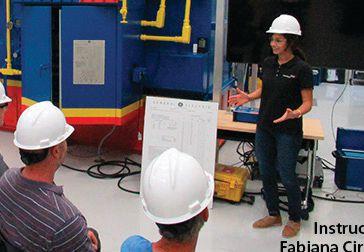

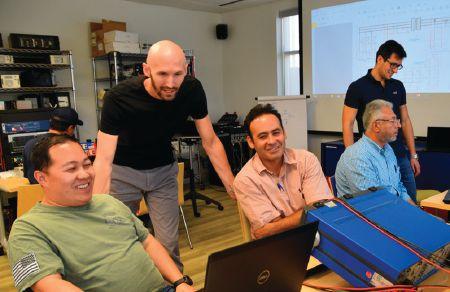

Megger’s Testing Tactics Webinar Series 2020
Learn valuable testing tips and tricks from Megger application engineers and product managers. In this webinar series, our experienced staff will show you how to make your testing more efficient by sharing their lessons learned in the field. You will find answers to frequently asked questions, learn how to avoid the most common mistakes, and accelerate your testing.
Upcoming Webinars
• An Insight into End to End Testing Philosophy
May 22, 2020 | Presenter: Sughosh Kuber
• Off-line Partial Discharge Testing of Rotating Machines
June 19, 2020 | Presenter: Charles Nybeck
• Feeder Protection in Power Distribution Systems
July 17, 2020 | Presenter: Abel Gonzalez
• Narrow Band Dielectric Frequency Response –Application on HV and EHV OIP Bushings
August 21, 2020 | Presenter: Diego Robalino
• MV and HV Circuit Breaker Testing beyond Timing and Travel Measurements
September 18, 2020 | Presenter: Volney Naranjo
• State-of-the-Art Diagnostics Technologies for Proactive Cable Condition Assessment
October 23, 2020 | Presenter: Robert Probst
• Fundamentals of Motor Protection
November 20, 2020 | Presenter: David Beard
• LV Circuit Breaker Ground Fault Protection Utilizing Primary Injection Test Method
December 18, 2020 | Presenter: Daniel Carreno
Previous
Webinars
• Best Field Practices for Testing Instrument Transformers: CTs, VTs, CVTs
November 15, 2019 | Presenter: Daniel Carreno
• Tan Delta Testing on Medium Voltage Cables
December 20, 2019 | Presenter: Javier Ruiz
• Fundamentals of Partial Discharge Measurements
January 24, 2020 | Presenter: Charles Nybeck

• DC Insulation Resistance Testing: Effective Use of Guard Terminal
February 21, 2020 | Presenter: Nick Rees
• Understanding Sweep Frequency Response Analysis and Best Field Practices
March 20, 2020 | Presenter: Sanket Bolar
• MV and HV Cable Fault Location Utilizing ARM Method
April 17, 2020 | Presenter: Javier Ruiz
How to Join Megger Webinar Series
• Megger Webinars are held on the 3rd Friday of every month.
• Time: 10:00 AM Central Time
• Sessions are FREE
• Earn 1 NETA CTD and 1 PDH or 0.1 CEU
• us.megger.com/webinars
Earn Credits
Megger has partnered with NETA (InterNational Electrical Testing Association) in North America to present Testing Tactics, a special monthly webinar series that allows webinar registrants to receive NETA CTDs (Continuing Technical Development Credits) for attending the live webinar.
• Only attendees of the live Testing Tactics webinar sessions are eligible to receive 1 NETA CTD (Continuing Technical Development Credit) and 0.1 CEU (Continuing Education Units) or 1 PDH (Professional Development Hour) for each webinar attended.
• Live attendees of the webinar will also receive a PDF copy of the PowerPoint presentation.
Webinar Registration:
us.megger.com/webinars
Megger designs and manufactures portable electrical test equipment. Megger products help you install, improve efficiency, reduce cost, and extend the life of your customers’ electrical assets or your own. For more information, visit us.megger.com.
DIRECTORY OF TECHNICAL AND PROFESSIONAL TRAINING
Shermco Industries: Your Electrical Safety Experts
Shermco is a leader in electrical power systems maintenance, repair, and testing, and for years, we have trained others in those skills. Offering onsite, classroom, and hands-on training, Shermco conducts a wide variety of courses covering Electrical Systems Maintenance, Electrical Safety, and Electrical Technical Skills. Some of the most influential leaders in electrical safety work at Shermco Industries, and now you have direct access to that experience and expertise! Shermco offers technical and electrical safety programs year-round and at multiple locations in the U.S. and Canada. NETA CTDs and CEUs through IEEE are available for most courses where applicable. Train with the experts. Train with Shermco.
Shermco University
Distance Learning Courses
• Electrical Safety Refresher
• Electrical Safety for Qualified Electrical Workers
• Electrical Safety for Managers
• Electrical Safety for Non-Electrical Personnel
• Electrical Safety for Utilities
• National Electrical Code
• Company Custom Courses
How Does Distance Learning Work?
Teleconference courses are taught face-to-face and allow live interaction between instructor and students even though they may be in different geographic locations. Synchronous tools such as text chat, audio chat, or video chat will provide students with real-time access to the instructor while the class is in session.
Class size limited to twenty (20) participants.
Call and reserve your seat today.

Enroll today by visiting www.shermco.com/training or call 888-Shermco.
For more information, to download our current course catalog, or to register online, go to www.shermco.com/training or email trainingservices@shermco.com SHERMCO.COM • 888-SHERMCO

DIRECTORY OF TECHNICAL AND PROFESSIONAL TRAINING
CEUs available from

OMICRON invites you to join our classes on Protection Testing, Digital Substations, Transformer Testing, Circuit Breakers, and more in our new on-line interactive training events or in-person at the OMICRON Academy in Houston.








Benefit from professional courses with expert trainers, full-scale training equipment, e ective methodology and excellent customer care. Then, try what you have learned in the classroom with some practical testing at our indoor substation, and hands-on relay test lab.
Find your new on-line training event at omicron.energy/na-events
Find additional training at omicronenergy.com/na-training



































































































 Eugenio Carvalheira Secondary Engineering Services Manager
Eugenio Carvalheira Secondary Engineering Services Manager
To be the best in your field, train with the best in the field. Shermco Real-World Training. www.shermco.com/training
OMICRON Academy: An Engineer’s Playground



MARCH 8 – 12, 2021 ROSEN SHINGLE CREEK ORLANDO, FLORIDA POWERTEST.ORG 888.300.6382 SAVE THE DATE THE PREMIER ELECTRICAL MAINTENANCE AND SAFETY CONFERENCE HOSTED BY
COVER STORY
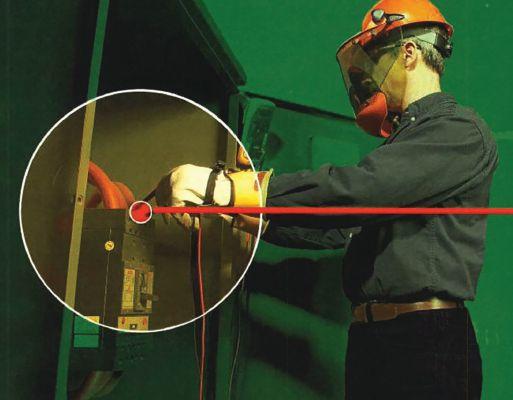
Using NFPA 70E to Determine Shock and Arc Flash Boundaries
For electrical workers, avoiding shock and arc flash is paramount. NFPA 70E provides the information required to determine the risk involved in a task, how to choose the appropriate PPE, and how to perform the task safely. The 2018 edition of NFPA 70E is still active, even though we are looking forward to a new 2021 edition. However, electrical safety is an on-going project; much is learned every year. Similar to the National Electrical Code, NFPA 70E may never be finished. As it enters more of a maintenance phase, the committee has focused on making 70E easier for the average technician to use and apply without needing interpretation.
James R. White, Shermco Industries
FEATURES
7 President’s Desk
Scott Blizard, American Electrical Testing Co., LLC NETA President
48 Beliefs Drive Behaviors
D. Ray Crow, DRC Consulting, Ltd., and Danny P. Liggett, DuPont de Nemours Inc.
58 Energy Storage Systems: Hazards and Solutions
Brian O’Connor, National Fire Protection Association
66
Arc Flash Maintenance: Not All Equipment is Created Equal
Kerry Heid, Shermco Industries
72 Human Performance in Electrical Safety: Where the Rubber Hits the Road
Mike Doherty, eHazard
TABLE OF CONTENTS TABLE OF CONTENTS NETAWORLD • 3
38
SUMMER 2020 · VOLUME 42,
2 COVER IMAGE COURTESY OF SHERMCO INDUSTRIES
NO.
10 NFPA 70E and NETA
The Key to Understanding NFPA 70E
Ron Widup and James R. White, Shermco Industries
14 Relay Column
Archiving Protective Relay Settings
Steve Turner, Arizona Public Service Company
18 In the Field
The Pool is Empty!
Don Genutis, Halco Testing Services
22 Safety Corner
Limiting Arc Flash Exposure on Low-Voltage Systems
Scott Blizard, American Electrical Testing Co., LLC
28 Tech Quiz
Safety First, Last, and Always
James R. White, Shermco Industries
32 Tech Tips
Tracing Ground Leakage with a Clamp-On Meter
Jeff Jowett, Megger
78 Best Practices for Safe Return to Service Following Maintenance Outage
Charles M. McClung, retired, and Russell R. Safreed, CBS ArcSafe
NETA
Capitol Area Testing Recognized as NETA Accredited Company
NETA Welcomes Hood Patterson & Dewar as NETA Accredited Company
PowerSouth Testing Achieves NETA Accredited Company Status
NETA’s PowerTest 2020 Sparks Innovation and Achievement
Outstanding Achievement Award: Ron Widup, Shermco Industries
Alliance Recognition Award: Nick Perjanik, Weidmann Electrical Technology Inc.
Testing and Commissioning Digital Protective Relays
Drew Welton, intellirent
4 • SUMMER 2020 TABLE OF CONTENTS TABLE OF CONTENTS IN EVERY ISSUE
INDUSTRY TOPICS
ADVANCEMENTS IN THE INDUSTRY
84
INSIGHTS & OBSERVATIONS — NETA CAP SPOTLIGHT 92 intellirent:
Training, Support SPECIFICATIONS AND STANDARDS 94 ANSI/NETA Standards Update 97 NFPA
Logistics,
70B Committee Report
David Huffman, Power Systems Testing Company
99
103
106
110
113
IMPORTANT
116 NETA
122 Advertiser List
NEWS
101
LISTS
Accredited Companies

National Headquarters - Dallas 1517 West Carrier Pkwy Suite 116 Grand Prairie, TX 75050
Los Angeles 2935 E Ricker Way Anaheim, CA 92806
Reno-Tahoe 924 Greg Street Sparks, NV 89431
Denver 12050 E 45th Ave, Unit 400 Denver, CO 80239
Houston
14251 Gulfstream Park Dr Webster, TX 77598












Chicago 1501 Wright Blvd Schaumburg, IL 60193
Atlanta 880 Veterans Memorial Hwy Mableton, GA 30126
New York City 70 Triangle Blvd Carlstadt, NJ 07072
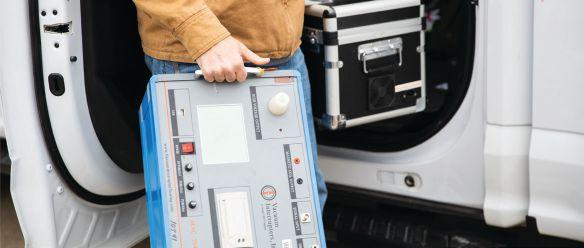














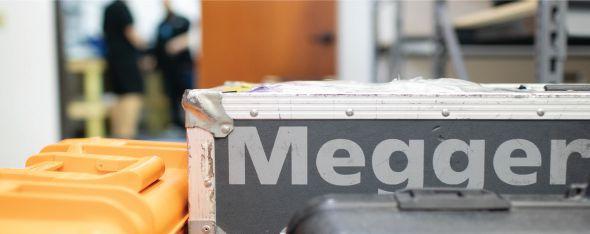

t 866-352-5550 The Electrical Test Equipment Rental Experts
Full-Service Asset Management The number one choice for mission critical equipment where time, quality & service are vital. Accurate & Affordable Calibration We Put the Power in Your Hands Nationwide



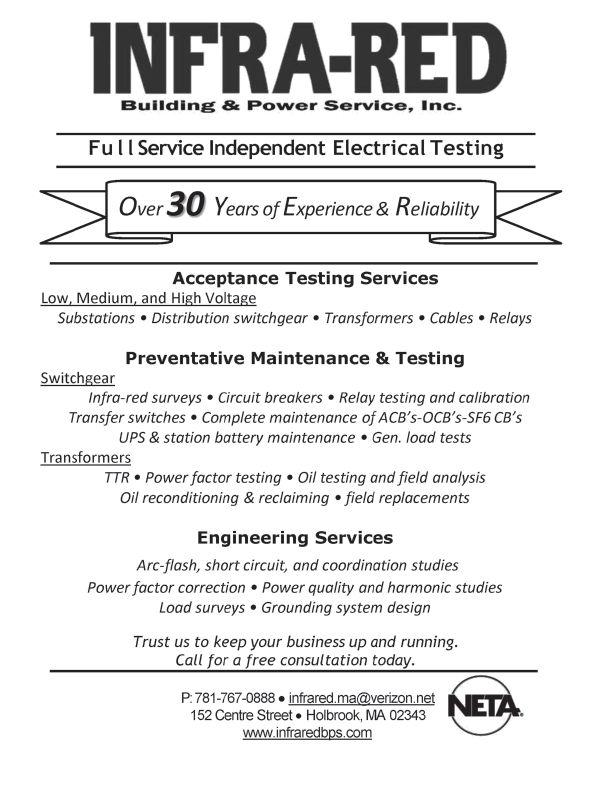
3050 Old Centre Road, Suite 101
Portage, MI 49024
Toll free: 888.300.NETA (6382)
Phone: 269.488.NETA (6382)
Fax : 269.488.6383
neta@netaworld.org
www.netaworld.org
executive DiRectOR: Missy Richard
NETA Officers
pResiDent: Scott Blizard, American Electrical Testing Co., Inc.
secOnD vice pResiDent: Eric Beckman, National Field Services
secRetaRy: Scott Dude, Dude Electrical Testing, LLC
tReasuReR: John White, Sigma Six Solutions, Inc.
NETA Board of Directors
Ken Bassett (Potomac Testing, Inc.)
Eric Beckman (National Field Services)
Scott Blizard (American Electrical Testing Co., Inc.)
Jim Cialdea (CE Power Engineered Services, LLC)
Scott Dude (Dude Electrical Testing LLC)
Dan Hook (Western Electrical Services, Inc.)
David Huffman (Power Systems Testing)
Alan Peterson (Utility Service Corporation)
Chasen Tedder, Hampton Tedder Technical Services
John White (Sigma Six Solutions)
Ron Widup (Shermco Industries)
NETA World Staff
technicaL eDitORs: Roderic L. Hageman, Tim Cotter
assistant technicaL eDitORs: Jim Cialdea, Dan Hook, Dave Huffman, Bob Sheppard
assOciate eDitOR: Resa Pickel
managing eDitOR: Carla Kalogeridis
cOpy eDitOR: Beverly Sturtevant
aDveRtising manageR: Laura McDonald
Design anD pRODuctiOn: Moon Design
NETA Committee Chairs
cOnfeRence: Ron Widup; membeRship: Ken Bassett; pROmOtiOns/maRketing: Scott Blizard; safety: Scott Blizard and Jim White; technicaL: Alan Peterson; technicaL exam: Dan Hook; cOntinuing technicaL DeveLOpment: David Huffman; tRaining: Eric Beckman; finance: John White; nOminatiOns: Alan Peterson; aLLiance pROgRam: Jim Cialdea; assOciatiOn DeveLOpment: Ken Bassett and John White
© Copyright 2020, NETA
NOTICE AND DISCLAIMER
NETA World is published quarterly by the InterNational Electrical Testing Association. Opinions, views and conclusions expressed in articles herein are those of the authors and not necessarily those of NETA. Publication herein does not constitute or imply endorsement of any opinion, product, or service by NETA, its directors, officers, members, employees or agents (herein “NETA”).
All technical data in this publication reflects the experience of individuals using specific tools, products, equipment and components under specific conditions and circumstances which may or may not be fully reported and over which NETA has neither exercised nor reserved control. Such data has not been independently tested or otherwise verified by NETA.
NETA MAKES NO ENDORSEMENT, REPRESENTATION OR WARRANTY AS TO ANY OPINION, PRODUCT OR SERVICE REFERENCED OR ADVERTISED IN THIS PUBLICATION. NETA EXPRESSLY DISCLAIMS ANY AND ALL LIABILITY TO ANY CONSUMER, PURCHASER OR ANY OTHER PERSON USING ANY PRODUCT OR SERVICE REFERENCED OR ADVERTISED HEREIN FOR ANY INJURIES OR DAMAGES OF ANY KIND WHATSOEVER, INCLUDING, BUT NOT LIMITED TO ANY CONSEQUENTIAL, PUNITIVE, SPECIAL, INCIDENTAL, DIRECT OR INDIRECT DAMAGES. NETA FURTHER DISCLAIMS ANY AND ALL WARRANTIES, EXPRESS OF IMPLIED, INCLUDING, BUT NOT LIMITED TO, ANY IMPLIED WARRANTY OF FITNESS FOR A PARTICULAR PURPOSE.
ELECTRICAL TESTING SHALL BE PERFORMED ONLY BY TRAINED ELECTRICAL PERSONNEL AND SHALL BE SUPERVISED BY NETA CERTIFIED TECHNICIANS/ LEVEL III OR IV OR BY NICET CERTIFIED TECHNICIANS IN ELECTRICAL TESTING TECHNOLOGY/LEVEL III OR IV. FAILURE TO ADHERE TO ADEQUATE TRAINING, SAFETY REQUIREMENTS, AND APPLICABLE PROCEDURES MAY RESULT IN LOSS OF PRODUCTION, CATASTROPHIC EQUIPMENT FAILURE, SERIOUS INJURY OR DEATH.

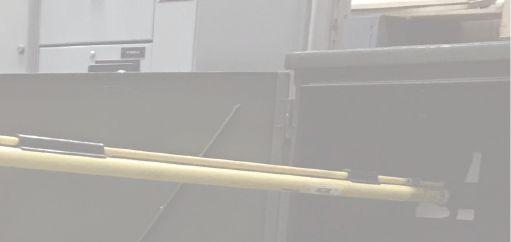
FIGHT COVID-19 WITH PPE
It was great seeing everyone at PowerTest 2020 in Chicago! On behalf of the NETA Board of Directors, we thank our sponsors, Corporate Alliance Partners, and trade show vendors, and applaud the hard work and dedication of the NETA Staff who help make PowerTest successful.
In this NETA World, we look at NFPA 70E‐2018 requirements for labeling electrical equipment for arc flash and shock protection, specifically personal protective equipment (PPE) selection. Shock protection boundaries are fairly straightforward and can be determined from the appropriate tables. The arc flash boundary and PPE required to work inside that boundary while there is exposed energized equipment are more complex.
Be sure to read Jim White’s article, “Using NFPA 70E to Determine Shock and Arc Flash Boundaries.” It was a true pleasure to see Jim and his wife Vicki at PowerTest 2020.
As I write this, the country is the middle of the COVID‐19 virus pandemic. NETA Member Companies and their technicians throughout the United States and in Canada have been identified as essential workers to support and maintain the critical infrastructure of our nations. Our NETA Technicians are also on the front lines of this fight. They must do their best to stay healthy and help contain the spread of COVID-19 by following CDC guidelines in the United States and Public Health Agency’s guidelines in Canada.
Using PPE can help prevent the spread of illnesses like the common cold, hepatitis, and influenza, as well as SARS‐Cov2 (COVID-19). In many cases, PPE is not designed or intended to be shared among employees. To safely share or re‐issue certain types of PPE, a company must follow manufacturer and OSHA cleaning, sanitizing, and tracking procedures. Employees should also be trained to properly clean and maintain their individually issued PPE.
Follow your company and customers’ policies for the COVID‐19 pandemic. The policy should include many of the preventative measures communicated by the CDC and the Public Health Agency of Canada. Be safe and err on the side of caution.
Mark your calendar: PowerTest 2021, the premier electrical maintenance and safety conference, will take place March 8–12, 2021, at the Rosen Shingle Creek in Orlando, Florida. We look forward to seeing you there.
Coach safe behavior … Living injury and disease free every day!
 Scott A. Blizard, President International Electrical Testing Association
Scott A. Blizard, President International Electrical Testing Association
Safety First…No One Gets Hurt!
PRESIDENT’S DESK

PRESIDENT’S DESK
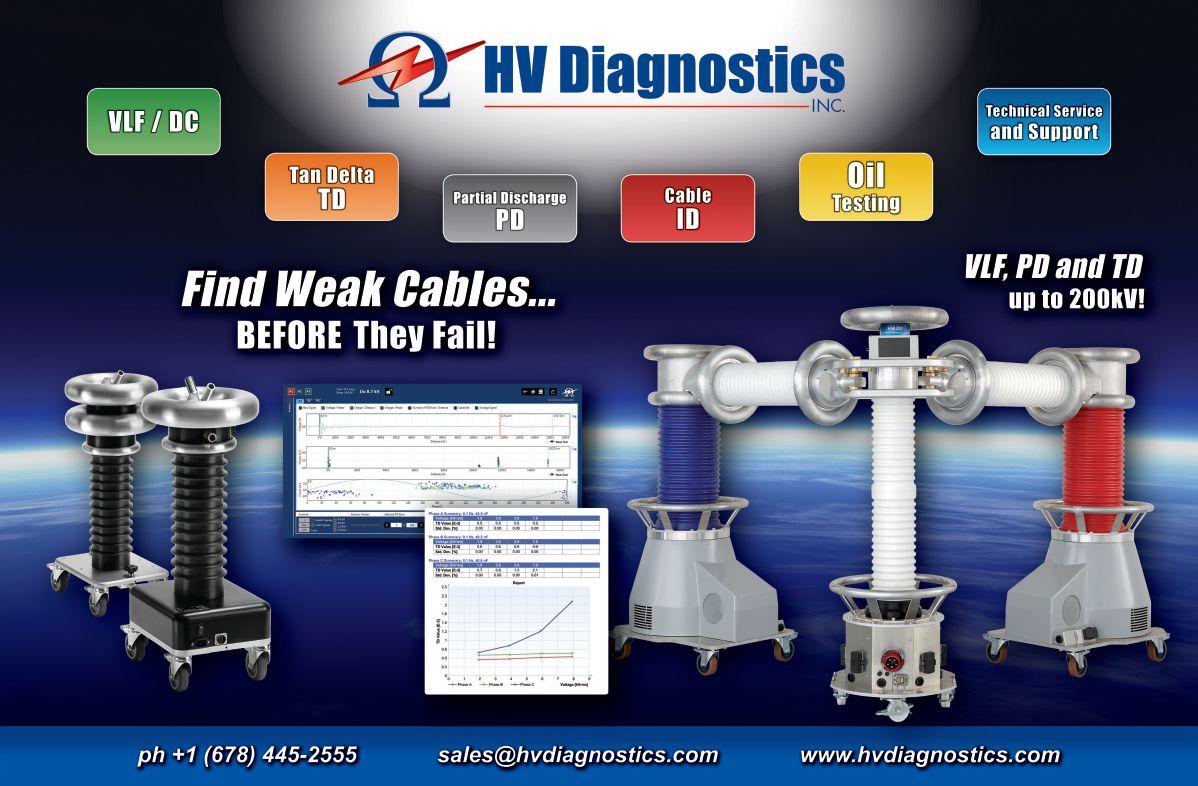

•
•
•
Rely

Superior Service for Optimal Performance
learn more, visit ERS.Vertiv.com or call 877-468-6384 Experts Available Across Six Centers of Excellence: Commissioning | Electrical Engineering | DC Power Testing and Maintenance | Protection and Controls | Compliance Vertiv™ and the Vertiv logo are trademarks or registered trademarks of Vertiv Group Corp. All other names and logos referred to are trade names, trademarks or registered trademarks of their respective owners.
To
services, ongoing maintenance,
emergency
need a partner you can trust.
Whether you need startup
or
response you
responsiveness,
safety.
on Vertiv’s Electrical Reliability Services’ team for expertise,
and
Consistent quality, service-delivery process
Proactive customer communication and project management
National, regional, and local service center availability
TRAIN WITH THE EXPERTS
LIVE VIRTUAL ONLINE ELECTRICAL SAFETY TRAINING
Experience the same quality and engagement as our in-person, training courses while saving big on enrollment and travel costs. Our virtual training courses allow students to log-in remotely and fully participate in a live, instructor-led, online classroom setting.
Enroll in one of our pre-scheduled open enrollment virtual courses or if you have a group of employees that need training, ask about our virtual on-site training.
NFPA 70E® 2018 ELECTRICAL SAFETY (2-DAY)
NATIONAL ELECTRICAL CODE CHANGES 2020 (2-DAY)
NATIONAL ELECTRICAL CODE 2020 (4-DAY)
ELECTRICAL SAFETY FOR INDUSTRIAL FACILITIES (4-DAY)
ELECTRICAL SAFETY FOR UTILITIES (4-DAY)
NEW VIRTUAL COURSES COMING SOON
• SUBSTATION MAINTENANCE
• RELAY MAINTENANCE
• LOW-VOLTAGE CIRCUIT BREAKER

avotraining.com/virtual 877-594-3156 TRAINING INSTITUTE




THE KEY TO UNDERSTANDING

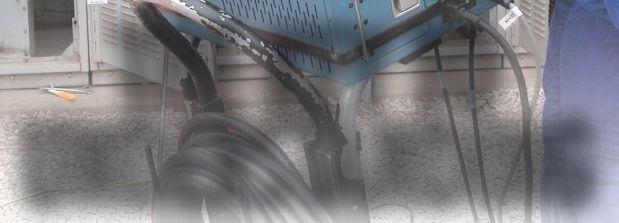

NFPA 70E
 BY RON WIDUP and JAMES R. WHITE, Shermco Industries
BY RON WIDUP and JAMES R. WHITE, Shermco Industries

The 2021 edition of the NFPA 70E is almost upon us. In June 2020, it should be approved at the technical meeting during the NFPA Conference and Expo, and the Standards Council will issue the standard soon thereafter, likely in August 2020. A pdf version of the standard will likely be released in September, with a printed copy available in late September or early October 2020.
Be aware: After the standard is approved by the Standards Council, the effective date will be set and goes into effect, even though you can’t purchase a copy until later. The effective date will likely be in August 2020, and the new 2021 edition will supersede all previous editions. Because this is a work practices document and not an installation code, previous standards are not grandfathered. You will need to comply with the 2021 edition after the effective date.
Once the edition is approved, a no-charge copy will online at www.nfpa.org/70e, but the free copy cannot be downloaded.
This will probably be the last cycle of major changes to NFPA 70E. For the last three cycles, the committee has tried to make 70E better organized and easier to understand for field technicians, and we have clarified sections or requirements that could be misinterpreted. Th e standard is now entering more like a maintenance phase where we will continue
10 • SUMMER 2020 THE KEY TO UNDERSTANDING NFPA 70E
NFPA 70E AND NETA
to improve it, but the huge reorganizations performed in the past are pretty much finished. The newest edition should be well-organized, easier to apply in the field, and hopefully more understandable to those it is intended for….the electrical worker.
As an example of the number of changes this cycle, the committee received 344 Public Inputs and created 85 First Revisions. For the second draft meeting, 115 Public Comments were submitted and 46 Second Revisions were created. This is quite a workload for the committee, as each Public Input and each Public Comment is discussed — revised if needed — and then balloted.
We always recommend that users of 70E review the definitions in Article 100 first. If the meaning of a word is not clear or users do not understand, it is very likely to be misapplied. That is exactly what we do not want to see happen, so the Committee reviews the definitions and tries to make them as clear as possible to the typical field worker.
Sometimes, the name of something we refer to evolves over time. One example is the term “sock hood.” Previous cycles used that phrase to clarify what was being discussed in the standard. In the 2021 edition, sock hood is no longer used; most people are familiar with a balaclava, so that’s the term that is now used. The standard constantly evolves to keep up with terminology and knowledge. A new Informational Note was added to the definition of a balaclava:
Informational Note: Some balaclava designs protect the neck and head area, except for the eyes, while others leave the eyes and nose area unprotected.
This note was added because different workers prefer different designs. Some choice is allowed so workers can be comfortable while they perform a task. The note also points out that some designs provide more protection than others.
Many of the definitions are taken directly from NFPA 70, National Electrical Code (NEC), although the committee has the authorization to modify a definition if needed. When the definition language is taken straight from the NEC, its wording is often slightly modified for use in 70E. For example, the definition for “Conductor, Covered” used to state:
A conductor encased within material of composition or thickness that is not recognized by this Code, as electrical insulation. [70:100].
NFPA 70E is a standard, not a code, so that definition and a number of other definitions were revised to state:
A conductor encased within material of composition or thickness that is not recognized by NFPA 70, National Electrical Code as electrical insulation. [70:100].
This clarifies where the definition originated and that 70E is not a code.
One important revision was made to the term “Electrically Safe Work Condition.” There was some issue that the definition was not in line with ANSI/AIHA Z10, which 70E referred to as part of the Hierarchy of Risk Control Methods. To clarify what the Committee intended, the Informational Note was revised to state:
Informational Note: An electrically safe work condition is not a procedure, it is a state wherein all hazardous electrical conductors or circuit parts to which a worker might be exposed are maintained in a zero-energy de-energized state for the purpose of temporarily eliminating electrical hazards for the period of time for which the state is maintained.
The committee statement explains:
Language is added to clarify that elimination is achieved by disconnecting and isolating from energy sources all electrical conductors or circuit parts to which a worker might be exposed in the area where work is to take place. Additionally, it
NETAWORLD • 11 THE KEY TO UNDERSTANDING NFPA 70E
NETA
NFPA 70E AND
is clarified that this de-energization is a temporary state and exists only during the period for which the electrically safe work condition state is maintained.
This brings up another important point for 70E users: They should take the time to go to the NFPA website and read the committee statements for all of the revisions, as the statements will clarify misunderstandings workers may have about the way a phrase or section is written. Most people will not take the time to do this and then wonder what it really means, or worse yet, they will read whatever they want into it. Both situations are unsafe.
Another Informational Note was added to the definition of “Fault Current, Available,” which we consider pretty important, and a third Informational Note was added to provide clarity:
Informational Note No. 3: The available fault current varies at different locations within the system due to the location of sources and system impedances.”
This clarifies that available fault current is not one single value, but can vary within the power system.
SUMMARY
Studying definitions is not the reason workers and supervisors use 70E, but the definitions set the foundation for everything that follows. Knowing what a word or term really means, instead of using your own personal definition, can make the difference between a safely performed task and an incident. The committee statements are another valuable source of information most people do not utilize. We are required to write a statement on every First or Second Revision we pass so the users of 70E have a better understanding of the intent. It’s easier to ask someone’s opinion, especially if they are considered an expert, but it is much better to gather the information yourself. You hear it a lot: Knowledge is Power.
Be safe out there.
Ron Widup and Jim White are NETA’s representatives to NFPA Technical Committee 70E, Electrical Safety Requirements for Employee Workplaces. Both gentlemen are employed by Shermco Industries in Dallas, Texas, a NETA Accredited Company.

Ron Widup, Senior Advisor, Technical Services and Vice Chairman of the Board of Directors, has been with Shermco Industries since 1983. He is a member of Technical Committee on NFPA 70E, Electrical Safety in the Workplace; a Principal Member of National Electrical Code (NFPA 70) Code Panel 11; a Principal Member of the Technical Committee on NFPA 790, Standard for Competency of Third-Party Evaluation Bodies; a Principal Member of the Technical Committee on NFPA 791, Recommended Practice and Procedures for Unlabeled Electrical Equipment Evaluation; a member of the Technical Committee on NFPA 70B, Recommended Practice for Electrical Equipment Maintenance, and Vice Chair for IEEE Std. 3007.3, Recommended Practice for Electrical Safety in Industrial and Commercial Power Systems. Ron also serves on NETA’s board of directors and Standards Review Council. He is a NETA Certified Level 4 Senior Test Technician, a State of Texas Journeyman Electrician, an IEEE Standards Association member, an Inspector Member of the International Association of Electrical Inspectors, and an NFPA Certified Electrical Safety Compliance Professional (CESCP).

James (Jim) R. White, Vice President of Training Services, has worked for Shermco Industries since 2001. He is a NFPA Certified Electrical Safety Compliance Professional and a NETA Level 4 Senior Technician. Jim is NETA’s principal member on NFPA Technical Committee NFPA 70E®, Electrical Safety in the Workplace; NETA’s principal representative on National Electrical Code® Code-Making Panel (CMP) 13; and represents NETA on ASTM International Technical Committee F18, Electrical Protective Equipment for Workers. Jim is Shermco Industries’ principal member on NFPA Technical Committee for NFPA 70B, Recommended Practice for Electrical Equipment Maintenance and represents AWEA on the ANSI/ISEA Standard 203, Secondary Single-Use Flame Resistant Protective Clothing for Use Over Primary Flame Resistant Protective Clothing. An IEEE Senior Member, Jim was Chairman of the IEEE Electrical Safety Workshop in 2008 and is currently Vice Chair for the IEEE IAS/PCIC Safety Subcommittee.
12 • SUMMER 2020
THE KEY TO UNDERSTANDING NFPA 70E
NFPA 70E AND NETA











ENGINEERING SERVICES • TECHNICAL SERVICES • COMMISSIONING Protection Systems Design, Electro-Mechanical & Microprocessor Relay Testing NCSCB Certified Cable Splicing, Cable Testing & Analysis using VLF, VLF-TAN Delta, and Partial Discharge Motor, Generator & Transformer Maintenance, Life Extension, Testing, Oil Handling & Leak Repairs Power Systems Repairs & Troubleshooting and Power Quality Audits (310) 816-3130 www.tdeinc.com 131 W F Street Wilmington, CA 90744 Los Angeles Area | | CA LICENSE #315448 C I ER Demaria Fami y QUALITY SERVICE! Safety / Technical / Custom Training Available MANY COURSES ARE ELIGIBLE TO EARN NETA CONTINUING TECHNICAL DEVELOPMENT CREDITS (CTDC’S) “Safety is 99.9% common sense...” Anthony F. Demaria Sr. “...when you are qualified.” Anthony F. Demaria Jr.
ARCHIVING PROTECTIVE RELAY SETTINGS
BY STEVE TURNER, Arizona Public Service Company
Electric utilities have vast numbers of protective relays in their fleets, including generation, transmission, and distribution systems. It is very important to maintain an accurate database that stores the actual inservice settings for each and every relay. Off-the-shelf software already exists for storing and keeping track of all relay settings (Figure 1). It is vital to download the relay settings while on site because — due to federal regulations — it is not practical or easy to maintain remote access to relays protecting the bulk electric system (BES). Access to this information is necessary to meet requirements such as NERC’s critical infrastructure protection (CIP) standard.
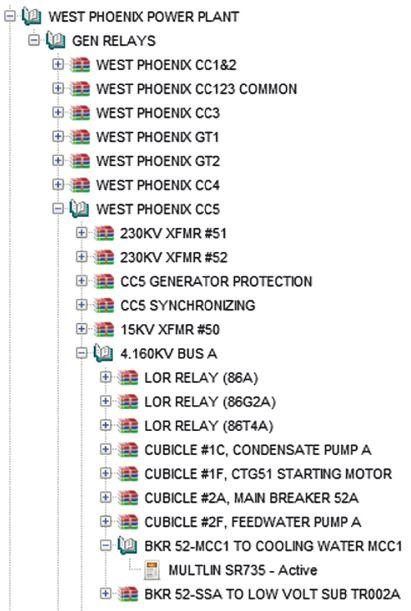
Figure 1: Relay Database
Actual in-service relay settings are needed to develop proper test routines for maintenance and construction projects, to analyze system events when a misoperation occurs, and to perform arc flash studies. Using incorrect settings for any of these tasks can lead to dire unwanted results.
TECHNOLOGY
Relay technology ranges from older electromechanical to modern numerical relays. Note that the term “microprocessor-based” does not always apply to numerical relays. Some static relays use microprocessors but operate on analog secondary voltage and/or current signals. Numerical relays, on the other hand, operate on digitized secondary signals.
One of the many advantages numerical relays provide is the ability to save the settings in a file by downloading them with communications software as shown in Figure 2. This is not possible for electromechanical relays.
14 • SUMMER 2020 ARCHIVING PROTECTIVE RELAY SETTINGS
RELAY COLUMN

Phase TOC 1
Function Trip
Input Phasor
Pickup 2.000 x CT
Curve ANSI Very Inverse
TDM 3.00
Reset Instantaneous
Voltage Restraint Disabled
Block Off
Relays Relay : Disabled
Events Enabled
Targets Latched
Figure 2: Numerical Overcurrent Relay Settings
AS-FOUND VERSUS AS-LEFT RELAY SETTINGS
As-found relay settings are the pre-existing settings stored in the relay found on site. As-left settings are settings left after changing settings as tasks such as testing are completed. The best practice is to save both sets of settings whenever any testing (for example, routine maintenance) is conducted or a setting is changed for whatever
reason. This method ensures an accurate history for each and every relay.
CONCLUSION
This article explains the importance of maintaining an accurate relay settings database. The actual on-site settings stored in the relay are necessary for developing test routines and conducting relay operation analysis.
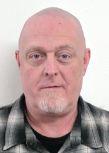
Steve Turner is in charge of system protection for the fossil generation department at Arizona Public Service Company in Phoenix. After working with Beckwith Electric Company, Inc. for 10 years, Steve spent two years as a consultant in San Diego. His previous experience includes positions as an Application Engineer at GEC Alstom and in the international market for SEL focusing on transmission line protection applications. Steve also worked for Duke Energy (formerly Progress Energy), where he developed the first patent for double-ended fault location on overhead high-voltage transmission lines and was in charge of all maintenance standards in the transmission department for protective relaying. Steve has BSEE and MSEE degrees from Virginia Tech University. He has presented at numerous conferences including Georgia Tech Protective Relay Conference, Western Protective Relay Conference, ECNE, and Doble User Groups, as well as various international conferences. Steve is a senior member of IEEE and a member of the IEEE PSRC.
NETAWORLD • 15 ARCHIVING PROTECTIVE RELAY SETTINGS
RELAY COLUMN
Parameter
PHOTO: © ISTOCKPHOTO.COM/PORTFOLIO/D3DAMON
Setting (Group 1)


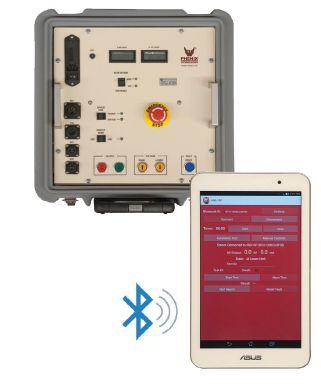
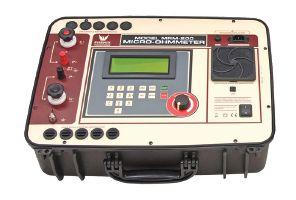





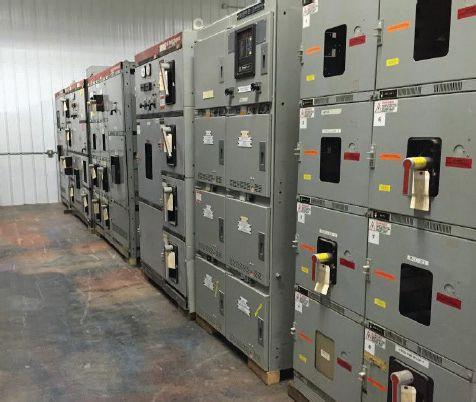





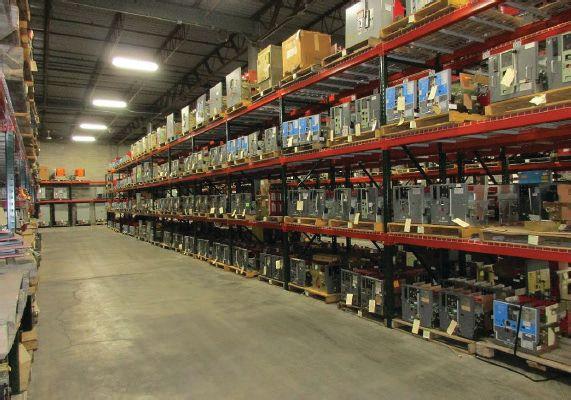
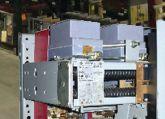

1-301-746-8118 • www.PhenixTech.com 40+ Years Experience info@phenixtech.com • 75 Speicher Drive, Accident, MD 21520 USA A Wide Range of Test Systems Available High Voltage - High Current - High Power Test Systems and Components TECHNOLOGIES PHENIX R High Current Circuit Breaker Test Sets ➤ 9 models available ➤ 1,000 to 75,000 Amp Outputs ➤ Updated control system, automated testing, data acquisition Micro-Ohm Meters ➤ Accurately measure very low contact resistances ➤ 5 models available ➤ 10 to 200 Amp AC Vacuum Interrupter Tester, 60 kV ➤ Bluetooth connection to Android devices
Bluetooth to battery printer
Android App included BULLOCK BREAKERS B B 475 Annandale Blvd • Annandale • Minnesota 55302 www.bullockbreakers.com • Email: jason@bullockbreakers.com • Thousands of Air Circuit Breakers in Stock! • Switchgear Line-ups you can’t find anywhere else! • Now Available as Reconditioned with AC-Pro Trip Units! 1-763-269-2832
➤
➤





Exhibit to an audience of 500+ electrical testing professionals including leading decision-makers looking for new products and services.
MARCH 8 – 12, 2021
For attendee profile and additional information, visit powertest.org

SHINGLE
ORLANDO, FLORIDA POWERTEST.ORG
CALL
HOSTED BY
PREMIER ELECTRICAL MAINTENANCE AND SAFETY CONFERENCE
ROSEN
CREEK
888.300.6382
FOR EXHIBITORS
THE

THE POOL IS EMPTY!

 BY DON GENUTIS, Halco Testing Services
BY DON GENUTIS, Halco Testing Services
I was awakened by a phone call at 3:30AM on a recent Saturday morning and somehow cleared my voice well enough for the customer to understand we would mobilize a technician ASAP to troubleshoot flooding at one of his campus buildings. By 4:15AM, our technician was on site with campus electricians discussing a situation involving the physical education building at one of the most famous universities in the western United States. The building was still energized, but from the steps leading to the basement electrical room, it was clear that perhaps a foot of water was present and additional water was leaking onto the dual 5kV load interrupter switches (LIS). It was immediately apparent the water leak could cause a flashover at any time and local switching or even stepping into the water would be extremely dangerous.
By 6:30AM, switching permissions were granted and executed from other locations on the incoming medium-voltage circuit loops so the building’s equipment sources were safely de-energized. Sump pumps powered from a temporary generator began to slurp the electrical room water down quickly. The overhead leak flow began to diminish as well. Temporary lighting was soon in place, inspections were underway, and additional technician support arrived to assess the overall damage. Other
equipment in the room was unscathed, but there was substantial damage to one of the LIS. As one of the technicians broke free to give me an update, he climbed the steps, went outside, and exclaimed, “The pool is empty! OMG, it’s only about ⅓ full!” I tried to envision the majestic pool where Greg Louganis gracefully twirled in the air on his diving descents in the 1984 Summer Olympic Games being nearly empty. We immediately understood where the water in the basement was coming from.
18 • SUMMER 2020 THE POOL IS EMPTY!
IN THE FIELD PHOTO: © ISTOCKPHOTO.COM/PORTFOLIO/DIMARIK
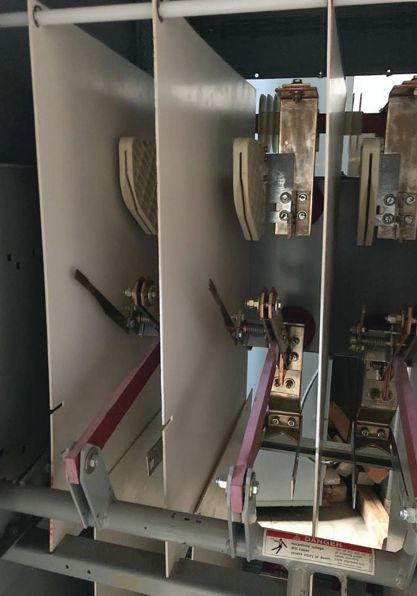
Load interrupter switches provide a reliable and economical means of switching and isolation often used for transformers in unit substation applications. These medium-voltage switches generally consist of incoming cable bus landings, the switch element itself, fuses, and outgoing jumper cables or bus. The switch element consists of main and arcing contacts plus an arc-quenching assembly. The switch is manually operated from outside of the metal clad enclosure. As the switch is opened, the main contacts open first, leaving the arcing contacts to operate next to interrupt the current with the assistance of springs to accelerate contact travel and provide a consistent break. During the closing operation, the arcing contacts engage first, closely followed by the main contacts.
The damage to the primary source LIS included substantial insulation tracking damage to the operating arm (red bar at top) that could not be repaired in the field; in addition, the operating arm was fractured when the switch was opened. Two of the arcing contacts (bottom) were also damaged.

Clearly, the immediate water entrance may have caused some tracking damage, but there was substantial existing damage — and that damage might have caused injury or catastrophic failure if it had been operated under load. Additionally, the broken operating arm would have left one phase energized, causing a potentially dangerous condition.
Technicians thoroughly cleaned and lubricated the alternate source switch, and after insulation tests were successful, the alternate source switch was re-energized successfully and the parts from the damaged switch, now out of service, were obtained for a future repair outage. The building was back online by 12:30pm.
Several common failure modes have been noted during many years of testing and performing preventive maintenance on LIS:
• Tracking on an insulation barrier if they are touching or very close to energized components

NETAWORLD • 19 THE POOL IS EMPTY!
IN THE FIELD
Load Interrupter Switch Interior
Damage to Primary LIS
Tracking on Insulation Barrier
IN THE FIELD
• Tracking and erosion of the operating arm insulation from long-term partial discharge activity accelerated by dust contamination and high humidity
• Damage to the arcing contact blade including fracture of the arcing contact tip from the body of the arcing contact
• Internal damage to the arc quenching device.
CONCLUSION
Although this particular adventure was a bit unusual, reliable power to the building was restored in an efficient manner by taking a step back and analyzing the situation carefully before beginning. Inspection showed that lack of maintenance could have placed campus electricians in danger if they had attempted to open the switch. Facility managers must understand and appreciate the need to maintain

their equipment. Hopefully, this example better illustrates why.
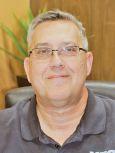
Don A. Genutis presently serves as President of Halco Testing Services, Inc., a NETA Accredited Company with offices in Los Angeles and Houston. He has held various principal positions during his 35plus year career in the electrical testing field, primarily focused on advancing no-outage testing techniques for the last 20 years, with emphasis on cable and switchgear on-line partial discharge testing techniques. Early in his career, Don acquired and operated the former Westinghouse East Pittsburgh Insulation Research Laboratory, where he gained valuable experience in understanding insulation material performance. Don holds a BS in electrical engineering from Carnegie Mellon University and is a NETA Certified Technician. Don has authored 50 technical articles for NETA World and has been featured in EC&M and Uptime magazines. Don’s work is summarized in his book, Partial Discharge & Other No-Outage Testing Methods, published in 2019.
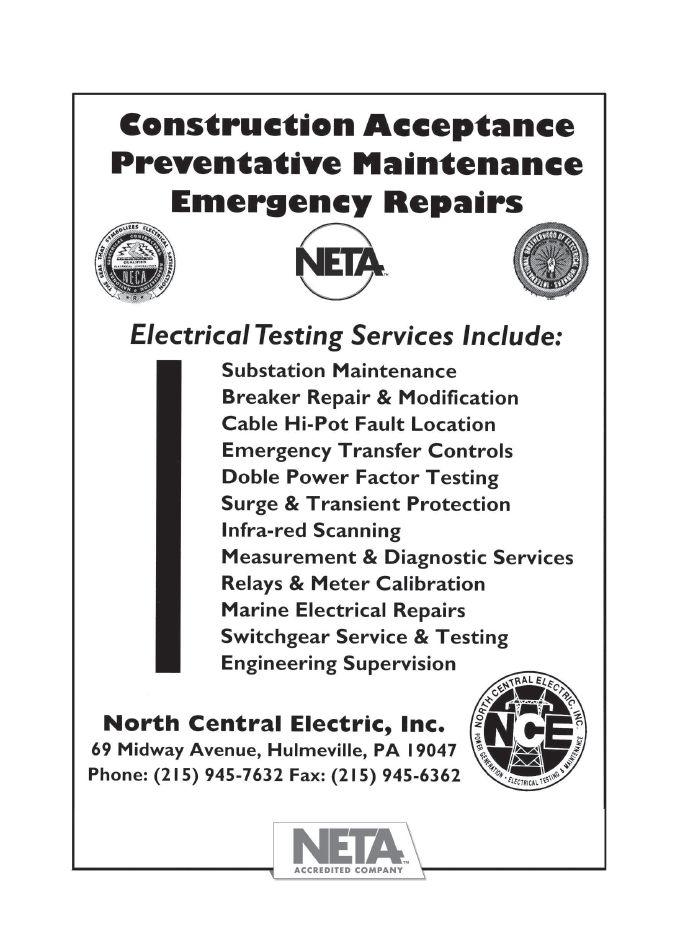


















800.331.2002 | PotomacTesting.com POWER THROUGH WITH MAKE A REAL POWER MOVE... PARTNER WITH MID-ATLANTIC’S PREMIER PROVIDER OF ELECTRICAL TESTING, ENGINEERING AND FIELD SERVICES. Since 1985







LIMITING ARC FLASH EXPOSURE ON LOW-VOLTAGE SYSTEMS
BY SCOTT BLIZARD, American Electrical Testing Co. LLC
As the electrical industry addresses arc flash electrical safety concerns, it now acknowledges the high risks associated with what used to be normal maintenance tasks. In many cases, excessively high arc flash incident energy levels require all maintenance to be done with equipment deenergized, despite the fact that it may not always be considered feasible.
In addition to the usual electrical safety concerns, technicians in the fi eld must be concerned with a myriad of other things. One such safety concern is employee health. Personal protective equipment (PPE) in many cases is not designed or intended to be shared among employees. In order to safely share or re-issue certain types of PPE, a company must follow manufacturer and OSHA cleaning, sanitizing, and tracking procedures. Doing so can also help prevent the spread of illnesses like the common cold, hepatitis, influenza, and SARS-Cov2 (Covid-19). Employees should also be trained to properly clean and maintain their individually issued PPE.
Using new system designs, products, retrofits, equipment modifications, and alternate protection settings can significantly lower arc flash incident energy levels and employee risk. In many cases, NFPA 70E PPE Category 2 or lower can be obtained using these tools and techniques.
REDUCING INCIDENT ENERGY
One of the most convenient methods to lower the incident energy — which will in turn lower an employee’s potential exposure during a fault of electrical equipment — is to enable the equipment to clear the fault quicker and associated protective devices to trip faster. The following are just some of the methods to reduce the clearing time of an electrical fault using various protective devices and schemes.
1. Use fuses, current-limiting fuses, and currentlimiting breakers to reduce the amount of incident energy released during arc flashes by reducing the amount of available fault current.
2. Use current-limiting reactors, which restrict fault current levels. For example, low-voltage motor control centers can be supplied with three single-phase reactors that limit available
22 • SUMMER 2020 LIMITING ARC FLASH EXPOSURE ON LOW-VOLTAGE SYSTEMS
SAFETY CORNER
SAFETY CORNER

short circuit current, resulting in smaller energy releases when faults occur.
3. Implement a bus differential scheme that increases the speed to trip the circuit, which will reduce the arc flash hazard. The concept of a bus differential protection (87B) scheme has been around for a very long time, but because of space and cost constraints, it was typically only applied on medium- to highvoltage equipment. The scheme measures 100% of the current going into and out of a bus. It requires three additional current transformers on every breaker. Simply put:
If 100% IIN = 100% IOUT, then no trip
If 100% IIN ≠ 100% IOUT, then trip all bus breakers instantaneously
4. Use zone selective interlocking (ZSI) to improve downstream coordination so more zones can be attained with selective tripping. ZSI is a control logic system that communicates between feeder breakers and upstream breakers. The control system is built into the electronic and digital trip units
of low-voltage breakers. ZSI’s use and design have improved significantly over the last 20plus years.
Assuming a high-level short circuit occurs on the load side of a feeder breaker, both the main breaker and the feeder breaker’s digital trip units sense the fault. The feeder breaker sends a blocking signal to the main breaker letting it know that the fault is in its zone of protection. The blocking signal tells the main breaker to only trip per the trip unit’s time- delayed standard settings (backup to the feeder breakers) while the feeder breaker is the first to clear the fault.
When a fault occurs in the switchgear on the primary side of a feeder breaker, no blocking signal is sent to the main breaker. Since the main breaker senses the fault but does not receive a blocking signal, its control logic bypasses the selective coordination time delays and trips instantly. It lowers its time-delay settings to approximately 2 cycles, providing just enough delay to assure nuisance tripping does not occur.







NETAWORLD • 23 LIMITING ARC FLASH EXPOSURE ON LOW-VOLTAGE SYSTEMS
PHOTO: © ISTOCKPHOTO.COM/PORTFOLIO/WSFURLAN
SAFETY CORNER
When applying ZSI as an arc-flash solution, be aware of the following:
A. It is automatic and requires no special precautions.
B. It will only affect the short time delay and ground fault time delay setting characteristics.







C. The arcing fault current must be above the short time pickup settings (STPU) or ground fault pickup (GFPU) settings for ZSI to be initiated, thus reducing the arc-flash incident energy.
D. Different breaker testing procedures will be required during maintenance and calibration testing to prove the integrity of the system.
5. Apply a maintenance switch, which is another effective way to lower arc flash incident energy level. This option can be retrofitted onto older equipment or purchased new in low- and medium-voltage protective devices. An external override switch and circuitry is connected to a breaker’s trip unit and adjusted to between 2.5X–10X. The intent of the maintenance switch is to lower incident energy at downstream protective devices. The maintenance switch is closed when performing maintenance. This automatically overrides all the associated breaker’s delay functions and causes the breaker to trip without any intentional delay when a fault is detected. When maintenance is complete, the maintenance switch is manually reopened and all previous trip unit settings are reactivated without need for recalibration.
6. Install arc detection sensors provide a clear measurement of an arc flash. The light emitted during an arc flash event is significantly brighter than normal substation background light. The light surge is available from the initiation of the arc flash and is easily detected using existing technology. The most commonly found sensors are lens point and bare fiber optic. The light is channeled from the sensor to the detector located in the protective relay. System
integrity is monitored using a fiber optic loop. In the case of lens sensors, each lens has an input and output connection. The input is connected to a transmitter in the relay, and the output is connected to a detector in the relay. This loop connection allows periodic testing of the system by injecting light from the transmitter through the loop and back to the detector. This loop connection system works with either sensor type.
The bare fiber sensor consists of a highquality plastic fiber optic cable without a jacket. The clear fiber cable becomes a lens, bringing in light from the area. Using a bare fiber sensor makes detection in large areas possible using only one sensor. The cable is constructed of a 1-millimeter plastic material that can withstand a 25-millimeter bending radius without damage. The cable can be cut to length in the field and fit to the application without excess cable.
Most arc detection systems use a combination of lens and bare fiber sensors returning to a single relay. Proper installation of the sensors and relays provides logical detection and trip points in the system. Sensors should be located where arc detection for the specific sensor would trip the corresponding upstream breaker. Using more than one sensor provides 100% coverage even during 1-millisecond testing intervals. Installation of sensors varies depending on the switchgear manufacturer, type of gear, and number of sections. Multiple sensor inputs provide coverage and sectioning options. One bare fiber sensor can provide excellent coverage of the entire bus section. Using lens sensors allows better control in smaller, more confined spaces.
One obstacle to using light sensors is the need to measure and adjust for changing ambient light levels. Measuring light and current in the protective relay can use the analog measurements and event-reporting capabilities in the relay. By monitoring the incoming light as an analog signal, the enduser can view and set the normal light levels for the application. Event reporting also provides a troubleshooting tool with time-
24 • SUMMER 2020
LIMITING ARC FLASH EXPOSURE ON LOW-VOLTAGE SYSTEMS
tagged events, including arc sensor light levels. Tracking arc light intensity provides the detail needed to reach the root cause of an event. The added advantage of processing arc flash detection in the protective relay is the ability to use a true overcurrent measurement as a supervising element to improve security.
To achieve the fastest trip times, some arc detection systems use a current setting level below the normal expected load. This enables the arc flash detector as the trip mechanism. Using current in this manner removes any time lag determining whether a fault exists, but it sacrifices selectivity and makes the system dependent on light detection alone. Superior security can be obtained using a high-speed overcurrent element in conjunction with the light sensor without sacrificing trip speeds.
A true high-speed overcurrent element is used in parallel with an arc flash detector. The current used to trigger a trip is derived by sampling the feeder current and using a fast detection algorithm to signal that a fault has occurred. This fault is then compared with the trip levels of the arc detection sensors to determine if an arc flash trip is warranted. Many standard overcurrent elements have response times between 6 and 20 milliseconds; however, this delay is unacceptable for arc flash detection supervision. To avoid introducing additional delay, the high-speed overcurrent protection must act as quickly as the arc detector. The combination of fast overcurrent and arc flash detection must be present at the same instant; the combined security is much higher than either system alone. Adding arc flash sensors reduces the total fault-clearing time, and the time reduction has a dramatic effect on arc flash energy.
These are just some of the technologies and methods to reduce arc flash energy in electrical switchgear. Compliance with arc flash hazard work rules as defined by OSHA, NFPA 70E, Standard for Electrical Safety in the Workplace and NFPA 70, National Electrical Code requires evaluation of arc flash hazards and subsequent
posting of the incident energy level on the electrical equipment. New in 2020 to NFPA 70 are Article 240.67(C) and Article 240.87(C) requiring performance testing:
The arc energy reduction protection system shall be performance tested by primary current injection testing or another approved method when first installed on site. This testing shall be conducted by a qualified person(s) in accordance with the manufacturer’s instructions.
A written record of this testing shall be made and shall be available to the authority having jurisdiction.
Informational Note: Some energy reduction protection systems cannot be tested using a test process of primary current injection due to either the protection method being damaged such as with the use of fuse technology or because current is not the primary method of arc detection.
CONCLUSION
All methods described above require proper maintenance of the associated electrical systems and the arc energy reduction protection system. De-energizing equipment before performing any work is always the safest way, but it is not always feasible. When you must work on any equipment, energized or not, ensure you wear the appropriate personal protective equipment (PPE) to perform the task.

Scott Blizard has been the Vice President and Chief Operating Officer of American Electrical Testing Co., Inc. since 2000. During his tenure, Scott also acted as the Corporate Safety Officer for nine years. He has over 25 years of experience in the field as a Master Electrician, Journeyman, Wireman, and NETA Level IV Senior Technician.







NETAWORLD • 25
LIMITING ARC FLASH EXPOSURE ON LOW-VOLTAGE SYSTEMS SAFETY CORNER



The Power of Positive Results
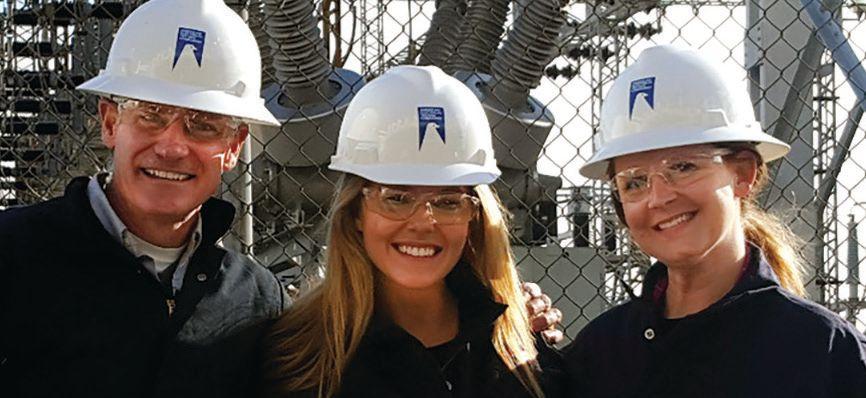

AET Brings Precision and Value to Electrical Testing, Commissioning and Engineering… and Positive Results to Our Customers.
AET delivers the best value in the marketplace by offering the highest quality service at competitive prices. With a workforce and offices located throughout the country, AET is an industry leader and one of the largest independent electrical testing companies in the U.S.
To learn more about AET’s full range of testing and engineering services, visit www.aetco.us
• 800.992.3826

WWW.AETCO.US
An Company A Subsidiary of




start with your breakers

Be confident that your facility is safe and from Utility Relay Company.
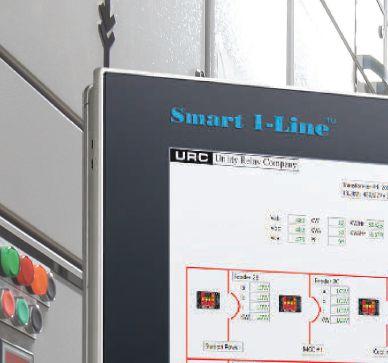








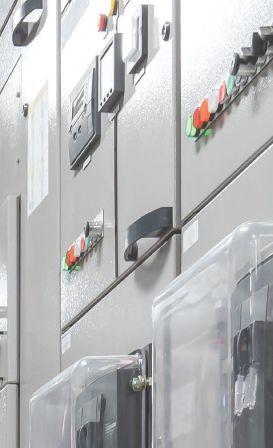
- Arc Flash Mitigation
- Voltage & Power Monitoring
- Sluggish Breaker® Detection
- Waveform Capture Smart 1-Line®
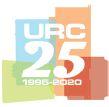
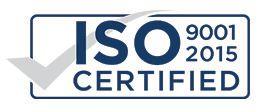
- Real-Time Monitoring
- Intuitive Interface
- Remote Breaker Tripping
- Match Your One-Line Diagram





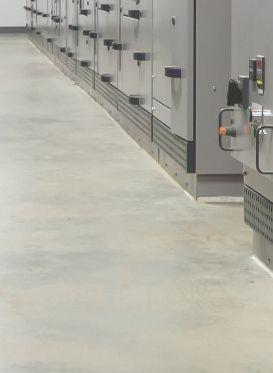
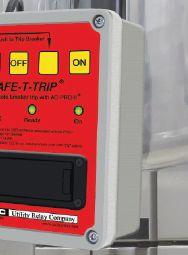
Solutions and retrofit kits from Utility Relay Company are pre-engineered keeping functionality and ease of installation in mind. Our research and development team of engineers work to provide what our customers need. Count on URC for state-ofthe-art high quality products.


UTILITYRELAY.COM | 888.289.2864 | URCSALES@UTILITYRELAY.COM
Feature-RICH Future-Ready
AC-PRO-II®


James (Jim) R. White, Vice President of Training Services, has worked for Shermco Industries Inc. since 2001. He is a NFPA Certified Electrical Safety Compliance Professional and a NETA Level 4 Senior Technician. Jim is NETA’s principal member on NFPA Technical Committee NFPA 70E®, Electrical Safety in the Workplace®, NETA’s principal representative on National Electrical Code® Code-Making Panel (CMP) 13, and represents NETA on ASTM International Technical Committee F18, Electrical Protective Equipment for Workers. Jim is Shermco Industries’ principal member on NFPA Technical Committee for NFPA 70B, Recommended Practice for Electrical Equipment Maintenance and represents AWEA on the ANSI/ISEA Standard 203 Secondary Single-Use Flame Resistant Protective Clothing for Use Over Primary Flame Resistant Protective Clothing. An IEEE Senior Member, Jim received the IEEE/IAS/PCIC Electrical Safety Excellence Award in 2011 and NETA’s Outstanding Achievement Award in 2013. Jim was Chairman of the IEEE Electrical Safety Workshop in 2008 and is currently Vice-Chair for the IEEE IAS/ PCIC Safety Subcommittee.


No. 130
BY JAMES R. WHITE, Shermco Industries


SAFETY FIRST, LAST, AND ALWAYS

Rear Tie Cell Tracking

Everyone says they want to be safe, but when you get right down to it, some are more serious — or possibly they understand the consequences of incorrect decisions more accurately — than others. Whoever performed the repair in this photo did not have a clue what they were doing or the possible consequences of such shoddy work. Thankfully, we were called in before it arced over and caused injury or death. This Tech Quiz will help sharpen you up. You could just look these up, but first try to answer them on your own.
1. In Section 110.1(D), NFPA 70E calls for an electrical safety program to be designed to provide two things to a worker. What are those two things?
a. Awareness of the hazards and the ability to interpret one-line diagrams
b. Self-discipline and the ability to choose the correct signs
c. The ability to interpret the hierarchy of risk control methods and choose the correct method
d. Awareness of the hazards and the selfdiscipline required for work containing electrical hazards
28 • SUMMER 2020 TECH QUIZ
TECH QUIZ
2. In Section 110.1(H), what are the three elements of a risk assessment? List all three in no particular order.
a. _______________________________
b. _______________________________
c. _______________________________
3. What is the first priority in the hierarchy of risk control methods?
a. Engineering controls
b. Substitution
c. Elimination
d. PPE
e. Awareness
f. Administrative controls





4. A job safety plan requires three things. What are they?
a. Be completed by a qualified person, be documented, and contain the list of items listed in 110.1(I)
b. Contain the list of items listed in 110.1(I), be completed by a supervisor or manager, be documented
c. Be documented, be completed by a responsible person, and contain whatever is going to be used in the job
d. Be completed by a manager or higher, be documented, and preferably contain photos of all participating workers for identification later
See answers on page 98.
Powerful Reliability Solutions
Power System Acceptance Testing
Commissioning and Start-up
Maintenance
Coordination and Arc Flash Studies
Troubleshoot and Repair
Training and Engineering Services
Planning and Operations Support
Project Management







TECH QUIZ
Delivering
✔ ✔ ✔ ✔ ✔ ✔ ✔ ✔ Sigma Six Solutions, Inc. 2200 West Valley Hwy North, Suite 100 | Auburn, WA 98001 | Sales: 425-293-1239
www.sigmasix.com




THE PREMIER ELECTRICAL MAINTENANCE AND SAFETY CONFERENCE

CALL FOR SPEAKERS
Communicate your knowledge, assist the industry, and gain visibility. Presentations are sought in a number of categories:
– Electrical Safety – Reliability – Equipment
– Case Studies

Opens January 3, 2020. Abstracts due May 1, 2020. To submit or learn more, visit powertest.org

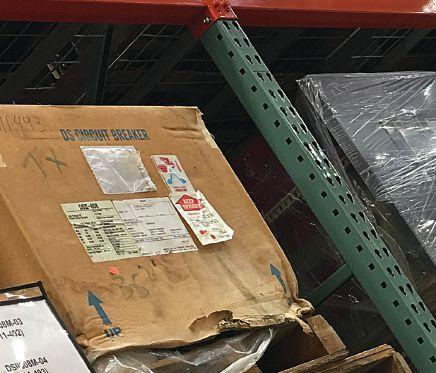
– Transformers – Relays – Emerging Technologies – Cables
– Circuit Breakers
MARCH 8 – 12, 2021 ROSEN SHINGLE CREEK

HOSTED BY
ORLANDO, FLORIDA POWERTEST.ORG
888.300.6382




EQUIPMENT?



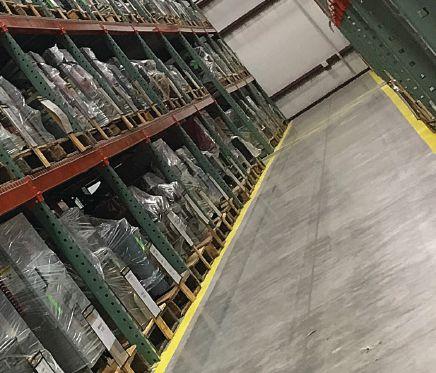
When equipment fails, every minute spent searching for what you need is bad for the bottom line. Our massive inventory of millions of new, surplus and repurposed circuit breakers, switchgear and related products is here for you. We have the expertise to see the big picture, understand your problem and recommend the best solution. Already know exactly what you need? Our website is constantly being updated with products and the online buying process is easy.
Tap into the power of National Switchgear at nationalswitchgear.com or call us today at (800) 322-0149.
TO WAIT FOR ELECTRICAL
CAN’T AFFORD
performance by design sm






TRACING GROUND LEAKAGE WITH A A

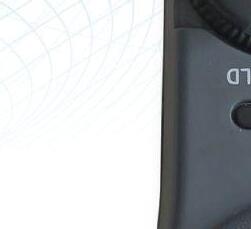









CLAMPMETER






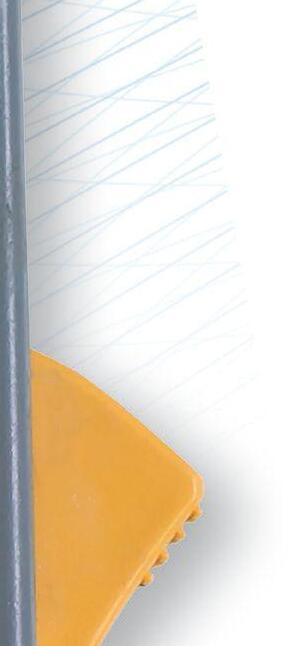





 BY JEFF JOWETT,
BY JEFF JOWETT,



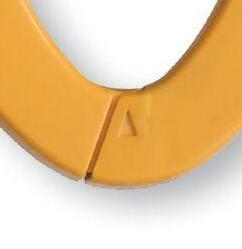

The clamp-on current meter that appeared in the late 20th century was a blessing to everyone working in electrical testing. It improved the vital measurement of one of the three components of Ohm’s Law by a quantum leap. No more difficult, costly, time-consuming, and potentially dangerous direct connections to live circuitry. Just clamp a pair of jaws around a conductor and read the current with digital accuracy in seconds. The clamp-on current meter quickly became so popular that it became widely known as the amprobe after the product moniker of Amprobe Instrument Corporation, its early developer — much like Kleenex and Frigidaire.
But the initial design, while an unquestionable success, still had one important shortfall: It had to be clamped on a single conductor. If clamped over a multicore cable, the phases canceled each other out and the meter read zero. That’s still a problem today. One product, the Flexi-Clamp, appeared briefly on the



market, but its circuitry was top heavy and it did not survive.
Not to worry! Research and development in electronic circuitry and capability is rapid and relentless. While an easy and practical solution to splitting cable and clamping over a single conductor remains elusive, new innovation has
32 • SUMMER 2020 TRACING GROUND LEAKAGE WITH A CLAMP-ON METER
TECH TIPS
ISTOCKPHOTO.COM/PORTFOLIO/KCKATE16
PHOTO: ©


discovered additional applications for clamping over multi-core wire.



To put a new technique into practical use, the basic technology had to be first improved with a quantum leap in sensitivity and resolution. Off-the-rack meters with a resolution of 0.1 and even 0.01 Ma aren’t good enough. Meters had to first measure with 0.001 mA resolution to enable small losses of current going to ground via extraneous paths to be recognized, measured, and traced. This unwanted phenomenon in electrical circuitry is described as “earth leakage,” which must be considered alongside the more familiar insulation leakage of current going to ground through insulating material. These leakages cause problems in circuitry and equipment such as overheating, shock, noise interference, and many others. The clamp-on ammeter seeks to measure the current going to ground not only through grounding conductors, but also finding its way through extraneous paths.
Th e simplest application would be to just clamp the grounding conductor (Figure 1). Even this is somewhat demanding because small currents below the threshold of common clamp-ons may still indicate a problem for sensitive electronic equipment. However, other leakage paths may be just as problematic and far more difficult to recognize and trace until now.
A more sensitive and exploratory technique is the differential leakage test (Figure 2). This is the ability to clamp both the hot and neutral at once and measure the difference between the hot and neutral magnetic fields radiating from within the core of the jaw clamping the conductors. In the common case of hot and neutral, these fields would be 180° apart, canceling each other out and resulting in no leakage measurement. However, if a fault is present that is allowing passage of leakage current to earth, then the imbalance in hot and neutral currents produces imbalanced magnetic fields that a sufficiently sensitive instrument can detect. This will then appear on the display not



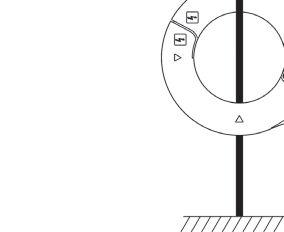



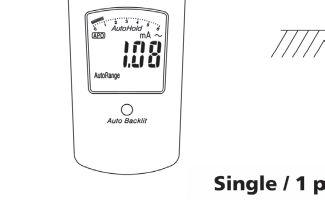

as the circuit current but as the measurement of leakage current being lost.
Differential leakage is the fundamental principle of operation of residual current devices (RCDs) and ground fault circuit interrupters (GFCIs) where a balance of hot and neutral currents equals no tripping of the protective device, while imbalance due to leakage within a circuit or appliance trips the device.


NETAWORLD • 33 TRACING GROUND LEAKAGE WITH A CLAMP-ON METER
TECH TIPS
Figure 1: Direct Reading of Ground Current
Figure 2: Differential Leakage Measurement










To be useful as a troubleshooting tool on the low end of the measurement spectrum, the meter must be of high quality and afford additional special features and functions to the skilled operator. Sensitivity and resolution have been mentioned, while on the opposite end of the measurement scale, range is also important to help accommodate the many possibilities that might occur during, for instance, troubleshooting an entire facility. Accordingly, both manual and auto ranging are useful to first guide the operator and then permit the operator to guide the instrument by focusing on what looks suspicious or not matching up to expectations. Of course, a true rms original is indispensable in looking for noise influences, as both pure, undistorted, sinusoidal AC waveforms and non-sinusoidal waveforms containing triangles, pulse trains, and other distortions need to be recognized and quantified.
When tracing a problem around a circuit, data hold and auto data hold are important because the operator will want to see where currents appear, disappear, divide, or in any way follow an atypical or unexpected path. Using an instrument that can keep track of such changes as opposed to doing it mentally increases speed and reduces error. This can be at the operator’s discretion or auto selected by the instrument. Peak hold similarly augments this diagnostic capability by keeping track of a suspect signal against background noise.
A low-pass fi lter is another useful tracing tool that enables the operator to set a ceiling on measured frequencies. This eliminates the distraction of extraneous noise by attenuating frequencies above the cut-off, filters out high frequency harmonics, and enables stable measurements. A typical cutoff frequency would be 100 Hz, with an attenuation characteristic of -24 dB per octave (Figure 3).
A compare feature provides another tool for the operator to trace a specific leakage path in the presence of extraneous signals from other sources. A limit value can be selected for the traced signal and the measured value
34 • SUMMER 2020
TRACING GROUND LEAKAGE WITH A CLAMP-ON METER TECH TIPS
Figure 3: Low-Pass Filter
Figure 4: Differential Leakage on Three-Phase System
Figure 5: Differential Leakage on Three-Phase-Plus-Neutral System

automatically compared to it. It the limit is exceeded, a buzzer is activated and the display flashes. This helps the operator stay on the traced signal to origin. Manual and auto range selection similarly aids this function.
Single-phase earth leakage, in which the phase and neutral conductors are simultaneously clamped, is not the only possible circuit where this technology can be effectively applied. It can also be applied to three-phase conductors (Figure 4) and to three-phase-plus-neutral configurations (Figure 5). The instrument measures the magnetic fields in the clamped conductors and indicates any deviations as leakage current.
CONCLUSION
This technique has proven useful and effective in locating and correcting nuisance tripping

of protective devices. Find where the current is emanating from and eliminate it from the circuitry. While these small leakage currents may not create an issue for the operation of systems like lighting and electric motors, they can be anything from a major nuisance to a source of disruption of vital sensitive circuits that aff ord little or no tolerance of noise. Clamp-on tracing of extraneous current sources provides an effective means of combatting and correcting such problems.

Jeffrey R. Jowett is a Senior Applications Engineer for Megger in Valley Forge, Pennsylvania, serving the manufacturing lines of Biddle, Megger, and MultiAmp for electrical test and measurement instrumentation. He holds a BS in biology and chemistry from Ursinus College. He was employed for 22 years with James G. Biddle Co., which became Biddle Instruments and is now Megger.
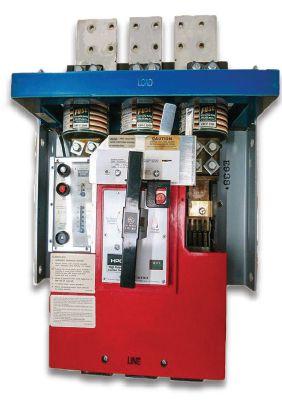




TECH TIPS
HPC
We’ve got you covered. • In Stock • New and Obsolete • 800A—4000A • Retrofit kits • 24/7 Emergency Service We stock new General Electric HPCII drop in replacements for the THPC 3000 & 4000 amp GFI models for same day shipping. Call anytime for immediate service. 800-421-5082 www.qualityswitchgear.com HPC New Generation HPC
Switches?








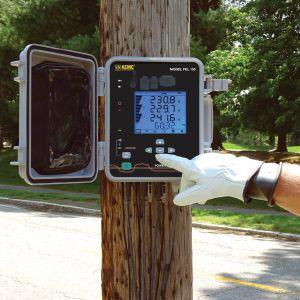
•
• Harmonic detection analysis
• Inrush current analysis
• Energy cost analysis and management

• Power factor analysis and correction
• Power demand and consumption monitoring
• Transient detection and analysis




• Data logging
And much more!


















All Models Work On 50, 60 & 400Hz Networks
and Energy
Power
Loggers
Voltage current and power monitoring
Portable Instruments for indoor and outdoor applications PEL 102, 103 PEL 105 LIS T ED ® US C (102/103 only) RAT ING SAF ETY
sales@aemc.com (105 only)
200,000 sq.
southeast
Southland Group
products
need most in stock
ready
ship! Our team of experienced technicians
on-site field service support
engineering services to ensure that your products are safe, reliable
service ready.
us today
let us create the solutions you need most!
...
www.aemc.com
An extensive inventory of over
ft. across the
means the
has the
you
and
to
provide
and
and
Contact
and


The largest NETA Accredited technical group in the industry, that never compromises safety.

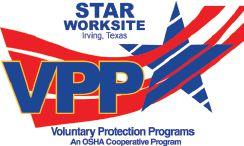
As North America’s largest independent electrical testing company, our most important Company core value should come as no surprise: assuring the safety of our people and our customer’s people. First and foremost.
Our service technicians are NETA-certified and trained to comply and understand electrical safety standards and regulations such as OSHA, NFPA 70E, CSA Z462, and other international guidelines. Our entire staff including technicians, engineers, administrators and management is involved and responsible for the safety of our co-workers, our customers, our contractors as well as our friends and families.
Our expertise goes well beyond that of most service companies. From new construction to maintenance services, acceptance testing and commissioning to power studies and rotating machinery service and repair, if it’s in the electrical power system, up and down the line, Shermco does it.
www.shermco.com l 888-SHERMCO
One Line. One Company.


USING NFPA 70E TO DETERMINE SHOCK AND ARC FLASH BOUNDARIES
BY JAMES R. WHITE, Shermco Industries
The 2018 edition of NFPA 70E is still active, even though many people are looking forward to a new edition in 2021. The 2021 edition will be released to the public in late September or early October, first in pdf form, then as a printed document. Until that release, the current edition must be referenced.
SHOCK BOUNDARIES
Shock remains the number-one cause of electrical fatalities and has been for several years. Arc flash gets the most attention because of the serious injuries caused by an arc flash, not to mention the visual and audible results, which tend to be more impressive than a shock. After all, what electrician or technician hasn’t been shocked at one time or another and just received a slight jolt, maybe a sting — and you look around to make certain no one was watching? We tend to think of low-voltage shocks as more of a nuisance then a real threat, but that is wrong-headed thinking.
Somewhere in the 1999–2002 range, an IEEE Electrical Safety Workshop presentation by Lanny Floyd and Danny Liggett of E.I. DuPont included Figure 1, which was the result of a study done at their facilities. Since these were industrial sites and not utilities, it’s not surprising to see that the over-600 V

Figure 1: Lethal Voltages at an Industrial Facility COURTESY IEEE ESW AND AUTHORS
range is only 11% of the fatalities. It is also not surprising that 250–600 V (mostly 480 V) is the largest percentage of fatalities at 45%. What is very surprising to most people is that 100–250 V is right next to it at 39%. Now, this was an old paper, but the percentages even now tell a real story about the risk involved in dealing with lower voltages.
In NFPA 70E-2018, Article 130 Section 130.4 outlines the shock protection boundaries. But
38 • SUMMER 2020 USING NFPA 70E TO DETERMINE SHOCK AND ARC FLASH BOUNDARIES
COVER STORY >600 11% <100 5% 100–250 39% 250–600 45%
Arc Flash Boundary (Varies) Restricted Approach
Limited Approach Boundary

before the tables, Section 130.4 Shock Risk Assessment states:
(A) General. A shock risk assessment shall be performed:
(1) To identify shock hazards
(2) To estimate the likelihood of occurrence of injury or damage to health and the potential severity of injury or damage to health
(3) To determine if additional protective measures are required, including the use of PPE
N (B) Additional Protective Measures. If additional protective measures are required, they shall be selected and implemented according to the hierarchy of risk control identified in 110.1(H). When the additional protective measures include the use of PPE, the following shall be determined:
(1) The voltage to which personnel will be exposed
(2) The boundary requirements (3) The personal and other protective equipment required by this standard to protect against the shock hazard
“N” indicates that a new section was added. 130.4(A) states the purposes of performing a shock risk assessment, while 130.4(B) provides the needed information concerning “additional protective measures” as provided in Section 110.1(H)(3). A quick look at that section shows use of PPE as the lowest priority, while placing the equipment in an electrically safe work condition (elimination) is highest. Due to issues that arose using standards from American National Standards Institute (ANSI) and American Industrial Hygiene Association (AIHA) in this particular application, it won’t be carried over into the 2021 edition, although its intent will be. Elimination is always the


NETAWORLD • 39 USING NFPA 70E TO DETERMINE SHOCK AND ARC FLASH BOUNDARIES
COVER STORY
Boundary


first choice; PPE is the last, although using appropriate PPE is often unavoidable.
The other risk control methods listed in 110.1(H)(3) should be incorporated to the degree possible. It would be unsafe (and not too smart) to troubleshoot energized electrical conductors and circuit parts without using PPE. Troubleshooting increases the shock risk because if the equipment was in normal operating condition, per Section 110.2(A)(4), troubleshooting would not be necessary; the risk of arc flash also increases. The fact that equipment requires troubleshooting indicates it’s at risk of failure. Not everyone catches that; it’s just a normal day on the job — but it is not normal. More detailed information on the
hierarchy of risk control methods is found in Informative Annex F.
The shock approach boundaries are easy enough to interpret from Table 130.4(D) (a) for AC voltages and 130.4(D)(b) for DC voltages. One key point to remember is that this table has two columns for the limited approach boundary. Column 2 is for exposed movable conductors, such as overhead power lines. It is also for when mechanical equipment is approaching an exposed conductor, movable or otherwise. Equipment tends to bob and sway, especially if the wind is blowing or the lift is extended. Another point to remember is that only qualified persons should approach overhead conductors unless they have been
Notes:
(1) For arc flash boundary, see 130.5(A)
(2) All dimensions are distance from exposed energized electrical conductors or circuit part to employee.
a For single-phase systems above 250 volts, select the range that is equal to the system’s maximum phase-to-ground voltage multiplied by 1.732.
b See definition in Article 100 and text in 130.4(D)(2) and Informative Annex C for elaboration.
c Exposed movable conductors describes a condition in which the distance between the conductor and a person is not under the control of a person. The term is normally applied to overhead line conductors supported by poles.
d This includes circuits where the exposure does not exceed 120 volts nominal.
COURTESY NATIONAL FIRE PROTECTION ASSOCIATION
40 • SUMMER 2020
USING NFPA 70E TO DETERMINE SHOCK AND ARC FLASH BOUNDARIES COVER STORY
(1) (2) (3) (4) Nominal System Voltage Range, Phase to Phasea Limited Approach Boundaryb Restricted Approach Boundaryb; Includes Inadvertent Movement Adder Exposed Movable Conductorc Exposed Fixed Circuit Part Less than 50 V Not specified Not specified Not specified 50 V–150 Vd 3.0 m (10 ft. 0 in.) 1.0 m (3 ft. 6 in.) Avoid contact 151 V–750 V 3.0 m (10 ft. 0 in.) 1.0 m (3 ft. 6 in.) 0.3 m (1 ft. 0 in.) 751 V–15 kV 3.0 m (10 ft. 0 in.) 1.5 m (5 ft. 0 in.) 0.7 m (2 ft. 2 in.) 15.1 kV–36 kV 3.0 m (10 ft. 0 in.) 1.8 m (6 ft. 0 in.) 0.8 m (2 ft. 9 in.) 36.1 kV–46 kV 3.0 m (10 ft. 0 in.) 2.5 m (8 ft. 0 in.) 0.8 m (2 ft. 9 in.) 46.1 kV–72.5 kV 3.0 m (10 ft. 0 in.) 2.5 m (8 ft. 0 in.) 1.0 m (3 ft. 6 in.) 72.6 kV–121 kV 3.3 m (10 ft. 8 in.) 2.5 m (8 ft. 0 in.) 1.0 m (3 ft. 6 in.) 138 kV–145 kV 3.4 m (11 ft. 0 in.) 3.0 m (10 ft. 0 in.) 1.2 m (3 ft. 10 in.) 161 kV–169 kV 3.6 m (11 ft. 8 in.) 3.6 m (11 ft. 8 in.) 1.3 m (4 ft. 3 in.) 230 kV–242 kV 4.0 m (13 ft. 0 in.) 4.0 m (13 ft. 0 in.) 1.7 m (5 ft. 8 in.) 345 kV–362 kV 4.7 m (15 ft. 4 in.) 4.7 m (15 ft. 4 in.) 2.8 m (9 ft. 2 in.) 500 kV–550 kV 5.8 m (19 ft. 0 in.) 5.8 m (19 ft. 0 in.) 3.6 m (11 ft. 8 in.) 765 kV–800 kV 7.2 m (23 ft. 9 in.) 7.2 m (23 ft. 9 in.) 4.9 m (15 ft. 11 in.)
Table 1: NFPA 70E Table 130.4(D)(a)
Table 2: NFPA 70E Table 130.4(D)(b)
kV–500
Note: All dimensions are distance from exposed energized electrical conductors or circuit part to worker.
*Exposed movable conductors describes a condition in which the distance between the conductor and a person is not under the control of a person. The term is normally applied to overhead line conductors supported by poles.
SOURCE: NATIONAL FIRE PROTECTION ASSOCIATION
locked out/tagged and grounded. In industrial facilities, this often must be done by the local utility. Table 1 illustrates Table 130.4(D)(a); Table 2 illustrates 130.4(D)(b).
Bear in mind that these distances are approximated in the field. No one is going to take out their metal tape measure and try to be as accurate as possible. That was never the intent. If you’re farther than the indicated distance, you’re fine. Always try to leave a little extra.
Column 3 is for exposed fixed parts, such as installed equipment, which is what most of us work on. While column (2) and column (3) are the closest an unescorted, unqualified person can approach energized parts or conductors, column (4) is the restricted approach boundary, and only qualified persons can cross it. If you’re not qualified, never cross the restricted approach boundary, and only cross the limited approach boundary if you are continuously escorted by a qualified person. The fact that a person is unqualified means they cannot determine energized parts from de-energized
parts and/or cannot choose appropriate PPE. They are putting themselves and others at risk if they do.
ADDITIONAL PROTECTIVE MEASURES
Many people interpret the phrase “additional protective measures” as saying “use PPE.” Section 130.4 refers the user to 110.1(H)(3), and that section refers the user to Informative Annex F Risk Assessment and Risk Control. A quick look at Informative Annex F shows Table F.3 Th e Hierarchy of Risk Control Methods. Unlike the main text in Section 110.1(H)(3), Table 3 provides some examples of each risk control method. More people should read through the Informative Annexes. They may be optional, but they often contain valuable information that gives more complete information than can fit into the main text.
Table F.3 provides good guidelines for implementing each of the hierarchy of risk control methods. It is very likely that more than one risk control method will be used for a given task.


NETAWORLD • 41
USING NFPA 70E TO DETERMINE SHOCK AND ARC FLASH BOUNDARIES COVER STORY
(1) (2) (3) (4) Nominal Potential Difference Limited Approach Boundary Restricted Approach Boundary; Includes Inadvertent Movement Adder Exposed Movable Conductor* Exposed Fixed Circuit Part Less than 50 V Not specified Not specified Not specified 50 V–300 V 3.0 m (10 ft. 0 in.) 1.0 m (3 ft. 6 in.) Avoid contact 301 V–1 kV 3.0 m (10 ft. 0 in.) 1.0 m (3 ft. 6 in.) 0.3 m (1 ft. 0 in.) 1.1 kV–5 kV 3.0 m (10 ft. 0 in.) 1.5 m (5 ft. 0 in.) 0.5 m (1 ft. 5 in.) 5 kV–15 kV 3.0 m (10 ft. 0 in.) 1.5 m (5 ft. 0 in.) 0.7 m (2 ft. 2 in.) 15.1 kV–45 kV 3.0 m (10 ft. 0 in.) 2.5 m (8 ft. 0 in.) 0.8 m (2 ft. 9 in.) 45.1 kV–75 kV 3.0 m (10 ft. 0 in.) 2.5 m (8 ft. 0 in.) 1.0 m (3 ft.
3.3 m
3.0 m (10 ft.
1.2 m
ft.
1.6
6 in.) 75.1 kV–150 kV
(10 ft. 8 in.)
0 in.)
(3
10 in.) 150.1 kV–250 kV 3.6 m (11 ft. 8 in.) 3.6 m (11 ft. 8 in.)
m (5 ft. 3 in.)
3.5
8.0 m
ft.
8.0 m
ft.
in.) 5.0 m
ft.
250.1
kV 6.0 m (20 ft. 0 in.) 6.0 m (20 ft. 0 in.)
m (11 ft. 6 in.) 500.1 kV–800 kV
(26
0 in.)
(26
0
(16
5 in.)

COVER STORY

Risk Control Method Examples
(1) Elimination
(2) Substitution
(3) Engineering controls
(4) Awareness
(5) Administrative controls
(6) PPE
Conductors and circuit parts in an electrically safe working condition
Reduce energy by replacing 120 V control circuitry with 24 Vac or Vdc control circuitry
Guard energized electrical conductors and circuit parts to reduce the likelihood of electrical contact or arcing faults
Signs alerting of the potential presence of hazards
Procedures and job planning tools
Shock and arc flash PPE
COURTESY OF THE NATIONAL FIRE PROTECTION ASSOCIATION
• Elimination is the first priority (as it should always be), such as placing equipment into an electrically safe work condition.
• Substitution is often difficult to achieve unless it is a design element.
• Engineering Controls such as guarding are often used in conjunction with other methods. You can find more on guarding in the 70E & NETA column in the 2016 Summer issue of NETA World Journal
• Awareness, such as using signs, barrier tape, and attendants, is also often used with others.
• Hopefully, Administrative Controls would always be used to plan the task and guide technicians through it.
• Last is PPE, that is, appropriate PPE for the task and the hazard.
Used together, these risk control methods will greatly reduce the risk in performing electrical tasks, although even when using these methods, there will always be some residual risk or leftover risk that was not resolved. This residual risk must be evaluated to determine if it is still safe to perform the task.
Choosing rubber-insulated gloves and leather protector gloves is relatively simple. Figure 2 is an example of an ASTM glove chart reflecting Table 1 in ASTM F496, Standard Specification for In-Service Care of Insulating Gloves and Sleeves. The glove chart also shows the maximum-use voltage for each glove class,
the label color it should have for that class, and the test voltages — both AC and DC. This example is from W.H. Salisbury, but many variations are available on the internet.
ARC FLASH BOUNDARY
Shock boundaries are fairly straightforward. The arc flash boundary is more difficult. IEEE Std. 1584, IEEE Guide for Performing Arc-Flash Hazard Calculations was updated in 2018 with new calculations and parameters. The prior exception for systems less than 240 V/125 kVA has been eliminated, as recent testing has shown that sustainable arcs are possible, but less likely. Read that as “it could happen” and no one would like the results.
Arc flash kills three or four people a year. That may sound like a very small number (except to those who are killed), but the injuries from arc flash events are the cause of greatest concern. There are many injuries from arc flashes, and they carry life-changing consequences for those involved. As an expert consultant and expert witness, I have seen the damage these incidents can do. Regardless of who is at fault, the person who has been seriously injured by an arc flash will never be the same. Understanding how to determine the risk involved in a task, how to choose the appropriate PPE, and how to perform the task safely is paramount for technicians and is required to be considered a qualified person.
NFPA 70E statements about the arc flash risk assessment are almost verbatim from the shock risk assessment. Section130.5 states:
42 • SUMMER 2020
USING NFPA 70E TO DETERMINE SHOCK AND ARC FLASH BOUNDARIES
Table 3: NFPA 70E Table F.3
Conventional Work Position for Electrical
Ground, Structure or Basket
Ground, Structure or Basket
Structure or Basket
Electrically Isolated Basket or Platform
Electrically Isolated Basket or Platform
Electrically Isolated Basket or Platform
* Maximum use DC voltage is not part of any ASTM specification. Maximum DC voltages are valid in reference to IEC 903 only.
N (A) General. An arc flash risk assessment shall be performed:
(1) To identify arc flash hazards
(2) To estimate the likelihood of occurrence of injury or damage to health and the potential severity of injury or damage to health
(3) To determine if additional protective measures are required, including the use of PPE
N (B) Estimate of Likelihood and Severity. The estimate of the likelihood of occurrence of injury or damage to health and the potential severity of injury or damage to health shall take into consideration the following:
(1) The design of the electrical equipment, including its overcurrent protective device and its operating time
(2) The electrical equipment operating condition and condition of maintenance
N (C) Additional Protective Measures. If additional protective measures are required they shall be selected and implemented according to the hierarchy of risk control identified in 110.1(H). When the additional protective measures include the use of PPE, the following shall be determined:
(1) Appropriate safety-related work practices
(2) The arc flash boundary
(3) The PPE to be used within the arc flash boundary
Table 130.5(C) shall be permitted to be used to estimate the likelihood of occurrence of an arc flash event to determine if additional protective measures are required.


NETAWORLD • 43 USING NFPA 70E TO DETERMINE SHOCK AND ARC FLASH BOUNDARIES COVER STORY
00 2,500 V AC 10,000 V DC
500 V AC 750 V DC Beige 0 5,000 V AC 20,000 V DC 1,000 V AC 1,500 V DC Red 1 10,000 V AC 40,000 V DC 7,500 V AC 11,250 V DC White
20,000 V AC 50,000 V DC 17,000 V AC 25,500 V DC Yellow
30,000 V AC 60,000 V DC 26,500 V AC 39,750 V DC Green 4 40,000 V AC 70,000 V DC 36,000 V AC 54,000 V DC Orange
Class Color Proof Test Voltage AC / DC
Sleeve,
Label Glove Label
2
3
Blanket, Line Hose,
Covers
Lineman Max. Use Voltage AC / DC*
W. H. SALISBURY
Worker or
COURTESY
Figure 2: ASTM Glove Labeling Chart


Almost verbatim, Section 130.5(B), which contains some very important information, was added in addition to 130.5(A) and 130.5(C). The 70E user is to estimate the likelihood of occurrence and the severity of injury if an arc flash were to occur. Two items are listed to assist in determining the likelihood of occurrence:
1. The design of the equipment, the overcurrent protection, and the time of its operation
2. The operating condition of the equipment, including its condition of maintenance
Remember, if troubleshooting is being performed, the equipment is in distress. It is not in normal operating condition. Unmaintained electrical equipment is also hazardous, like a ticking time bomb that could go off at any minute. If any of these conditions indicate an issue, de-energize and isolate the equipment before continuing. No one has ever been promoted for injuring themselves or others or by damaging expensive equipment.
Well, I do know one, but that was in the bad old days, and the facility manager thought the perpetrator was “a company man.” Don’t count on that today. Unsafe conduct is the quickest way out the door (or fence).
Section 130.5 states that Table 130.5(C) is permitted to be used to determine the likelihood of occurrence. “Permitted to be used” should read “use at your own risk.” Careful evaluation is required to determine if Table 130.5(C) has any relevance at all. Table 4 shows a partial Table 130.5(C). For the most part, it does well

Reading a panel meter while operating a meter switch. Performing infrared thermography and other non-contact inspections outside the restricted approach boundary. This activity does not include opening of doors or covers.
Working on control circuits with exposed energized electrical conductors and circuit parts, nominal 125 volts ac or dc, or below without any other exposed energized equipment over nominal 125 volts ac or dc, including opening of hinged covers to gain access.
Examination of insulated cable with no manipulation of cable.
For dc systems, insertion or removal of individual cells or multi-cell units of a battery system in an open rack.
For dc systems, maintenance on a single cell of a battery system or multi-cell units in an open rack. Any No
For ac systems, work on energized electrical conductors and circuit parts, including voltage testing.
For dc systems, working on energized electrical conductors and circuit parts of series-connected battery cells, including voltage testing.
Removal or installation of CBs or switches
Opening hinged door(s) or cover(s) or removal of bolted covers (to expose bare, energized electrical conductors and circuit parts). For dc systems, this includes bolted covers, such as battery terminal covers.
NATIONAL FIRE PROTECTION ASSOCIATION
Any Yes
44 • SUMMER 2020 USING NFPA 70E TO DETERMINE SHOCK AND ARC FLASH BOUNDARIES COVER STORY
Task Equipment Condition Likelihood of Occurrence*
Table 4: NFPA 70E Table 130.5(C)
COURTESY
on normally operating equipment. But what if there’s a rat (or rats) in the circuit breaker? You would never see it coming. Of course, neither did the rats in this photo. No arc flash was initiated, but it was pretty close.
Once the likelihood of occurrence is determined, the potential severity of injury or damage to health must be appraised. This is where 130.5(B) comes into play. If an arc flash were to occur, what would be the impact on the person performing the work, others nearby, or the equipment? It could range from an “oops” to a disaster. Just as in the shock risk assessment, the arc flash risk assessment calls for additional protective measures, and once again, PPE is at the bottom of the options. I prefer to view IEEE 1584 calculations as educated estimates since everything has to work well for them to even be close. That is where normal operating condition and maintenance condition can make a huge difference. If the protective device does not operate within the manufacturer’s specifications, there is no method to determine the resulting arc energy.
Calculations performed to the new edition of IEEE 1584 are best, but not always done. Table 130.7(C)(15) and Table 130.7(C)(16) are the backup plan. They are certainly not perfect, but as long as their limits are observed, they tend to be conservative. They are conservative because everything is “guesstimated.” Better to be a bit over-protected than under-protected. If calculations have been made and arc flash warning labels are installed (and legible), Table 130.5(G) “is permitted” to be used to select PPE. For the sake of brevity, I’ll skip using partials of those tables as figures.
CONCLUSION
The best plan is to avoid the hazard, reduce the risk, and wear PPE where appropriate. Back when the 70E first introduced the arc flash clothing selection tables (in the 2000 edition), Committee Chair Ray Jones said, “What people wear is not as important as that they wear something.” This may sound all backwards today, but his point was that most technicians
of the day weren’t wearing any PPE for arc flash, so something was better than nothing. This was all pre-IEEE 1584, and there simply was no other guidance until Paul Hamer, then with Chevron, introduced the tables they used at their sites.
Electrical safety is an on-going project. Much like the National Electrical Code, it may never be finished, as much is learned every year. The 70E Committee members are unified in their goal to make the workplace safer. We don’t always agree on how to meet that goal but, in the end, we come to a consensus we are satisfied meets the purpose. I once presented a paper, and a participant asked, “How can we trust the 70E if everyone doesn’t agree?” My response: “Why wouldn’t you want us to debate, arm wrestle, or whatever to provide the best safety standard possible?”
NFPA 70E is close to being in a maintenance phase where large revisions aren’t necessary. The committee’s focus has been to make 70E easier for the average technician to use and apply without having to ask for interpretations. It’s there; it’s clear and understandable. If you have any suggestions for the committee, a visit to the NFPA website ( nfpa.org/70e ) allows suggestions, comments, and public Inputs.

James (Jim) R. White, Vice President of Training Services, has worked for Shermco Industries since 2001. He is a NFPA Certified Electrical Safety Compliance Professional and a NETA Level 4 Senior Technician. Jim is NETA’s principal member on NFPA Technical Committee NFPA 70E®, Electrical Safety in the Workplace; NETA’s principal representative on National Electrical Code® Code-Making Panel (CMP) 13; and represents NETA on ASTM International Technical Committee F18, Electrical Protective Equipment for Workers. Jim is Shermco Industries’ principal member on NFPA Technical Committee for NFPA 70B, Recommended Practice for Electrical Equipment Maintenance and represents AWEA on the ANSI/ISEA Standard 203, Secondary Single-Use Flame Resistant Protective Clothing for Use Over Primary Flame Resistant Protective Clothing. An IEEE Senior Member, Jim was Chairman of the IEEE Electrical Safety Workshop in 2008 and is currently Vice Chair for the IEEE IAS/PCIC Safety Subcommittee.


NETAWORLD • 45 USING NFPA 70E TO DETERMINE SHOCK AND ARC FLASH BOUNDARIES COVER STORY


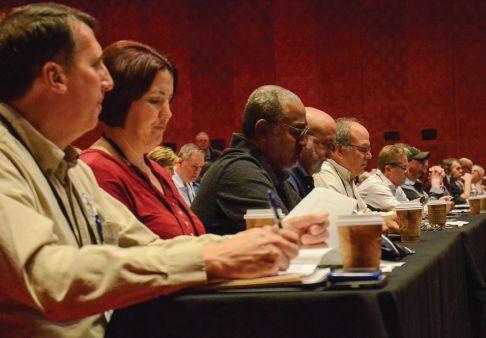
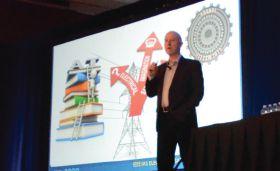




BELIEFS DRIVE BEHAVIORS
BY D. RAY CROW, DRC Consulting, Ltd, and DANNY P. LIGGETT, DuPont de Nemours Inc.
The behavioral components of incidents, injuries, and fatalities must be studied and understood to change the safety culture. This element of study has been missing from the data available to assist in improving workplace safety. Often, this type of information has never been compiled and reviewed. Figure 1 shows the relationship between incidents, injuries, and fatalities.
1:
2:
48 • SUMMER 2020 BELIEFS DRIVE BEHAVIORS
FEATURE
Fatalities Injuries Incidents Skills Will Knowledge
Figure
Incidents Lead to Fatalities
SOURCE: STEPHEN R. COVEY
Figure
Elements of Human Performance

As shown in Figure 2, three primary things impact what people do: what they know, the level of their skill, and their willingness to do it. Lack of skill, experience, or knowledge has been a significant factor in every incident investigation in the past couple of decades. To improve personal safety, employees require continuing knowledge and training to perform their tasks in a safe manner. What is typically ignored is what people think and believe about the standards and procedures they are asked to follow. More time and focus on understanding why people resist accepting new requirements needs to be explored.
Every person has thoughts about the things they are asked to do. One common, unrecognized factor is that everything we see, read, and hear is filtered through our beliefs. At least one more filter applies: Experience plays a significant role in what people tend to accept.
Dr. Mary Capelli-Schellpfeffer told the authors, “We can perceive only what we experience.” Everyone molds information they receive into an understanding that fits into their previous experience. In some instances, the information is completely new and cannot be molded into previous experience. When that happens, a person’s basic beliefs and principles play a role in how the person interprets the data.
Neuroscience tells us that everything we know is our own version of it. We try to make our experiences and what we see, read, and hear
fit into our world, which is built around our beliefs. We seek information that aligns with what we already believe and discount or ignore information that goes against what we already believe — a process called confirmation bias. This bias is so strong that we are unable to pay adequate attention to information that goes against our beliefs even when enticed by monetary incentives or evidence that blatantly disconfirms our position. This can, and many times does, lead us to interpret standards and procedures differently from other people. Two people can watch an event and will have a different understanding of what occurred. As you read this paper, you will most likely have a different understanding of the material from what the authors intended. You will filter the material through your beliefs and experiences.
Most people arrive at work with the intention of doing a good job, doing the right things, and being a productive employee. People do what they believe is the right thing to do based on their experiences and beliefs. What needs to be explored and understood is what people believe about safety and how to influence those beliefs. It is also important to understand that different experiences and beliefs exist in every person at every level of an organization. The beliefs of management will drive behaviors that may create some of the issues that cause incident rates to remain high. For example, an emphasis on meeting deadlines can be perceived to be more important than safety.
NETAWORLD • 49 BELIEFS DRIVE BEHAVIORS
FEATURE ILLUSTRATION: © ISTOCKPHOTO.COM/PORTFOLIO/ENJOYNZ

BEHAVIORS
What are Behaviors?
People’s behaviors are observable. They are actions that people do or do not do. Some examples of behaviors are testing for the absence of voltage, wearing voltage-rated gloves while testing for voltage, and wearing a seatbelt while in a vehicle. If we perceive people as a collection of responses to a collection of stimuli, it fosters an understanding that behavior is predictable and thus changeable. We just have to understand how to do it.
Not taking appropriate actions is also a behavior. Not wearing your seatbelt or failing to test for the absence of voltage are also behaviors. In either context, inappropriate behaviors are unsafe acts. Observation data related to behaviors not previously recorded is a new way to find the leading indicators of possible incidents. Collecting and reviewing multiple behavioral actions is valuable to identify beliefs about safety that impede the implementation of a new or changed safe work practice. The importance of collecting and reviewing behavior-based data on an on-going basis must be stressed within organizations.
How Do Behaviors Impact Performance?
A lot of time is spent identifying unsafe acts, and not enough time is spent on why people perform unsafe acts. Unsafe acts and inappropriate behaviors are key areas that need attention because unsafe acts and inappropriate behaviors contribute to incidents and injuries. It is estimated that 91% of incidents are caused by inappropriate behaviors. Figure 3 provides another layer to the chart shown in Figure 1.
This does not mean incidents are the fault of employees. Equipment can fail and set up a situation or an unsafe condition where an employee can be injured if the condition is not
Fatalities
Injuries
Incidents
Behaviors
recognized. An example of this is a disconnect switch where all of the blades failed to open. Failure to test for the absence of voltage has contributed to numerous incidents, injuries, and fatalities. When incidents occur, something is generally missing in the company’s safety program.
Placing blame for an incident on the employee is a behavior that managers or supervisors might exhibit. Instead, safety supervisors should focus efforts on root cause analysis with employee involvement. Fault finding or placing blame for an incident is the weakest form of changing behavior; it often teaches people to understand that they should not get caught. Fault finding or placing blame has little to do with changing beliefs or behaviors.
Because incidents, injuries, and fatalities are typically the consequences of inappropriate behaviors, we must understand which behaviors are occurring, both appropriate and inappropriate. We also need to continue to move upstream and get into leading indicators. To move upstream, we must understand why people engage in inappropriate behaviors.
50 • SUMMER 2020
BELIEFS DRIVE BEHAVIORS FEATURE
SOURCE: KRAUSE, HIDLEY, AND HODSON
Figure 3: Behavior: A Leading Indicator for Safety

What Drives Behaviors?
Preventing electrical incidents and injuries is hampered by the attitude that good workers don’t get hurt. The truth is that even the most qualified and experienced person makes mistakes in the workplace. Thankfully, most mistakes do not result in injury. What we learn from these mistakes becomes a part of our experiences. Our experiences play a large role in driving beliefs and behaviors.
All behaviors are intrinsically driven or extrinsically driven. Intrinsically driven behaviors come from our internal beliefs. If we believe seatbelts will save our lives or prevent injury, we will use them. If we don’t believe in seatbelts, we won’t wear them. Abraham Maslow developed the Hierarchy of Needs (Figure 4), and it has been used to help understand people’s behaviors.
When our needs and beliefs align, our behaviors are intrinsically driven. When our needs and beliefs are not aligned, our behaviors are extrinsically driven. It is important to understand that our needs have more impact on our behaviors than our beliefs. An example of this extrinsically driven behavior is peer pressure. Our desire to fit in can overrule even our natural, internal sense for being safe. Extrinsically driven behaviors are usually driven from needs or from people following requirements imposed upon them. They may not believe it is the right thing to do, or they may not want to do it. They engage in these behaviors because it is necessary to keep their job or get a raise. Extrinsically driven behaviors are unreliable and intermittent and may not be performed at 2:00 AM when no one is around.
BELIEFS
What Are Beliefs?
Beliefs are a conviction of the truth of something derived from consideration or examination of the evidence available to us. It is a mental attitude of acceptance toward a
proposition. It is an opinion. A person can and often does accept an idea as the truth based on experiences and knowledge. If the idea is work related, then experience plays a significant role in how a worker’s belief is generated.
An example of an old belief changed through experience was the belief that the world was flat. This belief was based on the existing evidence available at that time. This belief changed as new experiences proved the world was round. A more recent example is the arc flash phenomenon associated with electricity. There are still people who do not believe this is a hazard or that an arc flash will ever happen to them. They believe they do not need to take any action, such as putting on arc flash PPE. Lack of experience often leads to lack of belief in a rule or requirement related to safety. Therefore, a person’s belief may lead to a rule or requirement being ignored or not followed.
Where Do Beliefs Come From?
From the moment we are born, we have experiences. As we collect these experiences, we begin to form beliefs. We touch the hot stove and get burned. We make a connection between the hot stove and getting burned. Our
NETAWORLD • 51
BELIEFS DRIVE BEHAVIORS FEATURE
Actualization Esteem Belonging Safety Physiological Self Love
SOURCE: A.H. MASLOW
Figure 4: Maslow’s Hierarchy of Needs

belief becomes that we should not touch the hot stove because we will get burned. When we go to school, teachers provide us with knowledge and our classmates give us new experiences. We go out into the world and have experiences. Listening to the news on TV or the radio provides us with different opinions. We take all of this information and build beliefs. Each of us will have different experiences, driving us to create different beliefs.
The social culture we experience impacts our beliefs. What is acceptable in one culture may not be acceptable in another culture. Cultures exist at multiple levels. A culture can exist in a country, a state, a city, or even in the electrical shop at a facility. To some degree, we will adopt the beliefs of the culture we are in. Sometimes this acceptance is immediate; sometimes it takes time to alter our own belief system.
Our environment also impacts our beliefs. While culture and environment can be related, they are different. The culture has to do with the values of the people. The environment relates to our physical environment. For example, good housekeeping and safety go hand-in-hand. If we are assigned to a clean environment, we find ourselves behaving in a safe manner to maintain that environment. Conversely, if we find a disorganized, unclean environment, we believe a disorganized environment is acceptable. The environment may have created a belief that drives a behavior of carelessness.
These three things — experiences, social culture, and environment — all impact our beliefs. Collectively, these concepts constitute a worker’s experience. On a work site, these concepts are likely different from the person’s off-site experience. People are likely to follow safety rules at work but may ignore them in the home environment even though the hazard is the same. Ladder safety, eye protection, and hearing protection are examples. Connections about the hazards being similar or the same can be missed because there may be no job briefings, training, or discussions at home.
How Do Beliefs Impact Behaviors?
Beliefs are not visible. The relationship between beliefs and behaviors is like a tree. You see the leaves (behaviors) but not the roots (beliefs). Similarly, beliefs and behaviors are much like an iceberg: Most of the iceberg is below the surface of the water. If we do not believe a requirement or a behavior has any value, we will not perform that behavior unless we are forced or are being watched. It is unlikely we will perform the appropriate behavior if we think we can get away with not doing it. We do not believe it is necessary or has any value. It is not about being lazy or a lack of regard for the rules; it is about what we believe.
One example of a belief impacting behavior is using voltage-rated gloves. Many electricians do not think they are necessary. Common responses include: “I have been doing this for 25 years and I never needed them.” “I am not touching anything hot, so I don’t need them.” “Good electricians don’t need them.” All of these reasons are based upon belief. Experience has reinforced their belief that gloves are not necessary. Beliefs will drive a person to make a decision that will be an appropriate behavior or an inappropriate behavior (Figure 5).
If inappropriate behavior is chosen, it becomes a roll of the dice whether an incident will occur. If an incident does not occur, the inappropriate behavior is reinforced. As this cycle continues without adverse results, it can become a belief and a habit — an acquired pattern of behavior that becomes almost involuntary or automatic. Under pressure or stress, people default to their beliefs or habits regardless of procedures and training. Habits can be developed for appropriate behaviors in the same way.
Can We Change Someone’s Beliefs?
Is it possible? Yes. Is it easy? No. Changing beliefs must follow certain steps. Some beliefs are so strong people will cling to them at all costs. This must be considered when we set
52 • SUMMER 2020
BELIEFS DRIVE BEHAVIORS
FEATURE

• A positive consequence controls behavior more powerfully than a negative consequence.
Management and peer pressure can set a positive (or negative) belief structure in an organization. A management system that accepts unsafe behaviors to get the job done can drive negative belief systems. A manager who rewards a person for getting a job done even though unsafe behaviors were taken will influence workers to believe that taking short cuts with safety is acceptable. Conversely, management that immediately addresses unsafe behaviors in the workplace will drive a positive belief system.
out to change a person’s beliefs and behaviors. John Maynard Keynes stated, “The difficulty lies, not in the new ideas, but in escaping the old ones.” We are resistant to change because it causes a change in our world and our beliefs. Telling people what to think will not change their beliefs. We have to influence how they think and what they believe. Workers must be provided with experience that challenges all previous experience. The trick is to find that new experience and provide it to the worker.
Consequences also drive beliefs and behaviors. It is important to understand which consequences control behaviors. Soon, certain, and positive consequences are the most effective in driving our behaviors.
• Timing is important. A consequence that follows soon after a behavior will control behavior more effectively than a consequence that may never occur.
• Consistency is also important. A significant consequence that is certain to follow a behavior controls behaviors more powerfully than an uncertain consequence. The significance of the consequence plays a large role in behaviors.
Peer pressure is one of the most powerful consequences in an organization because it offers soon, certain, and positive feedback that will affect beliefs and behaviors. The feeling that one is accepted by others in the workplace is a powerful factor in driving behaviors. A person’s acceptance in the work group may be more important to them than possible injuries that may or may not occur due to evading or ignoring safety requirements. Ensure that employees are involved and participate in safety. Employee involvement is key to developing positive peer pressure that will not tolerate unsafe behaviors. All safety efforts that work are effective because they influence employee behaviors.
How Do Beliefs Change?
Our brain is made up of about 100 billion cells called neurons. These neurons make connections with other neurons. All in all, the brain is capable of making 40 quadrillion connections. Our brain creates new connections with each experience doing, seeing, or hearing. These experiences become the basis for our beliefs. As experiences are repeated, the connections become layered with additional connections, making these connections strong. With repetition, the beliefs become stronger and more powerful.
NETAWORLD • 53 BELIEFS DRIVE BEHAVIORS
FEATURE
Fatalities
Injuries Incidents Behaviors Beliefs
Figure 5: Beliefs Drive Behaviors

Each of us builds a mental representation of our own reality, our own world, based upon our beliefs. We try to fit what we see, read, or hear into our world based on what we already believe. If the fit is not good, we may alter the concept to fit into our world. This is how we end up with different interpretations of the same concept. There are many ideas on how to change people’s beliefs.
Storytelling
Stories attract attention and are easier to remember. People relate to stories — they impact us emotionally. Important information told through a story that explains old conditions and introduces a new belief or outcome enables people to recall the information. The story must be convincing and connect to recent situations to be understood by the audience. The desired change must have a worthwhile benefit and must be seen as possible. Telling a story is one way of providing a new experience, but the story must align with the worker’s previous experience to be of value.
Autonomy, Competence, and Relatedness
This concept, discussed by Edward Deci and Daniel Pink, contains three elements: autonomy, competence, and relatedness. Each element must be addressed to change a belief. Autonomy is about being involved and having influence on the outcome. It is not about allowing a person to do whatever they please. A Stephen Covey principle — seek first to understand, then to be understood — is an example of how to understand issues and concerns when implementing a new requirement. This is a form of supportive autonomy where people engage in the process. If requirements do not gain support from the people who have to implement them, they probably were not involved in creating the requirements. By engaging people in the process, we gain buy-in from those who need to follow the requirements.
Everyone wants to be recognized as good at what they do. By encouraging people to be competent, we build understanding of the requirements. Numerous facility audits have taught us that one of our great failings is assuming people already know what is required and why. This is simply not true. We need to constantly encourage learning and provide education. People need to clearly see a purpose and a benefit in any requirement. The requirement needs to be directly connected to their job and a goal, and the goal has to be something they believe in.
Education and Training
Change is probably the only consistent thing in our world today. Codes are constantly updated. New technology is introduced. People feel left behind without training and educating. Training needs to be available in different forms. Some people learn best by reading or in a classroom environment. Some people learn best by doing hands-on work. Ongoing training is mandatory to stay on the leading edge of workplace safety.
PEOPLE
For the last couple of decades, we have worked on safe work procedures and improved electrical equipment. Figure 6 shows three critical elements for addressing electrical safety. However, the third critical element of people and their underlying safety beliefs has not been an area of focus and study. People are exposed to electrical hazards and involved in the incidents, injuries, and fatalities. If their safety beliefs interfere with using the improved equipment or following the best procedures, electrical safety performance will continue to suffer. Electrical safety performance will only improve by focusing on people.
Steps to Changing beliefs
Step One: Understand people’s beliefs about safety. Observe and record behaviors
54 • SUMMER 2020 BELIEFS DRIVE BEHAVIORS
FEATURE

showing resistant beliefs. Don’t attempt to change every behavior. Pick the most critical safety behaviors for your company or site first, then move on to others. To understand what a worker believes, become familiar with the worker’s experience. For instance, to communicate with a worker about hot work, reach a common understanding of what the term means. A worker’s understanding of the term depends on his or her previous experience.
What people believe can be seen by observing their behaviors, even if the behavior is a nonaction. Observations can identify critical behaviors tied to a belief that leads to unsafe acts and are leading indicators to show underlying or hidden beliefs that will counter desired safe work practices. A shift in “Will” is vital to accepting new beliefs, creating new knowledge, building new skills, and moving behavior from extrinsic to intrinsic.
Step Two: Hold open discussions with stakeholders at all organizational levels. Open discussions are critical to understand the counter-currents to a new requirement. Openly addressing issues and beliefs in all levels of the organization, will help people align more readily with the new requirement due to involvement and a deeper understanding.
Step Three: Reinforce new beliefs and behaviors. Explain the value of the new requirements. Once beliefs have been changed, there must be continuous reinforcement of the value of new requirements. Job briefings, classroom training, hands-on training, storytelling, and use of analogies all provide reinforcement and strengthening. Similar to professional athlete training that builds strong connections and behaviors that lead to automatic habits, building and strengthening the connections in our brains through continual training and education will result in strong beliefs becoming automatic safe work habits.
CONCLUSION
Changing electrical safety performance requires shifting beliefs about electrical safety and work practices. Understanding how to discover and then change people’s beliefs is the key to improving electrical safety performance. Observing, compiling data, studying the leading indicators, implementing change through inclusive methods, and sharing a unified belief about safe work practices fill in this missing element.
The next step to change electrical safety performance must address the safety beliefs of people. It takes time, but it is time well spent. Workers must be provided with new experiences they recognize as a benefit. To create an intrinsic reaction people believe is the right thing to do, their beliefs and behaviors must be willingly changed. Soon, certain, and positive consequences are the most effective in driving behaviors. Peer pressure is one of the most powerful drivers affecting behaviors in an organization. Employee involvement in safety is a key element to developing positive peer pressure that will not tolerate unsafe behaviors.
Changing beliefs comes through study, measurement, including people, and evaluating results. Providing reinforcement for intrinsic safety behaviors will create the desired outcome of improved electrical safety performance.
NETAWORLD • 55 BELIEFS DRIVE BEHAVIORS
FEATURE
People Managing
Equipment
Systems
Figure 6: Critical Elements of Electrical Safety
SOURCE: DANNY LIGGETT

REFERENCES
Stephen R. Covey. The 7 Habits of Highly Effective People, Fireside, New York, NY, 1990.
Howard Gardner. Changing Minds, Harvard Business School Press, Boston, MA, 2006.
Charles S, Jacob. Management Rewired, Penguin Group, New York, NY, 2009.
M. Snyder & W.B Swann Jr. “HypothesisTesting Processes in Social Interaction,” Journal of Personality and Social Psychology, 36, pp 1202–1212, 1978.
M. Snyder & B.H. Campbell. “Testing Hypotheses about Other People: The Role of the Hypothesis,” Personality and Social Psychology Bulletin, #6, pp 421–426, 1980.
Thomas R. Krause, John H. Hidley, and Stanley J. Hodson. The Behavior-Based Safety Process, 1990.
Dr. Mary Capelli-Schellpfeffer, et al. “Correlation between Electrical Accident Parameters and Sustained Injury,” IEEE PCIC Conference Record, Paper #IEEEPCIC-96-3, 1996.
Edward L. Deci. Why We Do What We Do, New York, NY, Penguin Group, 1996.
A.H., Maslow. “A Theory of Human Motivation,” Psychological Review, 50(4), 1943.
Encyclopedia Britannica, Inc. Encyclopedia Britannica, 2010.
David Rock. Quiet Leadership, New York, NY, HarperCollins, 2007.
Kerry Patterson, Joseph Grenny, David Maxfield, Ron McMillan, Al Switzler. Influencer, McGraw Hill, New York, NY, 2008.
John Maxwell. Thinking for a Change, Center Street, New York, NY, 2003.
Peter Guber. Tell to Win, New York, NY, Crown Business, 2011.
Daniel Pink. Drive, New York, NY, Riverhead Books, 2009.
Danny Liggett. “Refocusing Electrical Safety,” IEEE-IAS Transactions, Sept/Oct 2006.

Daryld Ray Crow is presently the owner and Principal Technical Consultant for DRC Consulting Inc. performing work for electrical safe work practice standards, assessments/audits, electrical safe work practice training, and electrical engineering projects. He previously provided engineering support for Aluminum Company of America plants worldwide and served as team leader for developing a number of electrical standards as well as training for Alcoa’s electrical safe work practice standard. After retiring, Ray worked for Fluor Global Services and Duke Energy as a Principal Technical Specialist. Ray is a principle member on NFPA 70E Technical Committee Standard for Electrical Safety in the Workplace, is a member of the IEEE 1584 Committee, and was the working group Vice Chair for the 2007 revisions to IEEE Std. 463, Standard for Electrical Safety Practices in Electrolytic Cell Line Working Zones. He has co-authored and presented papers on electrical safety and auditing for the PCIC, the IEEE Industry Applications Society Electrical Safety Workshops, and the IEEE IAS Pulp and Paper Industry Conference. In 2010, Ray received the IEEE IAS Petroleum and Chemical Industry Committee’s Electrical Safety Excellence award. He graduated from the University of Houston in 1969 with a BSEE.

Danny P. Liggett has been employed by DuPont since 1989 as an Electrical Consultant with primary focus on construction activities and electrical safety. His work also involves work with maintenance activities at the DuPont sites. He is a member of the DuPont Corporate Electrical safety Team, a Senior Member of IEEE, past Chair of the IEEE IAS PCIC Safety Subcommittee, and past Chair of the PCIC Tutorials Subcommittee. He currently serves as Chair of the PCIC IAS Electrical Safety Workshop Subcommittee. Danny served as Chair of the 2000 IEEE IAS Electrical Safety Workshop and has served on the NFPA National Electrical Code Panel 8 representing the Cable Tray Institute and the NFPA National Electrical Code Panel 6 representing the American Chemistry Council. He currently represents the American Chemistry Council on the National Electrical Code Technical Correlating Committee, is an alternate on National Electrical Code Panel 3, and is an alternate on NFPA 70E. He has authored or co-authored 15 papers on electrical safety, 10 of which have been published.
Reprinted with permission from IEEE, License Number 4762601476214
56 • SUMMER 2020 BELIEFS DRIVE BEHAVIORS
FEATURE
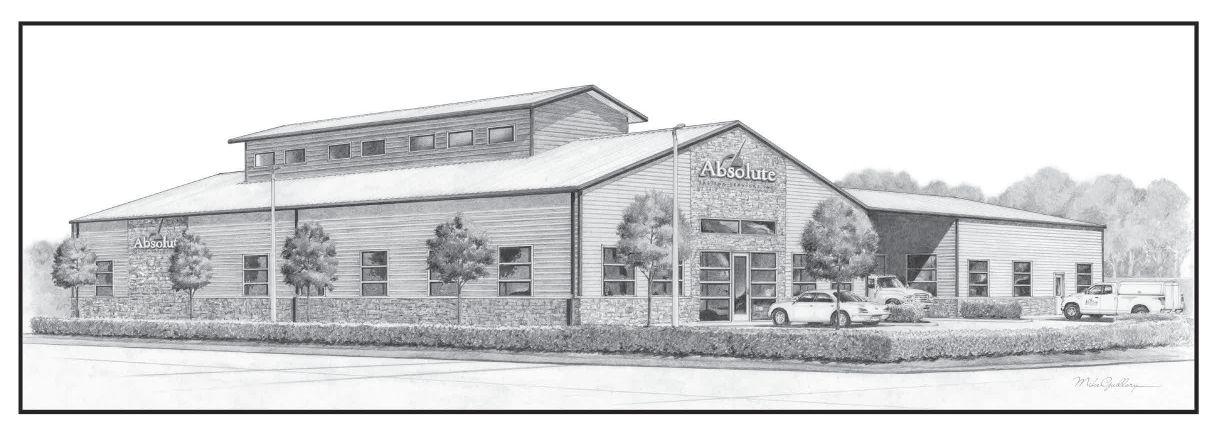
Absolute con dence. Every time.
You can count on us for specialized experience in healthcare, data center, o ce complex, and commercial acceptance and maintenance testing. Absolutely Power generation, petrochemical, oil & gas, and heavy industries also look to us for high demand services such as start-up commissioning, maintenance testing, shut-down and turnarounds, and breaker shop repair. Get started today.



Toll Free 1+ (855)767-4446 8100 West Little York | Houston, Texas 77040 Email: Alan Postiglione | apost@absolutetesting.com | www.absolutetesting.com Like us on:

ENERGY STORAGE SYSTEMS: HAZARDS AND SOLUTIONS
58 • SUMMER 2020 ENERGY STORAGE SYSTEMS: HAZARDS AND SOLUTIONS
FEATURE
May 2019: Utility-scale lithiumion battery energy storage system (BESS) installation at Fort Carson in Colorado. NREL provided an independent review of Fort Carson’s proposed BESS through funding from the U.S. Department of Energy’s Federal Energy Management Program (FEMP). Using its REopt energy optimization and modeling software, NREL verified the batteries’ potential economic savings and helped Fort Carson characterize technology risk.
 BY BRIAN O’CONNOR, National Fire Protection Association
BY BRIAN O’CONNOR, National Fire Protection Association

As energy storage systems (ESS) become more integrated into our society, the National Fire Protection Association (NFPA) provides resources to ensure they are installed safely and that our firefighters are prepared to respond to the safety issues they present. Even though batteries have been around for hundreds of years, new innovations allow us to do more with them than ever before. There is a need for more information about the hazards associated with these technologies, as well as methods to reduce the risks associated with them. NFPA aims to help solve this problem by providing resources in the form of codes, standards, training, and research reports.
An energy storage system, in basic terms, is something that can store energy for use as electrical energy at a later time. An example of this is a battery, and an ESS that utilizes batteries is called a battery energy storage system (BESS). One of the most used battery technologies today is lithium-ion. Although there are many different types of lithium-ion batteries, such as lithium iron phosphate and lithium cobalt oxide, we often refer to them as lithium-ion batteries since they share a lot of commonalities. This article focuses on lithiumion BESS.
NETAWORLD • 59 ENERGY STORAGE SYSTEMS: HAZARDS AND SOLUTIONS
FEATURE
PHOTO SOURCE: DENNIS SCHROEDER, NREL


APPLICATIONS
Many applications help drive the development and production of newer and larger BESS installations.
• A BESS can be used for a practice called peak shaving, where batteries are charged when electrical demand on the grid is low and then discharged when electricity is in high demand. Since electrical prices can fluctuate throughout the day, this gives users the opportunity to buy electricity at a lower price and use that cheap electricity when the price of electricity is high.
• A BESS can supplement renewable energies such as photovoltaic panels (solar panels) or wind turbines. A BESS makes it possible to use electricity generated from these renewable resources when the sun and wind are not present.
• A BESS helps support our electrical infrastructure. When power generation facilities ramp up and ramp down to keep up with the changing demand for electricity, it puts stress on the system. BESS can help flatten out the demand curve by charging when electrical demand is low and discharging when it is high.
• A BESS can be used as a secondary source of power, similar to generators for a building.
With all of these applications and the potential for financial benefits, you can see why BESS use is increasingly common.
HAZARDS
Along with all of these benefits, battery energy storage systems come with some drawbacks due to hazards. Like with all electrical equipment, shock and fire hazard is present. A BESS also has the unique attribute of being able to go into thermal runaway. This is when one cell of the battery rapidly and uncontrollably overheats, often spreading to adjacent cells and usually leading to a high-intensity fire that is very difficult to extinguish.
A BESS also generates toxic and flammable gasses when it goes into thermal runaway. Once a BESS fire is extinguished, there is the risk of stranded energy, where electrical energy is trapped in the unit and is unable to be discharged safely or easily. This is potentially dangerous for those who are combating or cleaning up after the fire, since shock hazard is present. This stranded energy can also lead to

October 2018: NREL researcher Nate Sunderlin holds a lithium-ion battery that has failed after being punctured, next to an intact battery, in an experiment in the Science of Safety Facility in the Materials Characterization Lab at the Energy Systems Integration Facility (ESIF).
60 • SUMMER 2020
ENERGY STORAGE SYSTEMS: HAZARDS AND SOLUTIONS
FEATURE
PHOTO SOURCE: DENNIS SCHROEDER, NREL
spontaneous reignition. A BESS fire is truly a challenge to extinguish.
FAILURE MODES
The batteries in a BESS can fail in several ways, often leading to thermal runaway. Batteries can undergo electrical abuse by being charged or discharged too rapidly or charged at voltage that is too high. Internal faults such as poor design or deficiencies in manufacturing can lead to failure. Another path to failure is environmental impact from seismic activity, animal damage, floods, or extreme heat. Mechanical abuse, such as dropping, crushing, or penetrating the battery can also cause a battery to fail.
NFPA 855
NFPA, in partnership with the Fire Protection Research Foundation (FPRF), has been hard at work the past few years developing resources for those who need it. NFPA is a global advocate for the elimination of death, injury, property, and economic loss due to fire, electrical, and related hazards. To address many of the issues and concerns over BESS, NFPA developed NFPA 855, Standard for the Installation of Stationary Energy Storage Systems. This standard provides requirements for users to be able to design and install ESS. NFPA 855 only applies to installations of a certain size, meaning that this standard isn’t intended to apply to smaller consumer electronics.
Emergency Operations
The standard’s requirements address the need for an emergency operation plan containing elements such as procedures to safely shut down the system, procedures for the removal of a damaged BESS, general emergency procedures, and annual staff training. These requirements are designed to increase preparedness so staff and responders know exactly what they should do in the event of an incident. This is an essential part of emergency management and can help mitigate losses if done correctly.
Equipment
NFPA 855 also contains requirements for all of the components that make up a BESS. In short, all of the individual components must be listed to a specific standard and the system as a whole must be listed. This ensures that the BESS is comprised of safe components that will minimize the chance of an incident occurring.
Location
The impacts of the hazards presented by a BESS can differ based on the location where they are installed. For that reason, NFPA 855 contains different requirements for systems that are installed in various types of locations, which are broken down into two categories: indoors and outdoors. The subcategories of indoor use include dedicated-use buildings, non-dedicated-use buildings, and sleeping/dwelling units. Outdoor locations are subcategorized into remote locations, which are installations that have no exposures 100 feet in any direction, non-remote locations, and rooftop/open parking garages.
Compliance
It is important to comply with all of NFPA 855’s requirements; these are the most impactful when designing and installing a system.
• NFPA 855 requires a BESS to be grouped into 50kWh groupings spaced 3 feet from other groups and walls. The purpose of this requirement is to prevent horizontal fire propagation, which can lead to longduration fires that can overwhelm the water supply. It is worth noting that remote outdoor locations are exempt from this requirement.
• There is a limit on the number of BESS you can install in a fire area before it is considered a high-hazard occupancy. For lithium-ion batteries, this maximum stored energy limit is 600kWh. This requirement is intended to limit the size of a fire in any one area.
• Since early detection and response is key to limiting fire size, smoke and fire detection must be installed in accordance with


NETAWORLD • 61
ENERGY STORAGE SYSTEMS: HAZARDS AND SOLUTIONS FEATURE


Table 1: Recommended Separation of Lithium-ion Battery Energy Storage Systems
NFPA 72. A sprinkler system must also be installed in accordance with NFPA 13, Standard for the Installation of Sprinkler Systems. Several NFPA requirements, such as the requirement for spacing and a sprinkler system, can be altered based on the results of large-scale fire testing done in accordance with specific testing procedures. This is permitted because there is still much we do not know about BESS fires, and the committee of experts who wrote the standard wanted to encourage testing since there is not much publicly available testing data. If users can prove through testing that a different suppression system or a closer spacing can be safe for their installation, NFPA 855 permits those variations from the prescriptive requirements.
Adoption
Now that we are familiar with some of NFPA 855’s requirements, a common question is “how does adoption and enforcement work?” States and jurisdictions are always free to adopt whatever codes or standards they want, but the main path of adoption for many smaller standards is to have them referenced in NFPA 1, Fire Code. Since NFPA 855 was published at the end of 2019, the plan for the next edition of NFPA 1, which is due to be published by the end of 2020, is to both extract and reference NFPA 855. This is when you can expect to see broader adoption of the NFPA 855 standard, although many jurisdictions have already adopted and are enforcing it.
FPRF REPORTS
The FPRF is an NFPA research affiliate whose mission is to plan, manage, and communicate research in support of the association. In the
past few years, the FPRF has carried out many research projects related to BESS, all of which are free for download from the NFPA website. One recent FPRF research report, Sprinkler Protection Guidance for Lithium-Ion Based Energy Storage Systems published in 2019, demonstrated largescale fire testing of BESS units. This research builds upon previous studies that indicate water is the most effective suppressant for combating lithium-ion battery fires. While the study acknowledges the large number of unknowns when it comes to these incidents due to the lack of publicly available data, it attempts to shed light on how these battery systems behave in fire conditions and what effect a sprinkler system can have. Two types of lithium-ion batteries were involved in the testing: lithium iron phosphate (LFP) and nickel manganese cobalt oxide (NMC).
Both of these chemistries underwent a series of tests including small-scale, intermediate-scale, and large-scale free-burn fire testing. The smaller-scale tests were helpful in predicting how the large-scale batteries would burn as well as the likelihood of spreading to adjacent exposures. In addition to free burns, this study also conducted large-scale fire testing with an installed wet-pipe sprinkler system to study the effects of the sprinkler system on a lithium-ion battery fire. The final results can be found in the report, but in summation, the two battery chemistries demonstrated significantly different heat output and an ultimately different protection recommendation as shown in Table 1. This reinforces the need for more publicly available test data since it will be difficult to find a one-size-fits-all solution to BESS fires.
FIRST RESPONDER TRAINING
In addition to research and standards development work, NFPA has developed training
62 • SUMMER 2020
ENERGY STORAGE SYSTEMS: HAZARDS AND SOLUTIONS INDUSTRY
TOPICS
Battery Technology Object Combustibility Sprinklered Non-sprinklered NMC Combustible 2.7 m 4.0 m Noncombustible 1.8 m 2.4 m LFP Combustible 1.5 m 1.8 m Noncombustible 0.9 m 1.2 m
for first responders that is available online and in person. The goal of this training is to educate first responders on the basics of ESS and solar panels as well as the hazards they can present. This training also addresses tactics and pre-incident planning. NFPA has made this training available for free to first responders. If their jurisdiction includes ESS and/or solar panel, they now have a resource to help them stay safe by adequately preparing and training for these incidents.
CONCLUSION
With all of the environmental, financial, and infrastructure benefits that a BESS can provide, it is safe to say this technology is here to stay and is being embraced globally. NFPA continues to ensure the availability of reliable information and resources for the community to ensure we continue to enjoy the benefits of new technologies while being prepared for any emergency situations that might occur.

NFPA’s guiding principal is “It’s a Big World. Let’s Protect It Together.” This is not a slogan. It is a call to action for all of us. In this instance, it is a challenge to learn all you can about BESS, the fire protection systems and strategies that can reduce hazards, and the response techniques that will keep buildings, workers, occupants, and first responders safe.

Brian O’Connor, PE, is a Fire Protection Engineer at the National Fire Protection Association (NFPA), where he is the staff liaison to several technical committees covering topics such as aviation, portable extinguishers, water-based fire protection, energy storage systems, and health care facilities. He is also Vice President for the New England Chapter of the Society of Fire Protection Engineers. Brian is a Professional Engineer registered in the states of Texas and Massachusetts. He earned his BS in mechanical engineering from Rowan University and an MS in fire protection engineering from the University of Maryland.

Industrial Electric Testing, Inc.
• Cables
• LV/MV Circuit Breakers
• Rotating Machinery
• Meters
• Automatic Transfer Switches
• Switchgear and Switchboard
Assemblies • LV/MV Switches
• Relays - All Types
• Motor Control Centers
• Grounding Systems
• Transformers
• Insulating Fluids
• Thermographic Surveys • Reclosers • Surge Arresters
• Capacitors
• Batteries
• Ground Fault Systems
• Equipotential Ground Testing
CoNSulTING AND ENGINEERING SERvICES
• Load Studies
• Transient Voltage Recording and Analysis • Electromagnetic Field (EMF) Testing
Harmonic Investigation • Replacement of Insulating Fluids
Power Factor Studies

EC13004105 • 24 Hour Emergency Service ACCEPTANCE AND MAINTENANCE TESTING AND REPAIR
11321 West Distribution Avenue • Jacksonville, Florida 32256 • (904) 260-8378 201 NW 1st Avenue • Hallandale, Florida 33009 • (954) 456-7020
•
•
Huge Selection of In-Stock Electrical Equipment




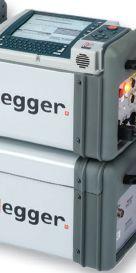


Protective Relays
Transformers & Motor Analysis
Partial Discharge/Corona
Current Injection
Cable Fault Location
ADVANTAGES OF RENTING
Cost-Savings Versus Buying
Available for Immediate Delivery
SPECIAL TEST EQUIPMENT FOR
Top-of-the-Line Products
Always Calibrated Equipment


ISO 17025 / NIST Cal / ANSI Z540










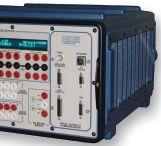




Switchgear/Circuit Breakers
Insulation Resistance
Tan Delta/Power Factor
• Current Transformers
• Ground Grid
Choose From a Variety of Manufacturer’s
Short-term Solutions for One-Off Tests






Start Saving Today! www.atecorp.com 800-404-ATEC (2832)


ARC FLASH MAINTENANCE:


© ISTOCKPHOTO.COM/PORTFOLIO/WANGANQI
BY KERRY HEID, Shermco Industries
Not all equipment is created equal when it comes to production objectives versus safety objectives in an electrical power system. Certain devices should be tested and maintained to ensure uptime; others should be inspected to ensure they perform properly to protect workers in an arc flash event. When considering arc flash safety and selecting the associated PPE, the condition of maintenance for protective devices or circuit breakers is certainly much more critical than for a conductor or load device. Evaluating each piece of power system equipment for its impact on productivity and safety is clearly important.
66 • SUMMER 2020 ARC FLASH MAINTENANCE: NOT ALL EQUIPMENT IS CREATED EQUAL
FEATURE
PHOTO:

Whether using an arc flash study, the table method, or another process to determine arc flash values, PPE selection is based on a value for incident energy. Incident energy values are based on a combination of circuit clearing time, distance from the source, and the amount of arcing current in Amperes (among other factors).
Since clearing time is one of the direct critical factors, every single PPE selection is based on the equipment operating speed. In an arc flash study or other method, this speed is based on the equipment’s time current operating characteristics to be in like-new condition. Even equipment that operates a fraction of a second slower can cause
arc flash values to be substantially higher than anticipated or indicated on a label.
What does this mean? A worker can believe the incident energy is single-digit calories and dress accordingly. However, the actual clearing time of the unmaintained upstream device can cause this value to be hundreds of calories. Not verifying clearing times essentially makes the arc flash label or table method of PPE selection invalid.
Condition of maintenance is now a key consideration in the overall risk assessment process. But how does this affect worker safety and PPE selection? A 2008 paper on IEEE ESW-2008-21 by Ron Widup and Kerry Heid used survey data from NETA members with results from over 340,000 protection devices. With service-aged equipment, approximately 22% of circuit breakers had an issue with the protective trip unit. Experience tells us that trip units usually operate slower, not faster, so the arc flash energy values downstream of these devices are higher than expected. Even more alarming: 10.5% of circuit breakers would not trip at all, and 42.8% of these problems were mechanical. A circuit breaker that has not operated in years may not operate at all when called upon during an arc flash event. An inoperable protective device will create a high probability of extreme values of incident energy. It’s a scary scenario when selecting PPE.
Table 1 lists six asset classes that must be considered differently based on production versus safety objectives. Items such as cables, rotating equipment, and transformers can have a huge negative effect on production but typically aren’t as likely to create a major safety risk. However, power systems apparatus such as circuit breakers, protective relays, and DC
Table 1: Typical Power System Apparatus Affecting Productivity/Uptime vs. Safety
NETAWORLD • 67 ARC FLASH MAINTENANCE: NOT ALL EQUIPMENT IS CREATED EQUAL
FEATURE
Productivity / Uptime Safety Cables Circuit Breakers Rotating Equipment Protective Relays Transformers DC Tripping Power
FEATURE

Figure 1: Heat Map

tripping power can directly affect electrical arc flash values and PPE selection. The Canadian standard CSA Z463, Maintenance of Electrical Systems states that these critical safety devices must be included in the electrical maintenance program. The type and interval of maintenance is left up to each individual user based on the installation and operating environment. Production devices can be maintained at a different level based on the business decision by the organization, but devices that negatively affect electrical safety cannot be ignored.
Productivity and uptime can be drastically affected by these items. Failure of these devices can cause power outages or lost production for days and even weeks depending upon the ability to replace or repair them. This will have a major financial impact on the organization, but
typically, a limited impact to personnel safety. Note that the devices above in the Safety column can also affect production/uptime.
The items listed under Safety can fail without anyone knowing they failed and thus won’t operate to clear a fault, but production continues on as normal. Failure of these devices to trip and limit the energy during an arc flash event creates a huge increase in the risk to the worker. These failures are normally only found during maintenance or when a fault occurs. For example, a transformer fire could be dangerous to workers. But what is the likelihood that a transformer would fail with someone standing directly beside it? In addition, for a transformer to catch fire or to catastrophically fail would mean the protection failed, so the risk is associated with the protection, not the actual transformer failure.
68 • SUMMER 2020
ARC FLASH MAINTENANCE: NOT ALL EQUIPMENT IS CREATED EQUAL
Likelihood Impact Heat Map B1 Molded-Case Circuit Breaker 4.2 2.4 10.08 B2 Air Circuit Breaker (LV) 3.8 4 15.2 T1 Oil-Filled Transformer 1.9 1.8 3.42 R1 Overcurrent Relay 3.8 4.5 17.1 Likelihood Impact Heat Map D1 DC Battery System 2.2 4.6 10.12 F1 Fuses 2.1 3.9 8.19 C1 Low-Voltage Cable 0.8 0.5 0.4 C2 Medium D1 Voltage Cable 1.6 1.1 1.76 Neglible Rare Unlikely Possible Likely Almost Certain Likelihood Impact Minor Moderate Major Extreme

ELECTRICAL SAFETY HEAT MAP
CSA Z463, Maintenance of Electrical Systems features a heat map analysis in Annex C (Figure 1). Maintenance for safety objectives can be completely different than those for production objectives. This is exactly what the safety heat map establishes for separate asset classes. This system establishes unmaintained equipment in the green (low-risk), yellow (moderate-risk), and red (high-risk) zones for their effect on the electrical safety program.
Each piece of apparatus has a different risk factor for production and for safety, and it’s typically a business decision for production or uptime versus a safety decision for equipment that poses a risk to personal safety. The values in the tables are subjective and need to be aligned with the installed equipment vintage, loading, fault interruptions, operating environment, and apparatus manufacturer to rate the likelihood and impact of failure.
The safety heat map plots the likelihood of an occurrence versus the impact the device would have on worker safety should it become inoperable (Figure 1).
• Likelihood is the chance the equipment would not work as intended (mis-operate) if it was completely ignored over a lengthy in-service period.
• Impact is the potential exposure to a worker should the equipment not work as intended.
Low-Voltage Air Circuit Breaker: High Risk
The on-board protection system in a lowvoltage air circuit breaker (LVACB) includes a series trip unit or an electronic trip unit consisting of current transformers, wiring harness, protective relay, and some type of mechanical actuator. Maintenance staff must operate it on a regular basis to create an electrically safe working condition. When not exercised on a regular basis, these devices can
become inoperable without warning. Because they are rackable, frequently operated, and include a complete on-board protection system, the likelihood and impact variables on these devices are some of the highest in the electrical power system. As noted earlier, a 2008 NETA survey and associated IEEE paper showed that 22% of these breakers did not follow their time current characteristics, and 10.5% did not operate at all when service-aged maintenance was undertaken.
Power Fuse: Moderate Risk
Power fuses are protective devices that have no movable parts and are generally very reliable. However, they can create extended clearing time above expectation if not applied properly following a replacement-in-kind process. Electrical workers commonly replace a fuse with one that is adequate for the loading level but is not the correct size or rating as designed in the power system study or arc flash hazard analysis. This can create a much higher arc flash value than anticipated.
Buried Underground Cable: Low Risk
Buried underground cable has limited arc flash risk and associated PPE level because the likelihood of failure and impact to personal safety are both very low. These devices have no moving parts and are highly reliable if installed correctly. The likelihood of a failure is typically very low, and the impact this device could have on safety during a failure is quite low.
As seen is these examples, the attention paid to maintenance depends on the likelihood the equipment will fail and the impact that it will have on worker safety. Power systems equipment that is more likely to fail and have a higher impact must be included in the electrical maintenance program due to the serious safety concerns it can bring.
An arc flash hazard analysis will usually indicate that protective setting changes can reduce the
NETAWORLD • 69
FEATURE
ARC FLASH MAINTENANCE: NOT ALL EQUIPMENT IS CREATED EQUAL

incident energy values and thus lower the level of PPE required. However, if these protective devices do not function as designed due to a lack of maintenance, the new energy levels are invalid and render the PPE assessment inadequate. Arc flash studies should always indicate that any setting changes made to lower incident energy require testing of the devices to ensure they follow their time current characteristics.
CONCLUSION
Certain apparatus in a power system can have a drastic negative impact on incident energy evaluation and the associated level of required PPE when not maintained properly. Field test data shows that a lack of maintenance can severely affect the operation of protective devices. Any item that can directly extend the tripping time of a protection system needs consistent maintenance and testing to ensure it operates according to its specified time current characteristics. PPE selection is completely

dependent on this equipment working properly, and an electrical maintenance program is critical to this operation.

Kerry Heid is an Executive Consultant at Shermco Industries, a leader in electrical power systems reliability, engineering, and field services. After beginning his career with Westinghouse Service, Kerry founded the Magna Electric Corporation (MEC) office in Regina, Saskatchewan, in 1996 and became President of the company in 2001. The company grew to over 1,000 employees and won many awards as one of Canada’s 50 Best Managed Companies and Canada’s Top 100 Employers. MEC was acquired by Shermco Industries in December 2013, and Kerry served as CEO of Shermco Industries Canada until 2019. Kerry is a NETA Certified Level IV Technician and is active in Canadian standards development. He has served as Chair of the CSA Z463, Maintenance of Electrical Systems technical committee since 2010, as a member of the CSA Z462, Workplace Electrical Safety technical committee since its inception in 2006, and received the prestigious Award of Merit from the Canadian Standards Association in 2019. Kerry served on NETA’s Board of Directors from 2003–2014, is a past-President, and received NETA’s Outstanding Achievement Award in 2010.


Accredited Company 204 Gale Lane Kennett Square, PA 19348 484.731.0200 enerGtest.com Serving clients in Pennsylvania, Delaware, New Jersey, Maryland, Washington, DC and New England. We deliver optimum system reliability and performance while reducing the chances of costly unplanned power outages. Whether you need acceptance ener es testing or preventive maintenance, depend on EnerGTest to keep the power on. Reliable Power System Solutions www.BurlingtonSafety.com info@BurlingtonSafety.com Browse and Buy Online Now! Metro NY/NJ/PA 800-220-2120 Calif (SF) 888-817-1412 Calif (LA) 800-296-2803 Your Source for NFPA 70E Compliant Protective Gear Accredited Proof Testing Laboratory Services Rubber Gloves ◆ Sleeves ◆ Blankets ◆ Line Hose Footwear ◆ Jumpers ◆ Hotsticks
FEATURE



MARCH 8 – 12, 2021 ROSEN SHINGLE CREEK ORLANDO, FLORIDA POWERTEST.ORG 888.300.6382 SAVE THE DATE THE PREMIER ELECTRICAL MAINTENANCE AND SAFETY CONFERENCE HOSTED BY


















 BY MIKE DOHERTY, eHazard
BY MIKE DOHERTY, eHazard









WHERE THE RUBBER HITS THE ROAD
Electrical workers, supervisors, and managers are instinctively aware that getting to the root cause of electrical incidents involving the safety of their people and/or the integrity of their equipment requires insightful questions. Failure to find the foundational root cause is a tragedy that compounds the incident itself. Unfortunately, if the first question asks, “Why did it happen?” the answer often has very little to do with the actual root cause.
72 • SUMMER 2020 HUMAN PERFORMANCE IN ELECTRICAL SAFETY: WHERE THE RUBBER HITS THE ROAD
PHOTO: © ISTOCKPHOTO.COM/PORTFOLIO/NEWANNYART










ROOT CAUSE





Calmly and respectfully asking all concerned personnel five or six “why” questions in an ordered fashion will almost always lead to one answer: Human performance followed inadequate best practices. It is guaranteed that the fifth or sixth answer will not be the same as the first answer. If a blame culture is prevalent in the organization, the “why” questions stop very quickly. However, asking “why” as many times as it takes usually points to latent organizational weaknesses, which in turn uncover the fact that the workers involved, the supervisor, and the management system all take some percentage of accountability for the incident.
The first thing the investigation management team must ask themselves is whether any blame will be assigned in this incident. In a strong business and safety culture, the answer is most often “No.” Blame should only be assigned for truly willful and negligent behaviors, which is rarely the case. W. Edwards Deming, a leading management thinker in the quality field, said, “A bad system will beat a good person every time.” Not assigning blame makes it possible to identify the common situations and causes of the incident. Deming also noted, “If you do not know how to ask the right question, you discover nothing.”
These causes and situations can be addressed with human performance tools. For example, in March 1962 in Binghamton, New York, six babies died at General Hospital by salt poisoning. Thirty babies were fed a formula containing salt instead of sugar as a result of a mix-up in filling a nursery container in the main kitchen where large containers of salt and sugar were side-by-side. The containers had significantly worn labels, and the room was dimly lit. Certainly, storing these substances beside each other was an error — a likely situation just waiting to happen. As always, it is far easier to be smart after any incident, but in February 1967, salt instead of sugar was added to the milk formula intended for babies in the newborn nursery of a hospital in suburban Sydney, Australia. Four died; one












less severely affected baby made a complete recovery. Unfortunately, there was no Internet back then, and the ability to learn from other tragedies was far less prevalent.
LEARNING CULTURE
One way to achieve best-in-class safety and business is to become a learning organization. And one of the best ways to ensure a learning culture is in place is to benchmark against the very best, especially within your sector. Many human performance opportunities have been established by benchmarking the medical industry, where human performance challenges are always prevalent. Based on benchmarking the U.S. airline industry in the 1980s, we know that airline travel is one of the safest methods of travel. The U.S. Department of Energy (DOE) has also been a significant leader in human performance knowledge and best practices. A simple Google search for the DOE and human performance will reveal significant and easily accessed information.
One group that sincerely believes in being a learning organization and using benchmarking as a best practice is the U.S. Navy nuclear submarine group. They clearly understand that an error at any stage of their operations benefits no one, and they advanced human performance best practices and tools as they studied, learned, and benchmarked from others.
When their service in U.S. Navy nuclear submarines ended, many found new careers in U.S. nuclear power plants that believed strongly in being learning organizations, and they improved and implemented the use of leading-edge human performance tools as robust parts of every work plan.
A few of these managers found their way to the Canadian nuclear power plant fleet. Along with intensive World Association of Nuclear Operator (WANO) mandatory audits, the culture of human performance best practices as sourced from the medical and airline industries and the U.S. Navy nuclear submarines found its way into Ontario’s nuclear power plants.



NETAWORLD • 73 HUMAN PERFORMANCE IN ELECTRICAL SAFETY: WHERE THE RUBBER HITS THE ROAD
FEATURE





















STANDARDS




In 2012, Canada’s CSA Z462, Workplace Electrical Safety Standard Technical Committee began to plan and organize their 2015 edition. At the request of someone who worked in those nuclear power plants, a serious discussion was held regarding a potential annex for human performance. It took a little persuasion, but the decision was made to bring together a group of committed experts, and Informative Annex U: Human Performance & Workplace Electrical Safety was added to CSA Z462 in time for the 2015 edition.
Annex U is one of the jewels of CSA Z462. When people get hurt from electrical energy, they don’t want it to happen again. If you ask “why” enough times, you will inevitably find a situation caused by a less-than-adequate human-performance error at some level.
The CSA Z462 Technical Committee entered a Public Input (PI) into the NFPA 70E system in time for the 2015 edition, but it was not accepted; however, the 70E Technical Committee did accept this PI in its 2018 edition. Now that human performance best practices are strongly in place across North









America, it is an important best practice for leading-edge electrical business units. The higher-voltage utility sector has also made concerted eff orts to embrace human performance tools and best practices in the last few years.
Many concepts and theories within the realm of human performance are discussed in the electrical sector. Electrical people are practical and pragmatic. While they enjoy the theory up to a point, they like to get things done in a hands-on manner. One challenge has been turning human-performance information into something that can be used on a day-to-day basis in quality job planning.
In 2018, ISO issued a new health and safety management system standard that supersedes OHSAS 18001, CSA Z1000, and ANSI Z10 in many workplaces. ISO 45001, Occupational Health & Safety outlines requirements for OH&S management systems, gives guidance for use, and helps business units provide healthy and safe workplaces. Any good electrical safety program can and must be established on the foundation of a health and safety management system. A company’s electrical safety program should be a subset of the overall health and safety program along with any other hazards that exist in a specific workplace.
SAFETY CYCLE
W. Edwards Deming crafted the basic architecture for health and safety management systems: Plan, Do, Check, Act. Th e basic premise is one of continual improvement. One last quote from Deming has always been true: “All organizations are perfectly aligned to get the results they get.”
An adaptation of the similar structure (Figure 1) emphasizes the importance of a strong safety management system foundation. The safety cycle includes most components of a safety management system. All subsets including the electrical safety program, risk assessments, training, investigations, audits,




74 • SUMMER 2020
HUMAN PERFORMANCE IN ELECTRICAL SAFETY: WHERE THE RUBBER HITS THE ROAD
Figure 1: Safety Cycle
SOURCE: EHAZARD
















and maintenance are impacted negatively if practical human performance tools (not just concepts) are not established on a day-to-day basis.
HUMAN PERFORMANCE TOOLS
A critical finding by a leading-edge Ontariobased nuclear power plant was to focus on a lower number of human performance tools rather than using too many. They found that concentrating on approximately four effective human performance tools was significantly more efficient in day-to-day planning of safe and timely work tasks.
Here are four examples of opportunities to work a few human performance tools into dayto-day work planning under the umbrella of safety management system principles. Others may also work well within your organization.
Envision
The Job Safety Planning sections of CSA Z462 and NFPA 70E may be the most valuable parts. Job safety planning shall be completed by a qualified person; it shall be documented, describe the job and the hazards, and include shock and arc flash risk assessment procedures. Work procedures, precautions, and lockout/tag out provisions are also required. A strong and robust electrical safety program ensures these planning components are an integral part of the safety management system.
In many businesses, routine management Task Demands are an Error Precursor that prevents the development of a robust electrical safety program. It is critical to understand that less-than-adequate human performance issues are not just a worker concern. Workers, supervisors, middle managers, and senior executive teams may have similar human performance weaknesses within the tasks in their purview.
Th e human performance tool of Effective Communications may not be practiced by













the upper managers who are most accountable to ensure that an eff ective electrical safety program is in place. They must listen to the best practices coming from the electrical sector, their competitors, and their regulators and take advantage of the learning opportunities as they practice benchmarking throughout their sector.
Execute
Execution of daily job safety planning is where the rubber does hit the road. Staff must get the job done safely and on time. A strong case can be made for any number of Error Precursors at the execution phase of any electrical task:
• Individual Capabilities to execute any job can be a significant error precursor. As we all know, many very experienced long-term employees are retiring and will continue to leave the current workforce in droves over the next few years. It is not uncommon to have older workers plus lots of new and younger workers but not very many in between. Comprehensive and effective training on shock and arc flash risk assessment procedures as core competencies is critical. These skill sets can absolutely affect the execution of work.
• STOP When Unsure is a valuable mandatory human performance tool. This must come from the very top of the organization. Everyone from managers on down must understand clearly that is it okay and expected to stop when you’re not sure. When people don’t feel comfortable doing this, execution of a work task is going to exhibit significant problems sooner or later. It is a basic human performance tool of great worth.
Evaluate
Th e third and often overlooked section of the cycle is evaluation and audit. When a supervisor or middle manager is asked “Are your staff working safely?” the inevitable answer is “Yes, I watch them do it all the time.” That is an outstanding — and correct — answer, but the second question is “Have you documented



NETAWORLD • 75
HUMAN PERFORMANCE IN ELECTRICAL SAFETY: WHERE THE RUBBER HITS THE ROAD FEATURE

























your evaluation?” A classic truism for safety is that if it hasn’t been documented, it didn’t happen. Documented evaluations or audits are facts. Opinions and verbalizations are not.
Work Environment is a classic error precursor in the evaluation process. A work environment that does not document evaluations is not best in class. Any evaluation in the workplace must be done in a respectful, professional manner not underlined by a blame culture. Procedural Use and Adherance is an effective tool to document evaluations and audits and follow up on a comprehensive corrective action plan (CAP). A CAP clearly states the problem, how it is to be corrected, and who will correct it. It names a specific deliverable date and the manager accountable to ensure it all happens as documented. This is Management 101.
Evolve
The last important segment of the continuous cycle of human performance opportunities is constant evolution of management actions based on observations in the evaluation segment. The evolution of management actions is very important in the feedback loop within a health and safety management system. CSA Z462 and NFPA 70E are nicely aligned with this cycle as perfectly described in ISO 45001.
Human Nature must be understood as a human performance error precursor at this management stage. It is human nature to get very busy doing all the right things but not








follow up. Procrastination is common. Once electrical safety improvements have been planned, executed, and audited, they must be diligently maintained and followed up. Repeat Back is an outstanding tool at this stage. Senior management repeats back exactly what was stated and agreed to in the audit CAP. Repeat backs provide clarity versus murkiness or vagueness.
CONCLUSION

Maintenance of the electrical health and safety management system is driven by the continual improvement process of Envision, Execute, Evaluate, and Evolve. Maintaining your safety cycle by understanding the value of human performance tools in day-to-day operations will fill in what every worker, supervisor, manager and senior executive team instinctively knows: Human performance is where the rubber hits the road.
Mike Doherty is President of Blue Arc Electrical Safety Technologies Inc. He has 45 years of industrial and electrical utility experience as an instrumentation technician, licensed electrician, training professional, electrical utility safety professional, and electrical safety consultant. Mike is an IEEE Senior Member; Chair of ULC CAN/ULC-S801, Standard on Electric Utility Workplace Electrical Safety for Generation, Transmission and Distribution. He was Chair of CSA Z462 Technical Committee Workplace Electrical Safety Canada from 2006–2018 and continues to serve as a voting member. Mike received the 2019 IEEE Electrical Safety Workshops Outstanding Service Award.




76 • SUMMER 2020
HUMAN PERFORMANCE IN ELECTRICAL SAFETY: WHERE THE RUBBER HITS THE ROAD
















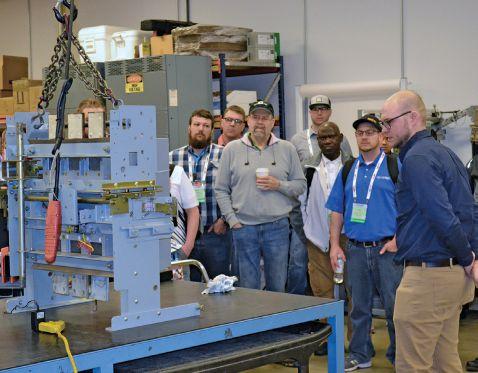










•







• System parameters based on measurements of thousands of












Search. Click. Ship. Purchase AEAMC equipment online, anytime! Emergency support 24/7 800-289-2757 Advanced Electrical & Motor Controls 1801 HURD DR. | IRVING, TX 75038 | 972-253-7783 | Sales@AEAMC.com | AEAMC .com 455-B SHEPARD DRIVE | ELGIN, IL 60123 | 224-856-5036 CHICAGO SERVICE CENTER NOW OPEN!
Insulated Case Circuit Breakers
Molded Case Circuit Breakers
Motor Controls & Centers
Bolted Pressure Switches
Panelboard Switches & Bus Plugs 480 V Distribution Transformers Replacement Parts New Replacement Motor Control Buckets
can provide and
the following:
a single part to a switchboard lineup, Advanced Electrical & Motor Controls’ inventory of low-voltage insulated case circuit breakers, molded case circuit breakers, motor controls, and custom switchboards are second to none in the U.S. No matter what you need — new, surplus, used, or reconditioned power distribution equipment, testing and repair, or an engineered solution — AEAMC will keep you up and running. In Stock for Emergency Delivery: New Switchboards up to 4000 amps; New Motor Controls No One Knows Low-Voltage Circuit Breakers & Motor Controls Like Advanced Electrical & Motor Controls Chicago, IL VacuumInterruptersInc
vacuum
predicting
life
We
repair
From
Industry’s first portable
interrupter test system capable of
remaining
• World’s first system capable of testing vacuum interrupters in both the shop and field
Analysis based on same OEM leak-rate test performed at the factory
The world’s only predic T i ve vacuum in T e rrup T e r T e T se T WHEN PASS/FAIL ISN’T MAC-TS4 com vacuum interrupters Info@VacuumInterruptersInc.com 13765 Beta Road, Farmers Branch, TX 72544 | Phone: 241-442-5877


BEST PRACTICES FOR SAFE RETURN TO SERVICE FOLLOWING MAINTENANCE OUTAGE
BY CHARLES M. M c CLUNG, retired, and RUSSELL R. SAFREED, CBS ArcSafe
Returning electrical equipment to service after a planned maintenance outage creates a unique set of hazards. Facility managers are under stringent time constraints when taking a system out of service, performing necessary maintenance tasks (as well as making unanticipated repairs), and returning the system to service. Common, real-world factors may place workers at great risk as the system is returned to service. is article identi es those factors and presents logical and practical ways to decrease or eliminate risks.
IT’S ALL A SETUP WITH GOOD INTENTIONS
Most well-run, progressive companies readily accept that their electrical distribution system is fundamental to the operation of their facilities. Maintaining electrical equipment is thus not an option — it is a must, not merely from an operational-continuity perspective, but also from a loss-prevention perspective. Delaying the restart of a manufacturing process after a planned maintenance outage because of schedule creep or scope creep can be costly. Extended outages caused by major equipment failure can be devastating.
As important as these economic factors are, preventing a life-altering injury or death trumps all economic incentives. Few would disagree that protecting people is also a form of loss prevention. Aside from an employer’s moral responsibility to protect its workers, failure to adequately protect people can result in signi cant economic losses in the form of OSHA nes, medical payments, higher workers’ compensation premiums, and litigation.
Electrical maintenance outages are stressful for everyone concerned. e plant manager just wants it to be over so operations can return to normal as soon as possible. e electrical distribution engineer wants the greatest
78 • SUMMER 2020 BEST PRACTICES FOR SAFE RETURN TO SERVICE FOLLOWING MAINTENANCE OUTAGE
INDUSTRY TOPICS
amount of work possible done in the allotted time to ensure he never has to answer to the plant manager for an unplanned outage. The maintenance crew wants to be thorough and do a good job, but they also know the criteria for deeming a job well done: returning the system to operation on time, with just enough bad news about the condition of the equipment to justify the expense of the outage, but not so much bad news that a restart is delayed or significant repairs are necessary.
All these real-world pressures and competing objectives can produce a high-risk situation when the time comes to re-energize an electrical system following a planned maintenance outage.
RISK SCENARIOS
Risk-creating scenarios fall into three major categories.
Equipment Deficiencies
Although the objective of a maintenance outage is to extend the life of the equipment and promote safe and reliable operation, the opposite is sometimes the outcome. Humans perform maintenance tasks. Humans make mistakes. Even the best technicians become distracted and fatigued.
Recently, a facility owned by a Fortune 500 company experienced a serious arc blast event because a blown current-limiter sensing wire was left disconnected on one end. When the breaker was returned to service, the lead contacted a grounded surface and an arc blast ensued.
But not all equipment defi ciencies in this realm are caused by careless acts. Particularly in older facilities, experience has shown dated medium-voltage cables frequently fail upon reenergization after being de-energized for several hours. Several mechanisms can cause this failure. Water absorption through insulation treeing and thermal cycling is perhaps the most common.


Electrical maintenance outages are stressful for everyone concerned, but proper routine maintenance can help prevent costly unexpected outages.

NETAWORLD • 79 BEST PRACTICES FOR SAFE RETURN TO SERVICE FOLLOWING MAINTENANCE OUTAGE
INDUSTRY TOPICS

INDUSTRY TOPICS

Outdated facilities and equipment can result in unexpected outages or failure to successfully re-energize after a planned maintenance check.
Tools Left Behind
Leaving a tool behind in an area where it could initiate a fault is not uncommon. Even surgeons, some of humanity’s brightest, most-educated, and best-trained individuals, sometimes make similar mistakes.

In electrical equipment, a left-behind tool may not immediately present a problem. It may take the jarring of a breaker operation to dislodge the tool from its resting place into a position where it creates a fault. Keep in mind: It’s not only good operating practice to inspect for tools and such before re-energizing — it’s the law. Still, despite workers’ best efforts, mistakes occur.
Tyranny of the Urgent
During a planned maintenance outage, the tyranny of the urgent is ever present. This may include the rush to complete maintenance testing, quick evaluation of test results, foregoing some
maintenance activities to meet the appointed time for re-energizing, and the temptation to cut corners. The list goes on and on.
In the end, one is left wondering: Was some key piece of information misinterpreted? Was the insulation resistance too low to re-energize? Can the equipment be safely returned to service?
According to OSHA 1910.333(b)(2)(v)(A):
A qualified person shall conduct tests and visual inspections, as necessary, to verify that all tools, electrical jumpers, shorts, grounds, and other such devices have been removed, so that the circuits and equipment can be safely energized.
MITIGATION
Communication is key. Hazards such as incident energy must be understood and quantified.
80 • SUMMER 2020
BEST PRACTICES FOR SAFE RETURN TO SERVICE FOLLOWING MAINTENANCE OUTAGE
This begins with fostering a culture that does not tolerate risk-taking.
A well-conceived and well-written return-toservice plan is essential to avoiding mishaps. A person familiar with the facility and knowledgeable about its electrical systems and the associated hazards must perform such planning ahead of time. The plan should include a detailed sequence of operations for energizing the system. Responsibilities should be clearly assigned and understood.
An often-overlooked component of a returnto-service plan is contingency planning. Plans should take into account procurement of
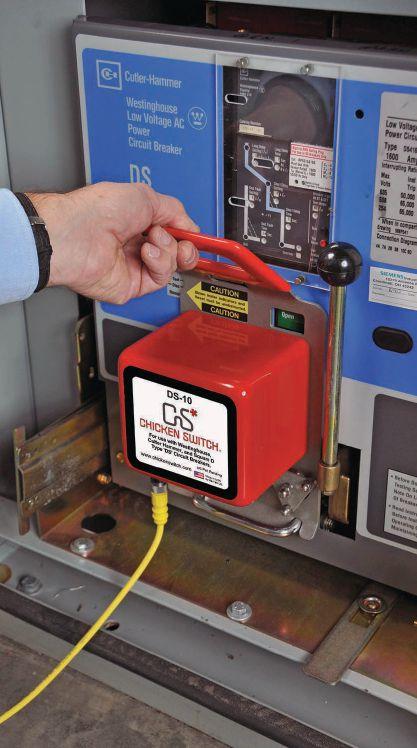
A remote operator is an effective and economical means to protect workers by giving them a method to stay clear of arc flash hazard boundaries while performing electrical switching operations and racking.
repair/replacement components, availability of supplemental skilled manpower, inclement weather contingencies, and the availability of temporary equipment such as compressors, pumps, and generators.
Solid return-to-service plans also utilize proper safety-related work practices. The plan should specify the appropriate personal protective equipment (PPE). When PPE is not sufficient, portable remote racking and control solutions are an alternative, as they mitigate not only the thermal effects of an arc blast, but also the hazards of shrapnel, vaporized metals, and flying debris.
Effective plans can also inventory and make workers aware of the safeguards already built into the facility, such as maintenance switches that temporarily lower breaker settings or permanently installed remote controls.
When it comes to operating discipline, avoid or minimize the time of closed-transition switching (temporarily paralleling two sources to supply a load from a different source without interrupting the load in the process). This situation may subject switchgear to a fault current that it cannot withstand or interrupt.
As a rule, inspect for foreign objects and stay clear when re-energizing. The law sums it up well:
• 1910.333(b)(2)(v): These requirements shall be met, in the order given, before circuits or equipment are reenergized, even temporarily.
• 1910.333(b)(2)(v)(A): A qualified person shall conduct tests and visual inspections, as necessary, to verify that all tools, electrical jumpers, shorts, grounds, and other such devices have been removed, so that the circuits and equipment can be safely energized.
• 1910.333(b)(2)(v)(B): Employees exposed to the hazards associated with reenergizing the circuit or equipment shall be warned to stay clear of circuits and equipment,


NETAWORLD • 81
INDUSTRY TOPICS
BEST PRACTICES FOR SAFE RETURN TO SERVICE FOLLOWING MAINTENANCE OUTAGE

CONCLUSION
Returning electrical equipment to service is a potentially hazardous task, with risks increased due to time pressures. Equipment deficiencies, human error, time pressures, and poor judgment all increase the probability of an incident. Understanding these increased risk factors and having a good mitigation plan will go a long way toward reducing these risks.

Charles Mark McClung began as an electrician apprentice with Union Carbide Corporation in 1974. After working 12 years as an electrician, he held various management and technical positions in plant maintenance and utility distribution. After a 35-year career, he took early retirement to devote his full attention to the development, manufacturing, and marketing of electrical safety devices. He founded Martek Limited, which was acquired by CBS ArcSafe in 2018.

Russell R. Safreed, PE, has been General Manager at CBS ArcSafe’s West Virginia location since CBS ArcSafe acquired MarTek Limited in 2018. Prior to this acquisition, Russ co-owned MarTek Limited, the company that invented the well-known remote pistol-grip switch actuator dubbed the Chicken Switch. Russ earned his BS in electrical engineering at the West Virginia Institute of Technology in 1987. He began his engineering career as a co-op student with Virginia Power in 1983 and has since gained a wide range of practical engineering experience with companies such as Union Carbide, Brown Electric, Aker Solutions, and DuPont. He has been responsible for the operation of power distribution systems ranging from 480 to 46,000 volts and has led the design of electrical projects for chemical manufacturing and power plants. He has held positions covering all facets of industrial electrical systems from designing substations and substation installation to the operation and maintenance of those stations. Today, he uses his skills and experience to lead the design of safety products used to remotely operate breakers outside the arc flash boundary.








INDUSTRY TOPICS
Independent Electrical Testing and Preventive Maintenance PROFESSIONAL SERVICES • Acceptance Testing • Planned Electrical Testing and Preventive Maintenance Programs • Power Factor Testing • Cable Testing • Relay & Meter Calibration • Ground Resistance Testing • Transformer Oil Analysis, Vacuum Degassing and Repair • Circuit Breaker Retrofit and Repair • Power Generation Systems Testing • Load and Power Quality Recording/Analysis • Chiller Systems Testing • Infrared Inspections 609-890-8300 www.easternhighvoltage.com 11-A S. Gold Drive • Robbinsville, NJ 08691
Introducing NETA Series III Handbooks





We’ve got answers. Discover page after page of comprehensive, component-specific, technical resources for training and reference purposes. Over 200 of the very best articles from NETA World Journal and technical presentations from NETA’s PowerTest conferences. To order, please visit netaworld.org or call 888.300.6382
REAL WORLD LEARNING AT YOUR FINGERTIPS.
TESTING AND COMMISSIONING DIGITAL PROTECTIVE RELAYS
 BY DREW WELTON, intellirent
BY DREW WELTON, intellirent
The proven advantages of digital technology for power system protective relays are now commonplace in the power producing and delivery industry. Digital relays provide unsurpassed reliability and extended capabilities at an economical cost. However, keeping pace with the testing and commissioning requirements of these devices has proven to be a challenge for both protective relay engineers and technicians. Although testing procedures have been well-defined for single-function electromechanical (EM) protection devices, modern relay test procedures have been left to the utilities or others to develop, creating possible shortcuts that may compromise the protection system operation.
Extended options and settings, complex trip logic equations, and advanced communication options can lead to overwhelming difficulties in ensuring that a multifunction intelligent electronic device (IED) is properly tested. Observations from within the industry indicate that a common
reason for potential errors is the implementation of shortcuts, primarily for simplifying the process and meeting regulatory recordkeeping requirements. Some of these testing shortcut practices include setting and logic changes that accommodate easy testing, creating test values
84 • SUMMER 2020 TESTING AND COMMISSIONING DIGITAL PROTECTIVE RELAYS
ADVANCEMENTS IN INDUSTRY
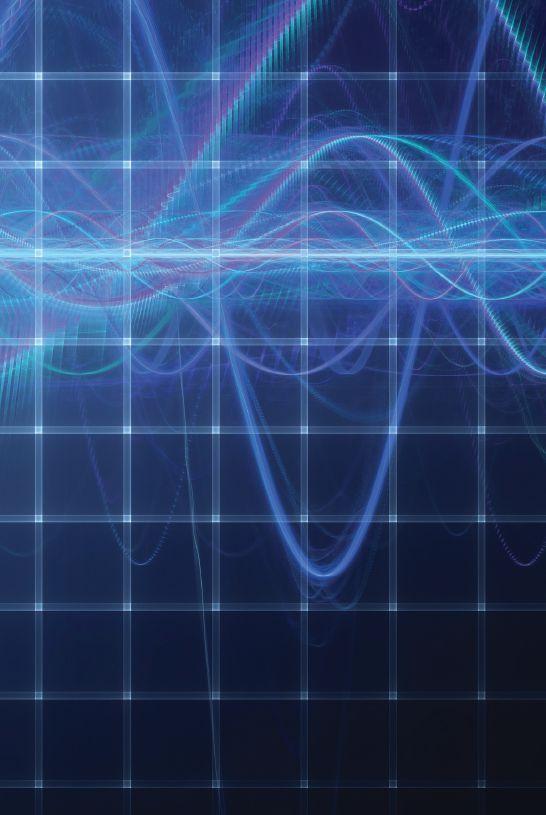
PHOTO: © ISTOCKPHOTO.COM/PORTFOLIO/POBYTOV
based on single-element settings rather than the actual applications, and failing to test the entire enabled capabilities of the protection system.
This article presents examples of common mistakes typically observed during testing and commissioning, ways to avoid them with simple-to-understand guidelines, and how testing protection systems — rather than single, protective elements — will help avoid protective relay misoperations once in service.
TESTING PROCEDURES
The process of testing multifunction digital protective relays brings new challenges for many reasons. First, we must understand the focus of testing these devices compared to testing electromechanical (EM) or singlefunction relays. The main purpose of testing EM relays was to ensure proper calibration. Calibration and testing procedures were widely available from the manufacturer and relatively easy to understand. Although modern digital
ADVANCEMENTS IN INDUSTRY
technology provides many advantages, finding appropriate guidance for proper testing can be very difficult. This article offers suggestions for simplifying the testing process without compromising proper testing procedures.
ADEQUATE TEST EQUIPMENT
To properly test multiphase IEDs, it is essential to provide a multiphase source of voltage and current. Testing a multiphase protective element with a single-phase source can lead to false assessment. Some calculations of fault values rely on measured values from a non-faulted phase. Typically, all possible faults should be simulated for each protective element, and all CT and PT inputs must be considered during the testing process. Additionally, all binary inputs and outputs utilized by the IED must be accounted for in the test equipment because it is equally important to test all logic associated with the IED’s operation.
UNDERSTANDING DIFFERENT TYPES OF TESTS
There are three types of testing procedures:
1. Evaluation testing determines whether a protective relay is suitable for use on a particular protection application(s) within a power system. This is also recognized as a process to evaluate and validate the relay manufacturer’s published specifications,
2. Commission testing ensures correct functionality of the relay when first installed and activated within the power system.
3. Periodic or maintenance testing routinely checks and validates the correct operation of an already installed and active protective relay.
For the purposes of this article, we refer mainly to the commissioning of digital protective relays, although the discussion can also be relevant to the other testing processes.
NETAWORLD • 85 TESTING AND COMMISSIONING DIGITAL PROTECTIVE RELAYS

ADVANCEMENTS IN INDUSTRY
First Process: Why Do We Test?
For EM technology, the main purpose of testing was to ensure proper calibration of the device. Over long periods of time, contacts, springs, potentiometers, and coils tend to require recalibration, cleaning, or adjustments to ensure proper operation. The term silent sentinel was often used to describe this type of technology because no self-diagnostics were present to determine whether or not the relay would function properly in the event of a fault. With no such calibration required for digital technology, as well as the ability to rely on certain self-diagnostics, why is the commission process still required?
In 2013, the North American Electric Reliability Corporation (NERC) released a report that claimed a dramatic rise in the annual number of misoperations due, in large part, to the complexity of programming and testing digital protection relays.
As shown in Figure 1, misoperations primarily occurred due to:
• Incorrect setting/logic/design errors
• Communication failures
• Relay failure or malfunctions
These events include human error during testing and maintenance activities. This human error, resulting in improper protection system activation, has contributed to large disturbance events.
Proper testing is just as important for multifunction digital IEDs as it is for older


Figure 1: 2012 NERC Misoperations Graph
EM technology, but the focus has changed significantly. It is true that IED self-diagnostics can alert operations of an internal failure and remove itself from service, but only proper testing procedures can determine whether the protection system is properly configured.
Complex logic configurations, multiple setting groups, communication-based protection schemes, and a large number of protective elements in a single IED add significant challenges to proper commissioning. Much of this complexity has led to recognized shortcuts within the testing process, which can ultimately lead to misoperation.
Second Process: What Do We Test?
At first glance, this may appear to be a simple question, but when faced with the complexity of a modern protection IED, it is anything but. The components tested are as follows:
• Protection elements. Each active protection element must be tested to ensure it has been set properly. This may seem unnecessary because there is no calibration, but relay engineers and technicians are quite capable of human error in setting each device. A misplaced decimal point, a forgotten time delay, or even forgetting to enable an element are all possible and can lead to misoperations.
• Associated logic. This important factor is often overlooked. The complexity associated with some logic equations adds to a large majority of misoperations. For example, when protective element supervision from a breaker contact is required, breaker simulation during the testing process is essential. Many protection IEDs also have programmable human–machine interface controls, some of which invoke safety-related commands such as hot line tag (Figure 2). If the controls are not programmed and tested properly, extreme hazards could be present.
86 • SUMMER 2020
TESTING AND COMMISSIONING DIGITAL PROTECTIVE RELAYS
Relay Failure/ Malfunction AC System Other/ Explainable Incorrect Setting/Logic/ Design Errors Communication Failures 2% Unknown 22% 14% 10% 38% 14%


• Communication-based protection schemes. These are most often seen in transmission line protection. In the majority of cases, they are the basis for end-to-end testing. However, these types of tests are time-consuming and often difficult to complete. Nonetheless, this critical test for a transmission line enables the protection engineer to verify the delay time of the teleprotection signals (i.e., the delay time between sending signal transmissions recorded on the first end and the received signal recorded on the other end) immediately after executing the shot, as shown in Figure 3.
ADVANCEMENTS IN INDUSTRY
Third Process: How Do We Test?
These test procedures should be avoided:
• Testing a protection IED based on factory settings
• Changing, altering, or disabling the associated logic with each protective element to validate settings
• Changing, altering, or disabling the components of a protective element to validate settings
• Testing the IED by relying only on the settings that lie within the relay
• Closing the relay trip circuit without the metering validation of a non-trip state
These procedures should be followed:
• Ensure the settings coincide with those pertaining to the application and not factory or predefined test settings.
• Test the device with associated logic enabled, considering both sides of a logic equation for proper validation.
• Test the element without changing settings such as pick up, dropout, or time delays and using proper fault values for fault simulations.
• Use relay software to validate proper secondary CT and PT wiring prior to enabling the trip circuit (Figure 4).
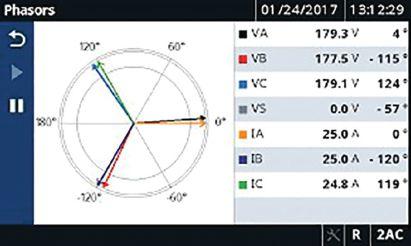
The proper test sequences that account for associated logic are:
1. Begin each test with a proper pre-fault condition: Be the relay. This should include, but not be limited to, the proper simulation of breaker contacts and the


NETAWORLD • 87
TESTING AND COMMISSIONING DIGITAL PROTECTIVE RELAYS
Figure 2: Feeder Relay with Human–Machine Interface Control
Figure 4: Relay-Metering Software
Figure 3: Delay Time of Teleprotection Signals

ADVANCEMENTS IN INDUSTRY

application of pre-fault analog values (nominal) that are maintained long enough for lockouts to reset (feeder management relays). Doing so will mitigate logic interference such as switching onto fault, cold load pickup, and so on.
6: NERC Testing Intervals
1 Testing and calibration of protective relays, per Note 7
2 Verification of instrument transformer outputs and correctness of connections to protection system

3 Verification of protection system tripping including circuit breaker tripping, auxiliary tripping relays and devices, lockout relays, telecommunications-assisted tripping schemes, and circuit breaker status indication reuired for correct operation of protection system
4 Station battery supply (Note 12)
years
years (Notes 1a, 1e, 1f)
(Notes 1a, 1f)
(Note 2a)
(Note 2a)
Five years Seven years (Notes 1a, 1b, 1d, 1e, 1f) 10 years (Note 2b)
2. Maintain a proper calculated fault value until the element picks up, allowing for the validation of trip times and thresholds.
3. Follow up with a proper post-fault state, including breaker open logic and faulted values that would be eliminated in a normal trip-state condition. Doing so removes interference from associated breaker failure conditions.
4. Ensure that calculated test values coincide with published tolerances provided by the relay manufacturer. Most modern testing software allows for automated test sequences and assessment (Figure 5).
Fourth Process: When Do We Test?
The NERC Planning Committee’s System Protection and Controls Task Force publishes maximum testing intervals by equipment category (Figure 6).
Monitoring and Verification
Monitoring and Verification
Monitoring and Verification
Test the functioning of relays with simulated inputs, including calibration per Note 7. Verify that settings are as specified. See Section 12 for a discussion of verifying settings.
Verify the current and voltage signals to the protection system and instrument transformer circuit grounding.
Perform trip tests for the whole system at once and/or component operating tests with overlapping of component verifications as explained in Section 10. Every operating circuit path must be fully verified, although one check of any path is sufficient. A breaker only needs to be tripped once per trip coil within the specified time interval Telecommunications-assisted line protection systems may be verified either by end-to-end tests or by simulating internal or external faults with forced channel signals.
One month Seven years (Notes 1b, 1d, 1f)
Continuous Verification (Notes 2b, 2d)
Continuous Monitoring and Verification
Verify voltage of the station battery once a month if not monitored.
88 • SUMMER 2020
TESTING AND COMMISSIONING DIGITAL PROTECTIVE RELAYS
Figure 5: Automated Tests from a Test Set
Category Component Maximum Verification Interval Verification Activities Reference Figure
Unmonitored Partial Monitoring Note 1 Thorough Monitoring Note 2 Full Monitoring Note 3
Figure
1
Seven
10 years
Continuous
Five
Seven
Seven
10 years
Continuous
years
years
Continuous
ADVANCEMENTS IN INDUSTRY
Figure 7: Relay Testing Intervals per NETA (Months)
7.11.1
Figure 7 illustrates published recommendations for relay testing intervals according to InterNational Electrical Testing Association (NETA) standards.
Additional considerations for testing intervals:
• Environmental conditions
• Criticality of the protected asset
• Redundancy of protection
• Historical performance.
The final considerations for when to test:
• Setting changes after commissioning
• Relaying firmware updates
• Rewiring in the trip circuit or secondary CTs or PTs.
CONCLUSION
When considering digital protection relays, it is important to understand the impact that self-diagnostics play in the testing process. Although self-diagnostics will detect the failures of certain components, such as power supplies, microprocessors, and circuit board parts, we must also understand what it will not detect, such as relay output contacts. Most important, self-diagnostics will not alarm when there is human error in setting the protective elements or logic. While digital technology adds greater reliability within the protection system, this does not eliminate the need for proper testing. Rather, this technology necessitates refocusing the testing process.
REFERENCES
D. Welton. “Avoiding Potentially Dangerous Testing Practices for Digital Relays,” Proceedings, Georgia Tech Protective Relay Conference, pp. 1-4, 2008.
D. Welton, “Testing Advanced Digital Relay Systems,” Electric Energy Magazine, May/ June 2004.
F. Steinhauser. “Network Simulation on the PC — New Options for Protection Testing,” Proceedings, IPTS, 2004.
North American Electric Reliability Corporation (NERC). Protection System Maintenance: A Technical Reference, 2007 [online]. Available at https://www.nerc.com/pa/RAPA/ PA/Performance%20Analysis%20DL/ NERC_2018_SOR_06202018_Final.pdf.

Drew Welton is Vice President of Sales for intellirent, a division of Electrorent. He provides strategic leadership to the sales team and creates new business development for the industrial testing and power producing industries. Drew was previously the North American Regional Manager for OMICRON, a Regional Sales Manager with Beckwith Electric, and National Sales Director for Substation Automation with AREVA T&D. He has written numerous articles on substation maintenance testing and has conducted training sessions for substation technicians and engineers at utilities and universities across North America. He is a 20-year Senior Member of IEEE-PES, IAS, and an active member of the Transformers Committee. He has been a contributor on a number of PSRC working groups and presented at many industry conferences specific to power-system protection and control. He holds a BS in business administration from Fort Lewis College in Durango, Colorado.


NETAWORLD • 89 TESTING AND COMMISSIONING DIGITAL PROTECTIVE RELAYS
Section Description Visual Visual and Mechanical Visual and Mechanical and Electrical 7.9 Protective Relays 7.9.1 EM and Solid State 1 12 12 7.9.2 Microprocessor Based 1 12 12 7.10 Instrument Transformers 12 12 36
Metering Devices
7.11
EM and Solid State 12 12 36 7.11.2 Microprocessor Based 12 12 36


We Buy, Sell, Trade, Calibrate, Repair
Featuring quality, reliable, on-time service and support for all brands and types of solid state power electronics.
Power electronics are our business
Let us suppoort you with our quality repair, calibration and servicing of your solid state equipment. We also buy, sell and trade:
•Communications devices for power equipment
•Protective relays
•Circuit breaker trip devices
•Motor overload relays
•Rating plugs
4701 Spartan Drive • Denton, TX 76207 (877-874-7349) • Phone: 940-243-3731 • Fax: 940-387-8277 Email: info@solidstaterepair.com • Web: www.solidstaterepair.com
“SOLID STATE” INDUSTRIAL ELECTRONICS “SOLID STATE” INDUSTRIAL ELECTRONICS Toll Free 877-TRIP-FIX NOWRENTING TESTEQUIPMENT
Relay and Protective Devices
Batteries and UPS
Low Voltage Circuit Breakers
Medium/High Voltage Circuit Breakers
SF6 Analysis
Transformer Testing
Cable Testing

Cable Fault Location

Power Monitoring
Data Acquisition and Recorders


Online and Offline Partial Discharge
Low Resistance Ohmmeters
Insulation Resistance/Megohmmeters
Ground Test Equipment


Photovoltaic Test
Infrared Cameras
Ultrasound and TEV


Online/Offline Motor Testing
AC and DC Load Banks









AC and DC Hipots
VLF and Tan Delta





888.902.6111
info@intellirentco.com intellirentco.com






We rent equipment
rental | support | logistics
INTELLIRENT: LOGISTICS, TRAINING, SUPPORT
NETA Corporate Alliance Partners (CAPs) are a group of industry-leading companies that have joined forces with NETA to work together toward a common aim: improving quality, safety, and electrical system reliability.
In our CAP Spotlight series, we look at what makes CAPs special and highlight some of their individual successes. In this issue, NETA World interviews Drew Welton, intellirent’s Vice President of Sales.
NW: What is something readers don’t know about intellirent?
Welton: When I can, I ask customers, “Why do you choose intellirent?” They always seem to give the same answer, “You’re just easy to do business with.” That is exactly what we strive for.
But to answer the question… If I were to pick one thing NETA World readers might not know about intellirent, it would be how much behind the scenes work there is to get the equipment out right and delivered on time. A much larger team supports each and every customer order. The technical salesperson is who the customer knows but many others support the order. I think the extraordinary attention on every customer is why we get the response…“You’re just easy to do business with.”
NW: What recent company achievement or milestone are you particularly proud of?
Welton: Some of your readers may not know intellirent was acquired by the ElectroRent Corporation in August of 2018. The following
year was a transition year for intellirent. We merged the electrical testing equipment fleets under intellirent, division of ElectroRent Corp. This continued the focus on the electrical testing contractor while providing the largest fleet best to serve the industry.
NW: What evolution do you see on the horizon that will have a positive impact on your work?
Welton: The rental industry is so much more than buying and renting equipment. As we continue to expand our fleet of equipment, we are keeping pace with emerging technologies within our industry such as Renewable Energy. Wind and solar power (PV) continues to grow rapidly throughout North America, and it presents a challenge to utility and testing companies in terms of maintaining acceptable levels of power quality. Since the onset of IEEE 1547, privately owned distributed energy installations are allowed to export Vars onto distribution networks. High levels of potentially harmful harmonics, extreme voltage fluctuations, and latency issues surrounding
92 • SUMMER 2020 INTELLIRENT: LOGISTICS, TRAINING, SUPPORT
INSIGHTS & OBSERVATIONS — NETA CAP SPOTLIGHT
AS WE CONTINUE TO EXPAND OUR FLEET OF EQUIPMENT, WE ARE KEEPING PACE WITH EMERGING TECHNOLOGIES WITHIN OUR INDUSTRY SUCH AS RENEWABLE ENERGY.
automated distribution systems expand opportunity for testing company solutions. PV testers, high-quality PQ analyzers, data recorders, and loggers are continuously being added to our list of rental assets and are quickly becoming commonplace in a testing company’s toolbox. While the challenges often associated with emerging technologies can seem overwhelming, the potential for growth and opportunity within our industry is significant.
NW: What challenges do you see going forward for the industry?
Welton: Manpower! How many times do we see testing companies desperately reaching out to find qualified engineers and technicians to fulfill all the work that needs to be done? Many years ago, our utility customers realized the challenges in recruiting, training, and maintaining adequate staffing levels as qualified engineers and technicians took early retirement, jumped to testing contractors, or moved on during the utility downsizing period. Most were never fully replaced, which fortunately for many of us led to a boom for the contractor testing businesses. While we all benefit from working in a strong and continually growing power industry, we must provide additional training programs, ever increasing technical support from equipment suppliers, and educational opportunities for those willing to enter our workspace.
I believe all in this industry have a responsibility do two critical things:
1. Attract new talent to the workforce.
2. Champion training and educational opportunities for technicians.

NETAWORLD • 93 INTELLIRENT: LOGISTICS, TRAINING, SUPPORT
INSIGHTS & OBSERVATIONS — NETA CAP SPOTLIGHT
Getting Ready for PowerTest 2020
ANSI/NETA STANDARDS UPDATE
ANSI/NETA ATS–2017 REVISION UNDERWAY
ANSI/NETA ATS–2017, Standard for Acceptance Testing Specifi cations for Electrical Power Equipment & Systems continues an American National Standard revision process that is scheduled to be completed in fall 2020.
A project intent noti cation published in ANSI’s Standards Action on January 3, 2020, announced the opening of a 45day public comment period. e initial ballot was issued on January 17, 2020, and closed on February 18, 2020. A second ballot is to be issued in July 2020. e revised edition of ANSI/NETA ATS is scheduled to debut at PowerTest 2021 in Orlando.
ANSI/NETA ATS covers suggested field tests and inspections for assessing the suitability for initial energization of electrical power equipment and systems. e purpose of these speci cations is to assure that tested electrical equipment and systems are operational, are within applicable standards and manufacturers’ tolerances, and are installed in accordance with design speci cations.
ANSI/NETA ECS–2020 REVISION COMPLETED
ANSI/NETA ECS, Standard for Electrical Commissioning of Electrical Power Equipment & Systems, 2020 Edition, completed the American National Standard revision process. ANSI administrative approval was received on September 9, 2019. ANSI/NETA ECS–2020 supersedes the 2015 Edition.
A project intent noti cation published in ANSI’s Standards Action on May 18, 2018, announced the intent to revise the standard. A 30-day initial ballot period and a 45-day public comment period began on April 26, 2019. A second ballot was issued July 5, 2019, and closed on August 5, 2019. e 45-day second ballot public comment period was scheduled to close on August 20, 2019. e revised edition of ANSI/NETA ECS was released in February 2020 at PowerTest in Chicago.
ANSI/NETA ECS describes the systematic process of documenting and placing into service newly installed or
















retro tted electrical power equipment and systems. is document shall be used in conjunction with the most recent edition of ANSI/NETA ATS, Standard for Acceptance Testing Specifications for Electrical Power Equipment & Systems. e individual electrical components shall be subjected to factory and eld tests, as required, to validate the individual components. It is not the intent of these speci cations to provide comprehensive details on the commissioning of mechanical equipment, mechanical instrumentation systems, and related components.
e ANSI/NETA ECS–2020 Edition includes updates to the commissioning process, as well as inspection and commissioning procedures as it relates to low- and medium-voltage systems.
94 • SUMMER 2020 SPECIFICATIONS AND STANDARDS ACTIVITY ANSI/NETA STANDARDS UPDATE
ANSI/NETA STANDARD FOR ELECTRICAL COMMISSIONING SPECIFICATIONS STANDARDS 2020 STANDARD FOR ELECTRICAL COMMISSIONING SPECIFICATIONS FOR ELECTRICAL POWER EQUIPMENT & SYSTEMS REVISION COMPLETE FOR ELECTRICAL POWER EQUIPMENT & SYSTEMS STANDARD FOR ACCEPTANCE TESTING SPECIFICATIONS ANSI/NETA ATS-2017 REVISION UNDERWAY


SPECIFICATIONS AND STANDARDS
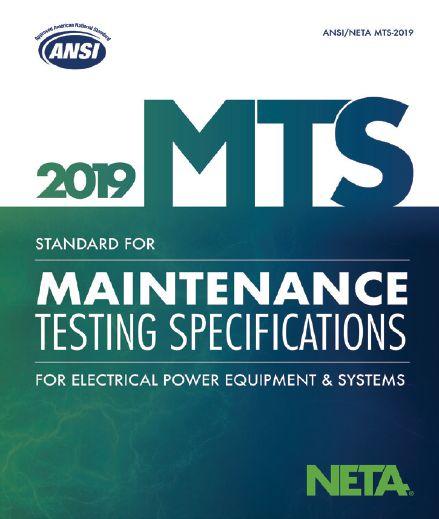

ANSI/NETA MTS–2019 LATEST EDITION
ANSI/NETA MTS, Standard for Maintenance Testing Specifications for Electrical Power Equipment & Systems, 2019 Edition, completed an American National Standard revision process and received ANSI approval on February 4, 2019. e revised edition of ANSI/NETA MTS was released in March 2019 and supersedes the 2015 Edition.




ANSI/NETA MTS contains speci cations for suggested eld tests and inspections to assess the suitability for continued service and reliability of electrical power equipment and systems. e purpose of these speci cations is to assure that tested electrical equipment and systems are operational and within applicable standards and manufacturers’ tolerances, and that the equipment and systems are suitable for continued service. ANSI/NETA MTS–2019 revisions include online partial discharge survey for switchgear, frequency of power systems studies, frequency of maintenance matrix, and more. ANSI/NETA MTS–2019 is available for purchase at the NETA Bookstore at www.netaworld.org
ANSI/NETA ETT–2018 LATEST EDITION
ANSI/NETA ETT, Standard for Certification of Electrical Testing Technicians, 2018 Edition, was approved by ANSI as an American National Standard on February 22, 2018. It is available now in the NETA Bookstore at www.netaworld.org, where a complimentary PDF copy can be downloaded or a printed copy ordered.







Voltage classes addressed include:
• Low-voltage systems (less than 1,000 volts)
• Medium-voltage systems (greater than 1,000 volts and less than 100,000 volts)
• High-voltage and extra-high-voltage systems (greater than 100 kV and less than 1,000 kV)
References:
• ASHRAE, ANSI/NETA ATS, NECA, NFPA 70E, OSHA, GSA Building Commissioning Guide
ANSI/NETA ETT establishes minimum requirements for quali cations, certi cation, training, and experience for the electrical testing technician. It provides criteria for documenting quali cations for certi cation and details the minimum quali cations for an independent and impartial certifying body to certify electrical testing technicians.
PARTICIPATION
Comments and suggestions on any of the standards are always welcome and should be directed to NETA. To learn more about the NETA standards review and revision process, to purchase these standards, or to get involved, please visit www.netaworld.org or contact the NETA o ce at 888-300-6382.
NETAWORLD • 95
ACTIVITY ANSI/NETA STANDARDS UPDATE



















ORDER NOW Visit NETAWORLD.ORG or call 888.300.6382 NEW EDITION
NFPA 70B COMMITTEE REPORT
BY DAVID HUFFMAN, Power Systems Testing Company
The NFPA 70B committee continues to update the existing guide to a standard. They meet every other Friday for a two-hour conference call to make progress on various chapters. The chapter numbers have changed to improve the flow of the document and make it easier to follow.
The progress has been a bit slow, and now that issue has been worsened by COVID-19. The meeting originally scheduled for late March has been rescheduled for mid-August. The conference calls every other Friday resume on
April 17. At this time, a definitive publication date has not been set.
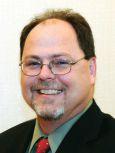
David Huffman has been with Power Systems Testing, a NETA Accredited Company, since January 1988 and is currently CEO. He graduated from California State University, Fresno, and is a licensed Professional Electrical Engineer in the state of California as well as a NETA Level IV Certified Technician. David is a NETA board member, NETA’s Principal Representative to the NFPA 70B Committee, and serves as a member of various NETA committees.

SPECIFICATIONS AND STANDARDS ACTIVITY


ANSWERS



ANSWERS

Why did I choose these questions? Because safety is much more than wearing PPE or knowing approach distances. The risk assessments required by NFPA 70E, the hierarchy of risk control methods, and the rest of Article 110 all have a great impact on safety. It is not just your company that needs to understand and implement these things; it is each employee, as well.




3. c. Elimination. This question should have been a gimme. Eliminating the hazard is always the first priority. The others are important, and to learn more about them, refer to Informative Annex F, Risk Assessment and Risk Control.
4. a. Be completed by a qualified person, be documented, and contain the items listed in 110.1(I), which are:
NFPA Disclaimer:
Although Jim White is a member of the NFPA Technical Committee for both NFPA 70E, Standard for Electrical Safety in the Workplace, and NFPA 70B, Recommended Practice for Electrical Equipment
Maintenance, the views and opinions expressed in this column are purely the author’s and shall not be considered an official position of the NFPA or any of its technical committees and shall not be considered, nor be relied upon, as a formal interpretation or promotion of the NFPA. Readers are encouraged to refer to the entire text of all referenced documents.
1. d. Awareness of the hazards and the selfdiscipline required for the work containing electrical hazards. These two are very important for individual safety and for the safety of those around them. Being aware of the hazards is more than knowing electricity will shock you or that an arc may occur. It also includes recognizing hazards in partiallyenergized equipment, checking for the absence of voltages, and understanding that arc flash and blast are not the only hazards that can cause death or serious injury. We talk about arc flash all the time, but shock is still a killer.
2. I’ll list these in the same order given in 70E:
a. Identify hazards
b. Assess risks
c. Implement risk control according to the hierarchy of risk control methods
a. A description of the job and the individual tasks
b. Identification of the electrical hazards associated with each task
c. A shock risk assessment in accordance with 130.4 for tasks involving a shock hazard
d. An arc flash risk assessment in accordance with 130.5 for tasks involving an arc flash hazard
e. Work procedures involved, special precautions, and energy source controls
The first requirement means that the person completing the risk assessment must not only be a qualified person, but must be qualified in the specific task about to be performed. The old saying “the blind leading the blind” could certainly apply here. If you have questions on how to perform the task, what is required to perform it safely, or are just not certain of anything involved, hit the STOP button and rethink things. It’s not demeaning to not know everything; no one does.
TECH QUIZ
No. 130
TECH QUIZ ANSWERS
98 • SUMMER 2020

Capitol Area Testing, Inc.
CAPITOL AREA TESTING RECOGNIZED AS NEW NETA ACCREDITED COMPANY
Capitol Area Testing, Inc. was born in 2006 from the perception that the data center Industry in Northern Virginia needed a more dedicated, service-oriented testing organization than what was being provided at the time. Since that time, Capitol Area Testing Inc. has been 70% dedicated to new data center acceptance testing, including medium-voltage distribution equipment, medium-voltage redundant power systems, low-voltage redundant power systems, critical power distribution, and mechanical support systems.
The company provides maintenance testing of existing data centers and has completed the Acceptance Testing on most of them, thereby providing the owners with a complete
knowledge of their system upfront and creating long-term relationships with customers. Additional services include maintenance and acceptance testing for the major utility companies in the area. Future expansion plans include services for the government sector.
While the vast majority of Capitol Area Testing’s work is in the Northern Virginia Internet Corridor, they service customers throughout the Mid-Atlantic region and are currently seeking highly qualifi ed test technicians to join their IBEW Signatory Company.
“Capitol Area Testing Inc. is excited to achieve NETA accreditation because our existing
NETAWORLD • 99 CAPITOL AREA TESTING RECOGNIZED AS NEW NETA ACCREDITED COMPANY
and future customers require the structure, expertise, training, and documentation that NETA provides,” says Vice President of Operations Carl VanHooijdonk. “While we believe we have these qualities as a company and as highly experienced eld technicians, it is time to show that more concisely through NETA accreditation.”
“NETA recognizes the hard work that NETA Accredited Companies like Capitol Area Testing have to put in to achieve this important milestone,” says Scott Blizard, Vice President and Chief Operating O cer of American Electrical Testing Co., Inc. and current NETA President. “NETA Accredited Companies
play a critical role in securing electrical power system safety and reliability for all, and NETA is a stronger organization due to these companies’ dedication to our industry.”
703 E. Ordnance Rd. Suite 614 Baltimore, MD 21226 443-370-8583
www.capitolareatesting.com



Hood Patterson & Dewar, Inc.
NETA WELCOMES HOOD PATTERSON & DEWAR AS NETA ACCREDITED COMPANY
Established in 1982, Hood Patterson & Dewar (HP&D) provides testing services in missioncritical facilities across the country and around the world. A full-service testing fi rm with offices in Georgia, Tennessee, Texas, and Virginia, HP&D offers engineering expertise and industry experience in complex mechanical and electrical power systems analysis, testing, and commissioning.
A 100% employee-owned company, HP&D’s staff includes professional and graduate engineers and career test technicians with diverse backgrounds. Thorough, yet able to adapt to the needs of each project, HP&D’s experienced personnel provide independent oversight of all aspects from conception through construction and beyond.
HP&D offers electrical testing, electrical and mechanical commissioning, grounding system design, engineering consulting, facility management support services, safety assessments, and training, as well as comprehensive power system analysis and reporting. The company’s projects range from small commercial buildings to large state-of-the-art data centers, power plants, and other mission-critical facilities. HP&D is the exclusive worldwide distributor of the Smart Ground® Multimeter (SGM), a multifunction instrument that measures the critical characteristics of any ground system.
Hood Patterson & Dewar was named to the Consulting-Specifying Engineer magazine’s 2019 list of Commissioning Giants. During
NETAWORLD • 101 NETA WELCOMES HOOD PATTERSON & DEWAR AS PRESTIGIOUS NETA ACCREDITED COMPANY
its fi rst year on the list, HP&D reported commissioning revenue of $12.5 million. The report is based on annual commissioning revenue and reflects commissioning firms of all levels.
President Brandon Sedgwick, PE, says, “I am proud of the hard work put forth by our employees during the process of becoming fully accredited by NETA. NETA is a worldclass organization, and we anticipate our accreditation will provide us with many new opportunities to expand our client base and service offerings. Successfully achieving this demanding certification provides our employees with a strong, industry-relevant training curriculum to augment our existing employee development program. We could not be more pleased.”
“NETA extends a warm welcome to Hood Patterson & Dewar, Inc.,” says Scott Blizard,



Vice President and Chief Operating Officer of American Electrical Testing Co., Inc. and current NETA President. “We applaud the important role all our NETA Accredited Companies have in advancing the electrical power systems industry and its safety. Achieving NETA accreditation is something HP&D can be proud of, and this recognition is indicative of their accomplishments as an organization.”
(770) 453-1415
Superior Service for Optimal Performance

Corporate Office 850 Center Way Norcross, Georgia 30071 www.hoodpd.com
To learn more, visit HVMCorp.com or call 1-866-HVM-TEAM Experts Available Across Six Centers of Excellence: Commissioning | Electrical Engineering | DC Power Testing and Maintenance | Protection and Controls | Compliance © 2019 HVM CORP. All rights reserved. HVM and the HVM logo are trademarks or registered trademarks of HVM Corp. All other names and logos referred to are trade names, trademarks or registered trademarks of their respective owners. While every precaution has been taken to ensure accuracy and completeness herein, HVM Corp. assumes no responsibility, and disclaims all liability, for damages resulting from use of this information or for any errors or omissions. Specifications are subject to change without notice. Whether you need startup services, ongoing maintenance, or emergency response you need a partner you can trust. Rely on your High Voltage Maintenance team for expertise, responsiveness, and safety. • Consistent quality, service-delivery process • Proactive customer communication and project management • National, regional, and local service center availability
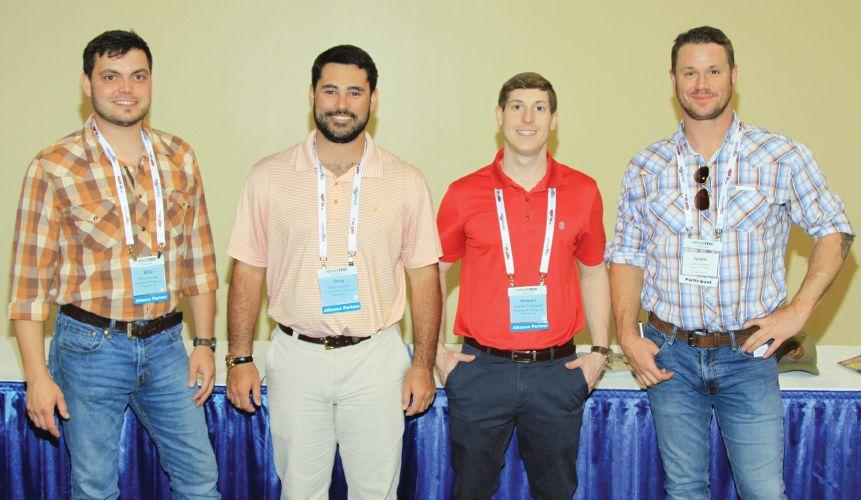
(Left to right), Billie Patnode holds a Georgia non-restricted electrical contractor’s license and NETA Level III certification. Lee Couch earned a BSCE from the University of Alabama and has years of experience in project management. Samuel Townsend holds a BSEE from the Georgia Institute of Technology and NETA Level III certification. Colby Lackey maintains NETA Level III certification and has many years of experience in the electrical industry as a journeyman electrician.
POWERSOUTH TESTING ACHIEVES NETA ACCREDITED COMPANY STATUS
NETA has announced that PowerSouth Testing is the latest to achieve the respected NETA Accredited Company (NAC) status. Located in Cedartown, Georgia, PowerSouth’s workload is currently concentrated in the southeastern United States. The company’s story began when three previously accredited technicians decided to come together and open PowerSouth’s doors to provide electrical testing services to the public.
The PowerSouth team includes individuals with diverse engineering or electrical experience.
PowerSouth offers a wide range of electrical testing services including low- and mediumvoltage installation and testing services,
breakers, switchgear, transformers, infrared inspection, protective relays, commissioning, and emergency services. PowerSouth also has extensive experience with medium-voltage cable splicing and terminating. PowerSouth performs work for customers in various industries, with a majority of the work in industrial, construction, commercial, data center, and hospital facilities. The company tests in accordance with the ANSI/NETA ATS and ANSI/NETA MTS standards.
“PowerSouth looks forward to participating in NETA as a NAC as we continue to grow within the electrical testing industry,” says President Samuel Townsend. “We are excited to help grow the industry by working with
NETAWORLD • 103 POWERSOUTH TESTING ACHIEVES NETA ACCREDITED COMPANY STATUS
our customers who already understand NETA and demonstrating NETA’s value to those who are not familiar with our industry or the positive impact NETA testing can have on their electrical assets. Achieving NAC accreditation provides extra value to our company and assures our customers of quality, experience, and training.”
“NETA welcomes PowerSouth Testing as its newest NETA Accredited Company,” says Scott Blizard, Vice President and Chief Operating O cer of American Electrical Testing Co., Inc. and current NETA President. “NETA’s Accredited Companies are the backbone of the organization because they work to assure electrical power systems are as safe as

possible. It is a respected achievement because our industry understands what’s involved in reaching this level of performance.”
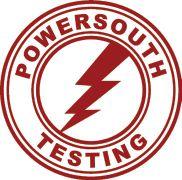
PowerSouth Testing 240 Pine Pitch Rd. Cedartown, GA 30125 (678) 901-0205 www.powersouthtesting.com





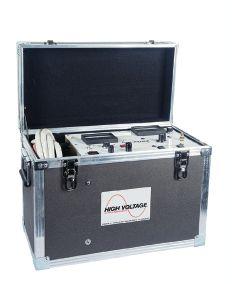




HIGH VOLTAGE, INC. sales@hvinc.com www.hvinc.com HIGH VOLTAGE, INC. HVI - The World’s Source for High Voltage Test Equipment HVI Makes it Easy and Efficient VLF hipot: 0 - 33 kVac @ 1 μF @ 0.1 Hz Fault locate: 0 - 13 kV @ 760 J VLF Fault Burner Radar/TDR ready Other Thumper models: 5/10/20 kV @ 1000 J 9/18/36 kV @ 3200 J • Very Low Frequency AC Technology • Cable Diagnostic TD & PD Testing • Cable Fault Locating with Controlled Energy • AC & DC Hipots, Aerial Lift Testers, Oil Testers • Ω-CHECK® Concentric Neutral Testing • Custom Engineered & Fabricated Van Pkgs. VLF/Thumper Combination All That You Need 50 kVac @ 3 kVA Hipot 1 piece & w/cable output VLF 0.1 Hz @ 34 kVac Comp. control - wireless 80 kVdc Hipot/Megohmmeter 1 instrument - 2 tests All HVI Products are Made in the USA Cable Fault Locating & VLF Testing – AC & DC Hipots You Can Rely on HVI!
Keynote Speaker
Sparks Innovation and Achievement NETA’s
The best and brightest in electrical testing and maintenance lit up PowerTest 2020, the premier electrical power systems event. The annual five-day conference hosted over 500 attendees from February 24–28, 2020, at the Hyatt Regency Chicago.
PowerTest is the largest gathering of NETA Accredited Company representatives and industry professionals each year and is supported by companies committed to safety, reliability, and quality across the electrical power systems industry.
“Even in these uncertain times, the NETA community showed strong participation at PowerTest, proving the continued importance of sharing ideas, collaborating, and networking with other leaders and experts in the field,” says NETA Executive Director Missy Richard. “Our
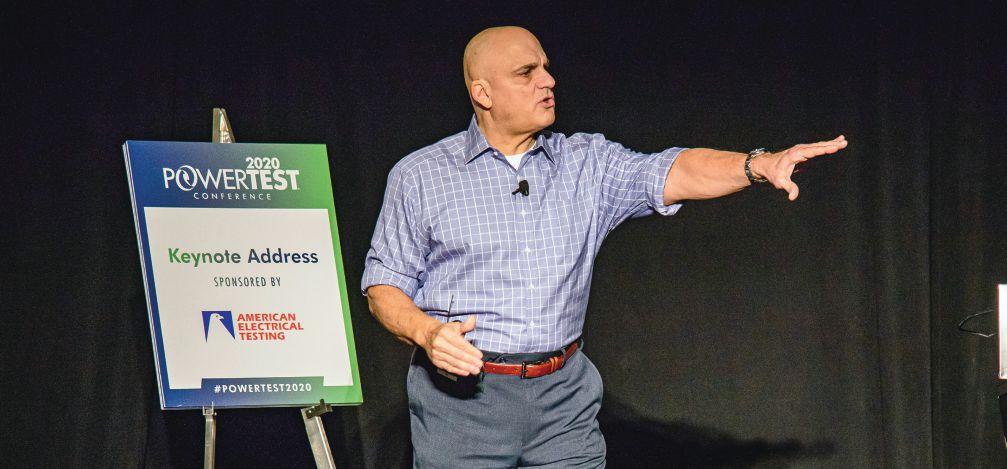
106 • SUMMER 2020 NETA’S POWERTEST 2020 SPARKS INNOVATION AND ACHIEVEMENT
David Sarkus

industry’s support at this year’s PowerTest helps us expand technical excellence, world-class programs, and consensus standards.”
The PowerTest agenda featured five days of educational and interactive sessions with an emphasis on idea-sharing and shaping the future of the electrical power systems industry. Electrical testing technicians, engineers, and managers from a cross-section of industries were represented and actively engaged in making PowerTest 2020 a success.
Highlights of the 2020 conference included:
• 298 unique companies represented over 5 days
• 27 detailed, 45-minute technical presentations by industry leaders
• 16 in-depth 4-hour seminars covering current topics and industry issues
• 30 presentations on the latest products and services from power systems leaders at the New Product Forum
• Keynote speaker David Sarkus shared seven principles to empower organizations to attain their vision for world-class safety and performance and revealed a
set of global standards anyone can use to help improve ongoing safety-related attitudes, actions, and awareness. Sarkus is a Certified Safety Professional (CSP) with advanced degrees in safety management and organizational psychology and is the author of five books, including best-seller “The Safety Coach®: Unleash the 7 C’s for World Class Safety Performance!”
• Opportunities to earn CEUs and CTDs
Tuesday afternoon’s PowerTest Trade Show is an industry favorite, featuring over 60 toptier vendors dedicated to providing PowerTest attendees with actionable, real-world solutions to everyday challenges.
KICK-OFF MEETINGS
FEATURE PEER DISCUSSION AND LATEST NETA UPDATES
More than 120 NETA Accredited Company representatives, Alliance Partners, and Corporate Alliance participants gathered on Sunday, February 23, 2020, at the Hyatt Regency Chicago for NETA’s 2020 Annual Member and Alliance Meetings. The annual meetings are held on the Sunday before PowerTest and are the traditional kickoff to the conference each year.
NETAWORLD • 107 NETA’S POWERTEST 2020 SPARKS INNOVATION AND ACHIEVEMENT
Panel Discussion at Member/Alliance Meeting
NETA MEMBER MEETING
A gathering especially for representatives and technicians from NETA Accredited Companies, the NETA Member Meeting brought reports from all sides of the association. From updates on membership and strategic initiatives to a review of program plans for the coming year, and recognition of volunteers and committee chairs, the meeting also included the nomination and election of officers.

NETA MEMBER AND ALLIANCE MEETING
NETA Corporate Alliance and Alliance Partners were invited to join NETA Accredited Companies for the second half of the Member Meeting. Among other updates, participants also heard reports on industry activity from NETA technical representatives.
Throughout PowerTest week, a series of special events delivers opportunities for attendees to network and lay the groundwork for future collaborations. For upcoming Alliance Partner events, watch your inbox for emails from NETA and look for notices in NETA World. For additional information about the NETA Alliance Program or to enroll, visit www.netaworld.org/allianceprogram Join NETA and leading electrical power systems professionals at the next premier industry conference March 8–12, 2021, at Rosen Shingle Creek in Orlando, Florida. Sponsorship and exhibitor opportunities are available for companies seeking leadership visibility at the event. NETA’s industry partners are encouraged to reserve exhibit space and confirm sponsorships as soon as possible. Inquiries should be directed to Laura McDonald at 269-488-6382 or lmcdonald@netaworld.org.
108 • SUMMER 2020 NETA’S POWERTEST 2020 SPARKS INNOVATION AND ACHIEVEMENT
PHOTO:
ISTOCKPHOTO.COM/PORTFOLIO/RABBIT75_IST in
THE DATE
©
Orlando SAVE



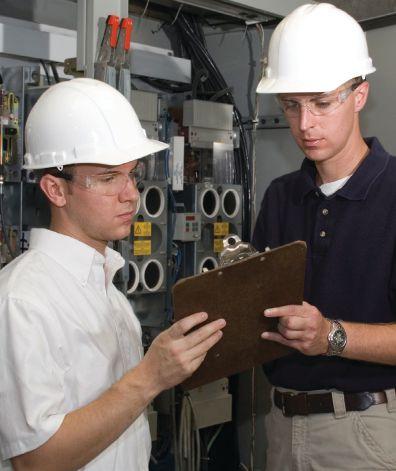





6605 W. WT Harris Blvd. Suite F • Charlotte NC 28269 | 13 Jenkins Court • Mauldin, SC 29662 | 9481 Industrial Center Drive, Suite 5 • Ladson, SC 29456 704.573.0420 • 844-383-8617 • 704.573.3693 (fax) • www.powerproducts.biz Acceptance and Maintenance Testing Commissioning Circuit Breaker Repair and Retrofit Infrared Scanning MV Cable Terminations and Testing Commissioning and Load Bank Testing of UPS, Generators, and ATS RETROFITTED BREAKER

OUTSTANDING ACHIEVEMENT AWARD
RECIPIENT DEFINED BY SECURING SAFETY FOR ALL
If it’s possible to sum up Ron Widup with a single word, it might be: Driven.
Widup, who is Senior Advisor, Technical Services, and Vice Chairman of the Board of Directors at Shermco Industries, is the 2020 recipient of NETA’s Outstanding Achievement Award.
The 2020 NETA Outstanding Achievement Award recipient holds a passion for the industry, and his participation in standards development
for NFPA, and the IEEE makes him one of its most dedicated contributors. At the same time, Widup’s contributions to NETA are far-reaching, including the Standards Review Council, NAMO Committee, Conference Committee, Technical Representation Steering Committee, Association Development Committee, Technical Exam Committee, and Member Review Committee.
“Ron is very focused on any project he takes on. He has a vast knowledge that he draws on and a settled personality that allows him to perform many tasks that would not normally
110 • SUMMER 2020 OUTSTANDING ACHIEVEMENT AWARD RECIPIENT DEFINED BY SECURING SAFETY FOR ALL
Ron Widup (right) Accepts NETA’s Outstanding Achievement Award from President Scott Blizard
be possible,” says Jim White, Vice President of Training Services at Shermco Industries. “No doubt, working long hours helps, too. I often receive emails from him at 2:00 AM, so I don’t know when he sleeps. He has always been very committed to the Shermco way.”
It will come as no surprise to those who know him that Widup sees the award as a testament to the electrical testing community. “If we can all focus on making things better for others, it leads to betterment for everyone — and everyone includes you,” he says.
His dedication to safety comes from personal experience. In 1984, Widup was severely injured while working on an automatic transfer switch — it exploded in an arc flash in front of him. He spent over a week in the hospital and then another month recovering at home. After that, safety became the focus of his career.
Widup’s eye for the greater good and drive to improve the industry at large have long been defining features. Calvin Earp, Shermco’s Senior Director of Operations MSD, has worked with Widup in some capacity since 1990. Earp says Widup has always been intense but calm, intuitive, generous, and capable of recognizing fine distinctions.
“When I started at Shermco in 1990, we had approximately 45 employees; today we have more than 1,200, and I attribute most of that success and growth to Ron’s keen vision and generosity,” Earp says. “Simon Sinek said, ‘Great leaders must have two things: a vision of the world that does not yet exist and the ability to communicate that vision clearly.’ Ron possesses both of those qualities.”
Widup’s vision includes a world safe from electrical failures, but more important, safe for the people working on those frontlines.
“He has a real concern for safety and the workers and has always been up front about it,” White says. “He has been a mentor and a
MEET RON WIDUP
Widup is Senior Advisor, Technical Services, Vice Chairman of the Board of Directors for Shermco Industries. He has been with Shermco for a remarkable 37 years serving in positions from field service technician all the way to CEO.

He is a member of Technical Committee for NFPA 70E, Electrical Safety in the Workplace; a principal member of National Electrical Code (NFPA 70) Code Panel 11; a principal member of Technical Committee NFPA 790, Standard for Competency of Third-Party Evaluation Bodies and Technical Committee NFPA 791, Recommended Practice and Procedures for Unlabeled Electrical Equipment Evaluation; a member of Technical Committee NFPA 70B, Recommended Practice for Electrical Equipment Maintenance; and Vice Chair for IEEE Std. 3007.3, Recommended Practice for Electrical Safety in Industrial and Commercial Power Systems
Ron also serves on NETA’s Board of Directors and Standards Review Council. He is a member of the Texas State Technical College System (TSTC) Board of Regents, a NETA Certified Level 4 Senior Test Technician, a State of Texas Journeyman Electrician, an IEEE Standards Association member, an inspector member of the International Association of Electrical Inspectors, and an NFPA Certified Electrical Safety Compliance Professional (CESCP).
friend, first getting me on the 70E Committee to represent NETA, then as co-author of the NETA and the 70E column in NETA World. He always has good input and has involved me in numerous projects involving electrical safety programs or investigating incidents.”
Widup acknowledges the successes he’s enjoyed and the advancements he’s championed are in no small part a result of the people who inspired and mentored him during his career.
“You should always surround yourself with people who are smarter than you. But when I look back and think about it, the people who really made a difference for me all fit the same
NETAWORLD • 111 OUTSTANDING ACHIEVEMENT AWARD RECIPIENT DEFINED BY SECURING SAFETY FOR ALL
criteria — they took a chance on me,” Widup says. “So, whether it was Bill Coleman, the plant engineer at Chaparral Steel who trusted me with his million-dollar transformer testing, or Pete Sherman, Shermco’s founder who let me try new things with the company, or the many others throughout my career — they all had trust in me. Trust is important, and you should covet it and work hard to keep it, regardless of the curve balls life throws you.”
Currently serving as a member of NETA’s Board of Directors, Widup has held various Association leadership positions since 1998, including the role of President more than once. In addition to essentially using the Association as his posttech-school learning institution, Widup credits NETA with many of his own successes.
“The rewards of being involved with NETA include networking, industry involvement,

and enhanced knowledge of our industry,” Widup says. “When our members, industry partners, and end users fully participate, they will find NETA has a positive role in their career, both professionally and personally.” Widup encourages people to take stock of their situations and themselves to create a better community and industry.
“Always step back and think about tomorrow. We often live in the moment, dealing with the day-to-day issues — but that’s only today,” Widup says. “Ask yourself what it is about today that will shape what we do tomorrow. It’s not always intuitive, and you have to consciously think about it, but if you take the time to do that, take reasonable risks, and think about what you don’t exactly know, you generally come out OK. And if it doesn’t work out, blame it on a dead guy. Works every time.”
















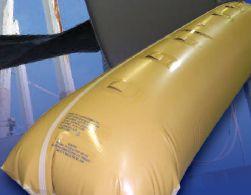



























THE DIFFERENCE... ® ...LImIT DowNTImE; CHoosE CoNsERVAToRBLADDERs TRANsFoRmER AIR-CELL 800-526-5330 +1-201-825-1400 www.atlinc.com ABB Inc. - G.E. / Alstom Grid - Atlantic Transformer CG Power USA - Calpine - Duke Energy - First Energy Gexpro - Jacksonville Electric Authority - NASS - PSE&G Siemens - SPX Transformer Solutions &ManyMore! BLADDER DEsIGN GUIDE AVAILABLE oN oUR wEBsITE ULTRA-sTRoNG “oVER-LAP” sTYLE sEAms MADE IN THE U.S.A. FOR OVER 45 YEARS! sTANDARD TEmPLATEs DIGITAL LIBRARY oF PoPULAR sIzEs/sTYLEs! REVERsE ENGINEERING ATL CAN PRECIsELY DUPLICATE ANY BLADDER sTANDARD & CUsTom HARDw mETALLIC FLANGEs,HANGERLooPs & moRE! ExPEDITED DELIVERY ULTRA-FAsT TURNARoUND - 2 To 3 DAY AVERAGE! CUsTomERs INCLUDE: ® s!
ALLIANCE RECOGNITION AWARD HONORS A CONSUMMATE EDUCATOR
When the presentation for this year’s Alliance Recognition Award began, Dr. Nick Perjanik thought the award was going to anyone but him.
“At rst, I thought it was someone else since there were many people in the room with similar backgrounds and contributions to NETA. Once the reference was made to my dissertation, I was surprised I was the one being recognized,” Perjanik says. “It was an unexpected but appreciated honor.”
His doctoral dissertation focused on how to capture the experience-based knowledge of retiring electrical engineers at electrical utilities. As Director of Operations for WEIDMANN Electrical Technology Inc. and through his contributions to NETA, Perjanik has proven time and time again his dedication to education and training.
“Nick is rst and foremost an educator,” says Tom Prevost, Vice President Innovation and R&D Americas Region for WEIDMANN “Even though he never was a teacher or professor in the traditional sense, he strives to leave those around him more informed whenever the opportunity arrives.”
Prevost says he was immediately impressed and surprised when he met Perjanik.
“My rst thought was ‘Who is this guy and where did he come from?’” Prevost says. “I
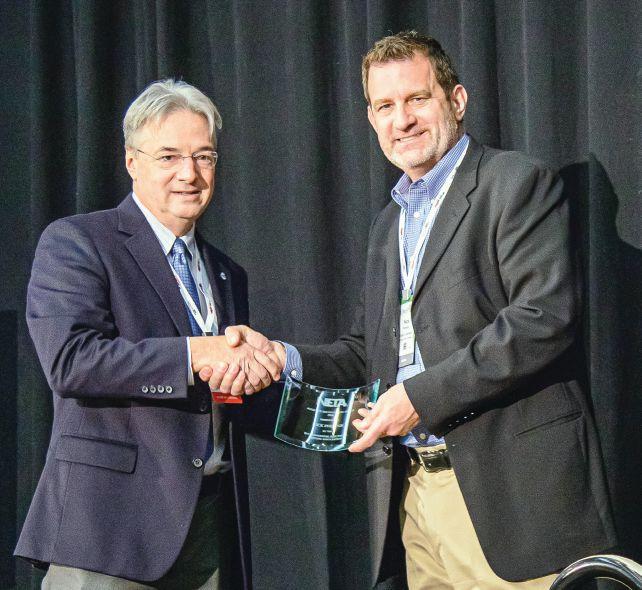
left WEIDMANN for a few years, and when I returned, he was leading the company’s education e orts. I met him at a conference where he spoke, and I was surprised he was so knowledgeable, yet I did not know him earlier.”
Some of the surprise Prevost felt had to do with Perjanik’s demeanor. Prevost describes his colleague as someone who is clearly incredibly knowledgeable but still humble and eager to nd the best way to share his knowledge with his peers. “He cares about people,” Prevost says. “He respects his peers deeply, and it shows.”
NETAWORLD • 113 ALLIANCE RECOGNITION AWARD HONORS A CONSUMMATE EDUCATOR
Nick Perjanik (right) Receives Alliance Recognition Award from Jim Cialdea
Perjanik credits his passion for learning and helping others learn in no small part to an important educator in his life.
“Dr. Fredi Jakob was a California State University–Sacramento professor and the faculty advisor to the Snow Ski Club. We connected as chemists and avid skiers, and I began my career testing transformer oils for his local lab in the 1980s,” Perjanik says. “Years later after working alongside him, I was honored when he introduced me at a training conference as his colleague. He continued to infl uence my career and demonstrate how knowledge and expertise could lead to a long career.”
So far, it’s been a career defined by that thirst for knowledge.
MEET NICK PERJANIK
Dr. Nick Perjanik, NETA’s 2020 Alliance Recognition Award recipient, is Director of Operations for WEIDMANN Electrical Technology, Inc. There he oversees nine North American testing facilities, including new method and diagnostics development, data management services, and environmental accreditation.
As a speaker at PowerTest, Perjanik’s technical sessions are among the most well-regarded and well-attended.

You may have also seen his work in one of his many co-authored technical papers, which have appeared in various technical journals, including NETA World. He’s a member of the IEEE Transformer Committee and ASTM Committee D27.
Perjanik holds a PhD in management from Walden University, and an MBA and BA in chemistry from California State University–Sacramento.
“In college, I took a required chemistry course and ended up just staying in that building for four years. I continued to take chemistry classes I found challenging, and a week before graduation, a professor told me I needed to offi cially change my major to chemistry,” Perjanik says. “I was caught up in the analytical nature and logic of the sciences and that has continued to this day.”
“When you find a career in an industry that allows you to be both professionally and personally challenged and rewarded, you do not take it for granted,” Perjanik says. “I enjoy learning, contributing, and working in this industry.”
Of course, with his drive for education, Perjanik notes the importance of partnering with organizations such as NETA that are dedicated to learning.
“I’ve been involved with NETA since the early 1990s, so I have seen the association grow and become a recognized and leading force in the industry. I have been honored to support NETA companies and members for many decades at training sessions and conferences, with NETA World articles, and with ongoing technical support,” Perjanik says. “The association is a valuable partner to my organization. Having properly trained and knowledgeable clients makes what we do that much more valuable.”
“As a manufacturer of electrical insulation and testing systems and a supplier of laboratory services to NETA members, we see NETA’s ongoing value in developing, standardizing, training, and advancing the safe and efficient testing of power systems to ensure operational continuity — an especially important trait in these times,” Perjanik says. “NETA offers companies like WEIDMANN Electrical Technology opportunities to educate, train, and leverage the collective knowledge of the industry — something we intend to continue to support.”
114 • SUMMER 2020 ALLIANCE RECOGNITION AWARD HONORS A CONSUMMATE EDUCATOR




















on the ELECTRICAL TESTING LEADING EDGE on the offers a comprehensive array of state-of-the-art electrical testing services and expertise. Switchgear / Circuit Breakers / Transformers / ATS Switches / Cables Acceptance Testing and Commissioning / Infrared Surveys Motor and Cable Testing Load and Power Quality Recording and Analysis Nu Heat Certified Repair Specialists CONTACT US TODAY • 24 HOUR SERVICE 228 Merrick Road, Lynbrook, NY 11563 (631) 589-6343 601 Union Street, Brooklyn, NY 11215 (718) 786-4900 WWW.ELEMCO.COM Licenced in New York and New Jersey 1315 Columbine, Gainesville, Texas 76241 | 800-232-5809 INFO @ CBSALES.COM | CircuitBreaker.com CBS Florida | Lakeland, Florida | 863-646-5099 | CBS-Florida.com CBS Midwest | Crown Point, Indiana | 219-575-5420 | CBSMidwest.com new service locations CBS stocks every low- and mediumvoltage circuit breaker made in America since 1945. With more than 5 million breakers and parts in our 200,000-square-foot warehouse — including switchgear, transformers, substations, protective relays, loadbreak switches, electrical contacts, motor controls and centers, vacuum interrupters, and more — Circuit Breaker Sales has you covered. √ Replacement parts and equipment √ Remanufacturing, retrofits, and upgrades √ Reverse engineering, 3-D printing of obsolete parts For more information about Group CBS and its affiliate companies, visit GroupCBS.com. CircuitBreaker.com (800) 232-5809 TOLLFREE Your TRUSTED online resource for authentic circuit breaker and electrical distribution equipment C B Store.com
NETA ACCREDITED COMPANIES Setting the Standard
A&F Electrical Testing, Inc.
80 Lake Ave S Ste 10 Nesconset, NY 11767-1017 (631) 584-5625
www.afelectricaltesting.com
A&F Electrical Testing, Inc.
80 Broad St Fl 5 New York, NY 10004-2257 (631) 584-5625
www.afelectricaltesting.com
ABM Electrical Power Services, LLC
720 S Rochester Ste A Ontario, CA 91761-8177 (301) 397-3500
www.abm.com/Electrical
ABM Electrical Power Services, LLC
4221 Freidrich Lane Suite 170 Austin, TX 78744 (210) 347-9481
ABM Electrical Power Services, LLC
2631 S. Roosevelt St Tempe, AZ 85282 (602) 722-2423
ABM Electrical Power Services, LLC
1005 Windward Ridge Pkwy Alpharetta, GA 30005 (770) 521-7550
www.abm.com/Electrical
ABM Electrical Power Services, LLC
9800 E Geddes Ave Unit A-150 Englewood, CO 80112-9306 (303) 524-6560
ABM Electrical Power Services, LLC 11719 NE 95th St. Ste H Vancouver, WA 98682 (360) 713-9513
www.ABM.com/Electrical
ABM Electrical Power Services, LLC 6940 Koll Center Pkwy Suite# 100 Pleasanton, CA 94566 (408) 466-6920
ABM Electrical Power Services, LLC
3600 Woodpark Blvd Ste G Charlotte, NC 28206-4210 (704) 273-6257
ABM Electrical Power Services, LLC
3585 Corporate Court San Diego, CA 92123-1844 (858) 754-7963
ABM Electrical Power Services, LLC 6541 Meridien Dr Suite 113 Raleigh, NC 27616 (919) 877-1008
www.abm.com/Electrical
ABM Electrical Power Solutions 4390 Parliament Place Suite S Lanham, MD 20706 (301) 967-3500
ABM Electrical Power Solutions 1817 O’Brien Road Columbus, OH 43228 (724) 772-4638 www.abm.com
ABM Electrical Power Solutions 3700 Commerce Dr # 901-903 Baltimore, MD 21227-1642 (410) 247-3300 www.abm.com
ABM Electrical Power Solutions 814 Greenbrier Cir Ste E Chesapeake, VA 23320-2643 (757) 364-6145 www.abm.com
ABM Electrical Power Solutions
317 Commerce Park Drive Cranberry Township, PA 16066-6407 (724) 772-4638
AMP Quality Energy Services, LLC
352 Turney Ridge Rd Somerville, AL 35670 (256) 513-8255
Absolute Testing Services, Inc.
8100 West Little York Houston, TX 77040 (832) 467-4446
www.absolutetesting.com
Accessible Consulting Engineers, Inc. 1269 Pomona Rd Ste 111 Corona, CA 92882-7158 (951) 808-1040 www.acetesting.com
Advanced Electrical Services 4999 - 43rd St. NE Unit 143 Calgary, AB T2B 3N4 (403) 697-3747
Advanced Testing Systems 15 Trowbridge Dr Bethel, CT 06801-2858 (203) 743-2001 www.advtest.com
American Electrical Testing Co., LLC 25 Forbes Boulevard Suite 1 Foxboro, MA 2035 (781) 821-0121
www.aetco.us
American Electrical Testing Co., LLC
34 Clover Dr South Windsor, CT 06074-2931 (860) 648-1013
www.aetco.us
American Electrical Testing Co., LLC 91 Fulton St., Unit 4 Boonton, NJ 07005-1060 (973) 316-1180
www.aetco.us
American Electrical Testing Co., LLC
76 Cain Dr Brentwood, NY 11717-1265 (631) 617-5330
www.aetco.us
American Electrical Testing Co., LLC
Green Hills Commerce Center 5925 Tilghman St Ste 200 Allentown, PA 18104-9158 (484) 538-2272
www.aetco.us
Apparatus Testing and Engineering 11300 Sanders Dr Ste 29 Rancho Cordova, CA 95742-6822 (916) 853-6280 www.apparatustesting.com
Apparatus Testing and Engineering
7083 Commerce Cir Ste H Pleasanton, CA 94588-8017 (916) 853-6280 www.apparatustesting.com
Applied Engineering Concepts 894 N Fair Oaks Ave. Pasadena, CA 91103 (626) 389-2108
www.aec-us.com
Applied Engineering Concepts 8160 Miramar Road San Diego, CA 92126 (619) 822-1106 www.aec-us.com
BEC Testing 50 Gazza Blvd Farmingdale, NY 11735-1402 (631) 393-6800 www.bectesting.com
Burlington Electrical Testing Co., LLC 300 Cedar Ave Croydon, PA 19021-6051 (215) 826-9400 ext. 221 www.betest.com
Burlington Electrical Testing Co., LLC 846 Waterford Drive Delran, NJ 8075 (609) 267-4126
C.E. Testing, Inc. 6148 Tim Crews Rd Macclenny, FL 32063-4036 (904) 653-1900 www.cetestinginc.com/
CE Power Engineered Services, LLC 4040 Rev Drive Cincinnati, OH 45232 (800) 434-0415
CE Power Engineered Services, LLC 8490 Seward Rd. Fairfield, OH 45011 (800) 434-0415 www.cepower.net
CE Power Engineered Services, LLC 480 Cave Rd Nashville, TN 37210-2302 (615) 882-9455 www.cepower.net
CE Power Engineered Services, LLC 10338 Citation Drive Suite 300 Brighton, MI 48116 (810) 229-6628 www.cepower.net
CE Power Engineered Services, LLC 9200 75th Avenue N Brooklyn Park, MN 55428 (877) 968-0281 www.cepower.net
CE Power Engineered Services, LLC 10840 Murdock Drive Knoxville, TN 37932 (800) 434-0415 www.cepower.net
CE Power Engineered Services, LLC 40 Washington St Westborough, MA 01581-1088 (508) 881-3911 www.cepower.net
CE Power Engineered Services, LLC 1260 Industrial Park Eveleth, MN 55734 (218) 744-4200
CE Power Engineered Services, LLC 72 Sanford Drive Gorham, ME 4038 (800) 649-6314 www.cepower.net
CE Power Engineered Services, LLC 1803 Taylor Ave. Louisville, KY 40213 (800) 434-0415 www.cepower.net
116 • SUMMER 2020 NETA ACCREDITED COMPANIES
CE Power Engineered Services, LLC
3496 E. 83rd Place Merrillville, IN 46410 (219) 942-2346
www.cepower.net
CE Power Solutions of Florida, LLC
3502 Riga Blvd., Suite C Tampa, FL 33619 (866) 439-2992
www.cepowersol.com
CE Power Solutions of Florida, LLC
3801 SW 47th Avenue Suite 505 Davie, FL 33314 (866) 439-2992
www.cepowersol.com
Capitol Area Testing, Inc. P.O. Box 259 Suite 614 Crownsville, MD 21032 (757) 650-0740 www.capitolareatesting.com
Control Power Concepts
3750 Las Vegas Blvd S. Unit 3303 Las Vegas, NV 89158 (702) 448-7833 www.controlpowerconcepts.com
Dude Electrical Testing, LLC
145 Tower Drive, Unit 9 Burr Ridge, IL 60527-7840 (815) 293-3388 www.dudetesting.com
ELECT, P.C.
375 E. Third Street Wendell, NC 27591 (919) 365-9775 www.elect-pc.com
EPS Technology
37 Ozick Dr. Durham, CT 6422 (203) 679-0145 www.eps-technology.com
Eastern High Voltage, Inc. 11A S Gold Dr Robbinsville, NJ 08691-1685 (609) 890-8300 www.easternhighvoltage.com
Electek Power Services, Inc.
870 Confederation Street Sarnia, ON N7T2E5 (519) 383-0333 ext. 2251
Electric Power Systems, Inc. 21 Millpark Ct Maryland Heights, MO 63043-3536 (314) 890-9999 www.epsii.com
Electric Power Systems, Inc. 140 Lakefront Drive Cockeysville, MD 21030 (443) 689-2220
Electric Power Systems, Inc.
7169 East 87th St. Indianapolis, IN 46256 (317) 941-7502
Electric Power Systems, Inc.
306 Ashcake Road suite A Ashland, VA 23005 (804) 526-6794
Electric Power Systems, Inc.
6679 Peachtree Industrial Dr. Suite H Norcross, GA 30092 (770) 416-0684
Electric Power Systems, Inc.
7308 Aspen Lane North Suite 160 Brooklyn Park, MN 55428 (763) 315-3520
Electric Power Systems, Inc.
8515 Calle Alameda NE Ste A Albuquerque, NM 87113 (505) 792-7761
www.eps-international.com/
Electric Power Systems, Inc. 11912 NE 95th St. Suite 306 Vancouver, WA 98682 (855) 459-4377 www.epsii.com
Electric Power Systems, Inc. 11861 Longsdorf St Riverview, MI 48193-4250 (734) 282-3311
Electric Power Systems, Inc.
1330 Industrial Blvd. Suite 300 Sugar Land, TX 77478 (713) 644-5400
Electric Power Systems, Inc. 7925 Dunbrook Rd. Suite G San Diego, CA 92126 (858) 566-6317
Electric Power Systems, Inc. 56 Bibber Pkwy # 1 Brunswick, ME 04011-7357 (207) 837-6527
Electric Power Systems, Inc. 5850 Polaris Ave., Suite 1600 Las Vegas, NV 89118 (702) 815-1342 www.epsii.com
Electric Power Systems, Inc. 3209 Gresham Lake Rd. Suite 155 Raleigh, NC 27615 (919) 210-5405 www.eps-international.com/
Electric Power Systems, Inc. 783 N. Grove Rd Suite 101 Richardson, TX 75081 (214) 821-3311
Electric Power Systems, Inc. 1129 E Highway 30 Gonzales, LA 70737-4759 (225) 644-0150 www.eps-international.com
Electric Power Systems, Inc. 684 Melrose Avenue Nashville, TN 37211-3121 (615) 834-0999
www.eps-international.com
Electric Power Systems, Inc. 54 Eisenhower Lane North Lombard, IL 60148 (815) 577-9515 www.eps-international.com
Electric Power Systems, Inc. 11211 E. Arapahoe Rd Ste 108 Centennial, CO 80112 (720) 857-7273 www.eps-international.com
Electric Power Systems, Inc. 120 Turner Road Salem, VA 24153-5120 (540) 375-0084 www.eps-international.com
Electric Power Systems, Inc. 1090 Montour West Ind Park Coraopolis, PA 15108-9307 (412) 276-4559 www.eps-international.com
Electric Power Systems, Inc. 6141 E Connecticut Ave Kansas City, MO 64120-1346 (816) 241-9990 www.eps-international.com
Electric Power Systems, Inc. 1230 N Hobson St. Suite 101 Gilbert, AZ 85233 (480) 633-1490 www.eps-international.com
Electric Power Systems, Inc. 915 Holt Ave Unit 9 Manchester, NH 03109-5606 (603) 657-7371 www.eps-international.com
Electric Power Systems, Inc. 3806 Caboose Place Sanford, FL 32771 (407) 578-6424 www.eps-international.com
Electric Power Systems, Inc. 2888 Nationwide Parkway 2nd Floor Brunswick, OH 44212 (330) 460-3706 www.eps-international.com
Electrical & Electronic Controls 6149 Hunter Rd Ooltewah, TN 37363-8762 (423) 344-7666 ext. 23
Electrical Energy Experts, LLC W129N10818 Washington Dr Germantown, WI 53022-4446 (262) 255-5222 www.electricalenergyexperts.com
Electrical Engineering & Service Co., Inc. 289 Centre St. Holbrook, MA 2343 (781) 767-9988 www.eescousa.com
Electrical Equipment Upgrading, Inc. 21 Telfair Pl Savannah, GA 31415-9518 (912) 232-7402 www.eeu-inc.com
Electrical Maintenance & Testing, Inc. 12342 Hancock St Carmel, IN 46032-5807 (317) 853-6795 www.emtesting.com
Electrical Maintenance & Testing, Inc. 1130 MacArthur Rd. Jeffersonville, OH 43128 (740) 426-9104
Electrical Reliability Services 610 Executive Campus Dr Westerville, OH 43082-8870 (877) 468-6384 www.electricalreliability.com
Electrical Reliability Services 10606 Bloomfield Ave Santa Fe Springs, CA 90670-3912 (562) 236-9555 www.electricalreliability.com
Electrical Reliability Services 1426 Sens Rd. Ste. #5 La Porte, TX 77571-9656 (281) 241-2800 www.electricalreliability.com
Electrical Reliability Services 9636 Saint Vincent Ave Unit A Shreveport, LA 71106-7127 (318) 869-4244
NETAWORLD • 117 NETA ACCREDITED COMPANIES
COMPANIES Setting the Standard
NETA ACCREDITED
NETA ACCREDITED COMPANIES Setting the
Electrical Reliability Services
9736 South Sandy Pkwy 500 West Sandy, UT 84070 (801) 561-0987 www.electricalreliability.com
Electrical Reliability Services
245 Hood Road Sulphur, LA 70665-8747 (337) 583-2411
www.electricalreliability.com
Electrical Reliability Services
1380 Greg St. Ste. 216 Sparks, NV 89431-6070 (775) 746-4466 www.electricalreliability.com
Electrical Reliability Services
9753 S. 140th Street, Suite 109 Omaha, NE 68138 (402) 861-9168
Electrical Reliability Services
4099 SE International Way Ste 201 Milwaukie, OR 97222-8853 (503) 653-6781 www.electricalreliability.com
Electrical Reliability Services
1057 Doniphan Park Cir Ste A El Paso, TX 79922-1329 (915) 587-9440
www.electricalreliability.com
Electrical Reliability Services
6900 Koll Center Pkwy Ste 415 Pleasanton, CA 94566-3119 (925) 485-3400 www.electricalreliability.com
Electrical Reliability Services
8500 Washington St NE Ste A6 Albuquerque, NM 87113-1861 (505) 822-0237 www.electricalreliability.com
Electrical Reliability Services
2275 Northwest Pkwy SE Ste 180 Marietta, GA 30067-9319 (770) 541-6600 www.electricalreliability.com
Electrical Reliability Services
400 NW Capital Dr Lees Summit, MO 64086-4723 (816) 525-7156 www.electricalreliability.com
Electrical Reliability Services
7100 Broadway Ste 7E Denver, CO 80221-2900 (303) 427-8809 www.electricalreliability.com
Electrical Reliability Services
2222 W Valley Hwy N Ste 160 Auburn, WA 98001-1655 (253) 736-6010
www.electricalreliability.com
Electrical Reliability Services 11000 Metro Pkwy Ste 30 Fort Myers, FL 33966-1244 (239) 693-7100
www.electricalreliability.com
Electrical Reliability Services
6351 Hinson Street, Suite A Las Vegas, NV 89118-6851 (702) 597-0020 www.electricalreliability.com
Electrical Reliability Services 3535 Emerson Pkwy Suite A Gonzales, LA 70737 (225) 647-0732 www.electricalreliability.com
Electrical Reliability Services
5909 Sea Lion Pl Ste C Carlsbad, CA 92010-6634 (858) 695-9551 www.electricalreliability.com
Electrical Reliability Services
221 E. Willis Road, Suite 3 Chandler, AZ 85286 (480) 966-4568 www.electricalreliability.com
Electrical Testing Solutions
2909 Greenhill Ct Oshkosh, WI 54904-9769 (920) 420-2986 www.electricaltestingsolutions.com/
Electrical Testing and Maintenance Corp.
3673 Cherry Rd Ste 101 Memphis, TN 38118-6313 (901) 566-5557 www.etmcorp.net
Electrical Testing, Inc. 2671 Cedartown Hwy SE Rome, GA 30161-3894 (706) 234-7623 www.electricaltestinginc.com
Elemco Services, Inc. 228 Merrick Rd Lynbrook, NY 11563-2622 (631) 589-6343 www.elemco.com
EnerG Test, LLC
206 Gale Lane Kennett Square, PA 19348 (484) 731-0200 www.energtest.com
Energis High Voltage Resources 1361 Glory Rd Green Bay, WI 54304-5640 (920) 632-7929
www.energisinc.com
Giga Electrical & Technical Services, Inc. 2743A N. San Fernando Road Los Angeles, CA 90065 (323) 255-5894
www.gigaelectrical-ca.com/
Grubb Engineering, Inc. 2727 North Saint Mary’s St. San Antonio, TX 78212 (210) 658-7250 www.grubbengineering.com
Halco Testing Services 5773 Venice Boulevard Los Angeles, CA 90019 (323) 933-9431
www.halcotestingservices.com
Hampton Tedder Technical Services 4563 State St Montclair, CA 91763-6129 (909) 628-1256 x271 www.hamptontedder.com
Hampton Tedder Technical Services 3747 W Roanoke Ave Phoenix, AZ 85009-1359 (480) 967-7765 www.hamptontedder.com
Hampton Tedder Technical Services 4113 Wagon Trail Ave. Las Vegas, NV 89118 (702) 452-9200 www.hamptontedder.com
Harford Electrical Testing Co., Inc. 1108 Clayton Rd Joppa, MD 21085-3409 (410) 679-4477 www.harfordtesting.com
High Energy Electrical Testing, Inc. 5042 Industrial Road, Unit D Farmingdale, NJ 7727 (732) 938-2275 www.highenergyelectric.com
High Voltage Maintenance Corp. 5100 Energy Dr Dayton, OH 45414-3525 (937) 278-0811 www.hvmcorp.com
High Voltage Maintenance Corp. 941 Busse Rd Elk Grove Village, IL 60007-2400 (847) 640-0005
High Voltage Maintenance Corp. 10704 Electron Drive Louisville, KY 40299 (859) 371-5355
High Voltage Maintenance Corp. 3000 S Calhoun Rd New Berlin, WI 53151-3549 (262) 784-3660 www.hvmcorp.com
High Voltage Maintenance Corp. 24371 Catherine Industrial Dr Ste 207 Novi, MI 48375-2422 (248) 305-5596 www.hvmcorp.com
High Voltage Maintenance Corp. 14300 Cherry Lane Court Suite 115 Laurel, MD 20707 (410) 279-0798 www.hvmcorp.com
High Voltage Maintenance Corp. 1052 Greenwood Springs Rd. Suite E Greenwood, IN 46143 www.hvmcorp.com
High Voltage Maintenance Corp.
1 Penn Plaza Suite 500 New York, NY 10119 (718) 239-0359 www.hvmcorp.com
High Voltage Maintenance Corp. 29 Diana Court Cheshire, CT 6410 (203) 949-2650 www.hvmcorp.com
High Voltage Maintenance Corp. 24 Walpole Park S Walpole, MA 02081-2541 (508) 668-9205 www.hvmcorp.com
High Voltage Maintenance Corp. 355 Vista Park Dr Pittsburgh, PA 15205-1206 (412) 747-0550 www.hvmcorp.com
High Voltage Maintenance Corp. 8787 Tyler Blvd. Mentor, OH 44061 (440) 951-2706 www.hvmcorp.com
Hood Patterson & Dewar, Inc. 850 Center Way Norcross, GA 30071 (770) 453-1415 https://hoodpd.com/
Hood Patterson & Dewar, Inc. 15924 Midway Road Addison, TX 75001 (214) 461-0760 https://hoodpd.com/
118 • SUMMER 2020 NETA ACCREDITED COMPANIES
Standard
NETA ACCREDITED COMPANIES
Hood Patterson & Dewar, Inc.
1531 Hunt Club Blvd
Ste 200 Gallatin, TN 37066 (615) 527-7084 https://hoodpd.com/
Hood Patterson & Dewar, Inc. 4511 Daly Dr. Suite 1
Chantilly, VA 20151 (571) 299-6773 https://hoodpd.com/
Industrial Electric Testing, Inc.
11321 Distribution Ave W Jacksonville, FL 32256-2746 (904) 260-8378 www.industrialelectrictesting.com
Industrial Electric Testing, Inc.
201 NW 1st Ave
Hallandale Beach, FL 33009-4029 (954) 456-7020 www.industrialelectrictesting.com
Industrial Tests, Inc.
4021 Alvis Ct Ste 1
Rocklin, CA 95677-4031 (916) 296-1200 www.industrialtests.com
Infra-Red Building and Power Service, Inc.
152 Centre St Holbrook, MA 02343-1011 (781) 767-0888 www.infraredbps.com
J.G. Electrical Testing Corporation 3092 Shafto Road Suite 13 Tinton Falls, NJ 7753 (732) 217-1908 www.jgelectricaltesting.com
M&L Power Systems, Inc. 109 White Oak Ln Ste 82 Old Bridge, NJ 08857-1980 (732) 679-1800 www.mlpower.com
MTA Electrical Engineers 350 Pauma Place Escondido, CA 92029 (760) 658-6098
Magna IV Engineering
1103 Parsons Rd. SW Edmonton, AB T6X 0X2 (780) 462-3111 www.magnaiv.com
Magna IV Engineering 3124 Millar Ave. Saskatoon, SK S7K 5Y2 (306) 713-2167
Magna IV Engineering 141 Fox Cresent Fort McMurray, AB T9K 0C1 (780) 791-3122
Magna IV Engineering 10947 92 Ave Grande Prairie, AB T8V 3J3 (800) 462-3157
Magna IV Engineering
96 Inverness Dr E Ste R Englewood, CO 80112-5311 (303) 799-1273
Magna IV Engineering
Avenida del Condor sur #590 Oficina 601 Huechuraba, 8580676 -26552546
Magna IV Engineering 106, 4268 Lozells Ave Burnaby, BC VSA 0C6 (604) 421-8020
Magna IV Engineering
Suite 200, 688 Heritage Dr. SE Calgary, AB T2H 1M6 (403) 723-0575
Magna IV Engineering
4407 Halik Street Building E Suite 300 Pearland, TX 77581 (346) 221-2165 www.magnaiv.com
Midwest Engineering Consultants, Ltd. 2500 36th Ave Moline, IL 61265-6954 (309) 764-1561 www.Midwestengr.com
National Field Services 651 Franklin Lewisville, TX 75057-2301 (972) 420-0157 www.natlfield.com
National Field Services 3711 Regulus Ave. Las Vegas, NV 89102 (888) 296-0625 www.natlfield.com
National Field Services 1405 United Drive Suite 113-115 San Marcos, TX 78666 (800) 420-0157 www.natlfield.com
National Field Services
2900 Vassar St. #114 Reno, NV 89502 (775) 410-0430 www.natlfield.com
National Field Services 1890 A South Hwy 35 Alvin, TX 77511 (800) 420-0157
Nationwide Electrical Testing, Inc. 6050 Southard Trce Cumming, GA 30040-6343 (770) 667-1875 www.n-e-t-inc.com
North Central Electric, Inc. 69 Midway Ave Hulmeville, PA 19047-5827 (215) 945-7632 www.ncetest.com
Northern Electrical Testing, Inc. 1991 Woodslee Dr Troy, MI 48083-2236 (248) 689-8980 www.northerntesting.com
Orbis Engineering Field Services Ltd. #300, 9404 - 41st Ave. Edmonton, AB T6E 6G8 (780) 988-1455 www.orbisengineering.net
Orbis Engineering Field Services Ltd. #228 - 18 Royal Vista Link NW Calgary, AB T3R 0K4 (403) 374-0051
Orbis Engineering Field Services Ltd. Badajoz #45, Piso 17 Las Condes Santiago, +56 2 29402343
Pace Technologies, Inc. 9604 - 41 Avenue NW Edmonton, AB T6E 6G9 (780) 450-0404 www.pacetechnologies.com
Pace Technologies, Inc. #10, 883 McCurdy Place Kelowna, BC V1X 8C8 (250) 712-0091
Pacific Power Testing, Inc. 14280 Doolittle Dr San Leandro, CA 94577-5542 (510) 351-8811 www.pacificpowertesting.com
Pacific Powertech Inc. #110, 2071 Kingsway Ave. Port Coquitlam, BC V3C 6N2 (604) 944-6697 www.pacificpowertech.ca
Phasor Engineering Sabaneta Industrial Park #216 Mercedita, PR 715 (787) 844-9366 www.phasorinc.com
Potomac Testing, Inc. 1610 Professional Blvd Ste A Crofton, MD 21114-2051 (301) 352-1930 www.potomactesting.com
Power Engineering Services, Inc. 9179 Shadow Creek Ln Converse, TX 78109-2041 (210) 590-4936 www.pe-svcs.com
Power Products & Solutions, LLC 6605 W WT Harris Blvd Suite F Charlotte, NC 28269 (704) 573-0420 x12 www.powerproducts.biz
Power Products & Solutions, LLC 13 Jenkins Ct Mauldin, SC 29662-2414 (800) 328-7382 www.powerproducts.biz
Power Products & Solutions, LLC 9481 Industrial Center Dr. Unit 5 Ladson, SC 29456 (844) 383-8617 www.powerproducts.biz
Power Solutions Group, Ltd. 425 W Kerr Rd Tipp City, OH 45371-2843 (937) 506-8444 www.powersolutionsgroup.com
Power Solutions Group, Ltd. 2739 Sawbury Blvd. Columbus, OH 43235 (614) 310-8018 www.powersolutionsgroup.com
Power Solutions Group, Ltd. 5115 Old Greenville Highway Liberty, SC 29657 (864) 540-8434 www.powersolutionsgroup.com
Power Solutions Group, Ltd. 172 B-Industrial Dr. Clarksville, TN 37040 (931) 572-8591
Power System Professionals, Inc. 429 Clinton Ave Roseville, CA 95661 (866) 642-3129
Power Systems Testing Co. 4688 W Jennifer Ave Ste 108 Fresno, CA 93722-6418 (559) 275-2171 ext 15 www.powersystemstesting.com
NETAWORLD • 119 NETA ACCREDITED COMPANIES
Setting the Standard
NETA ACCREDITED COMPANIES
Power Systems Testing Co.
6736 Preston Ave Ste E Livermore, CA 94551-8521 (510) 783-5096
www.powersystemstesting.com
Power Systems Testing Co.
600 S Grand Ave Ste 113 Santa Ana, CA 92705-4152 (714) 542-6089
www.powersystemstesting.com
Power Test, Inc.
2200 Highway 49 S Harrisburg, NC 28075-7506 (704) 200-8311
www.powertestinc.com
PowerSouth Testing, LLC
240 Pine Pitch Road Cedartown, GA 30125 (678) 901-0205
www.powersouthtesting.com
Powertech Services, Inc.
4095 Dye Rd Swartz Creek, MI 48473-1570 (810) 720-2280
Precision Testing Group
5475 Highway 86 Unit 1 Elizabeth, CO 80107-7451 (303) 621-2776
www.precisiontestinggroup.com
Premier Power Maintenance Corporation
4035 Championship Drive Indianapolis, IN 46268 (317) 879-0660
Premier Power Maintenance Corporation 119 Rochester Dr. Louisville, KY 40214 (256) 200-6833
Premier Power Maintenance Corporation 2725 Jason Rd Ashland, KY 41102-7756 (606) 929-5969
www.premierpowermaintenance.com
Premier Power Maintenance Corporation 1901 Oakcrest Ave., Suite 6 Saint Paul, MN 55113 (612) 616-4236
Premier Power Maintenance Corporation
4537 S Nucor Rd. Crawfordsville, IN 47933 (317) 879-0660
www.premierpowermaintenance.com/
Premier Power Maintenance Corporation
7301 E County Road 142 Blytheville, AR 72315-6917 (870) 762-2100
www.premierpowermaintenance.com
Premier Power Maintenance Corporation 4301 Iverson Blvd Ste H Trinity, AL 35673-6641 (256) 355-3006
www.premierpowermaintenance.com
Premier Power Maintenance Corporation
3066 Finley Island Cir NW Decatur, AL 35601-8800 (256) 355-1444
www.premierpowermaintenance.com
Premier Power Maintenance Corporation 7262 Kensington Rd. Brighton, MI 48116 (517) 715-9997
RESA Power Service
46918 Liberty Dr Wixom, MI 48393-3600 (248) 313-6868 www.resapower.com
RESA Power Service
4540 Boyce Parkway Cleveland, OH 44224 (800) 264-1549 www.resapower.com
RESA Power Service
6268 Route 31 Cicero, NY 13039 (315) 699-5563
RESA Power Service
47119 Cartier Court Wixom, MI 48393-2872 (248) 896-0200 www.epowerplus.com
RESA Power Service
2390 Zanker Road San Jose, CA 95131 (800) 576-7372 www.resapower.com
RESA Power Service
19621 Solar Circle, 101 Parker, CO 80134 (303) 781-2560
RESA Power Service
13837 Bettencourt Street Cerritos, CA 90703 (800) 996-9975 www.resapower.com
RESA Power Service 40 Oliver Terrace Shelton, CT 06484-5336 (800) 272-7711
RESA Power Service
3890 Pheasant Ridge Dr. NE Suite 170 Blaine, MN 55449 (763) 784-4040 www.resapower.com
RESA Power Service 1401 Mercantile Court Plant City, FL 33563 (813) 752-6550 www.resapower.com
REV Engineering Ltd. 3236 - 50 Avenue SE Calgary, AB T2B 3A3 (403) 287-0156 www.reveng.ca
Reuter & Hanney, Inc., a CE Power Company Northampton Industrial Park 149 Railroad Dr Ivyland, PA 18974-1448 (215) 364-5333 www.reuterhanney.com
Reuter & Hanney, Inc., a CE Power Company 11620 Crossroads Cir Middle River, MD 21220-2874 (410) 344-0300 www.reuterhanney.com
Rondar Inc.
333 Centennial Parkway North Hamilton, ON L8E2X6 (905) 561-2808 www.rondar.com
Rondar Inc.
9-160 Konrad Crescent Markham, ON L3R9T9 (905) 943-7640
Scott Testing, Inc. 245 Whitehead Rd Hamilton, NJ 8619 (609) 689-3400 www.scotttesting.com
Sentinel Field Services, LLC 7517 E Pine St Tulsa, OK 74115-5729 (918) 359-0350 www.sentinelpowerservices.com
Shermco Industries 2425 E Pioneer Dr Irving, TX 75061-8919 (972) 793-5523 www.shermco.com
Shermco Industries
Boulevard Saint-Michel 47 1040 Brussels Brussels, Belgium +32 (0)2 400 00 54 www.shermco.com
Shermco Industries 1375 Church Avenue Winnipeg, MB R2X 2T7 (204) 925-4022 www.shermco.com
Shermco Industries 3434 25th Street NE Calgary, AB T1Y 6C1 (403) 769-9300 www.shermco.com
Shermco Industries 233 Faithfull Cr. Saskatoon, SK S7K 8H7 (306) 955-8131 www.shermco.com
Shermco Industries 417 Commerce Street Tallmadge, OH 44278 (614) 836-8556
Shermco Industries 2901 Turtle Creek Dr. Port Arthur, TX 77642 (409) 853-4316 www.shermco.com
Shermco Industries 3807 S Sam Houston Pkwy W Houston, TX 77056 (281) 835-3633
Shermco Industries 501 Union West Blvd. Matthews, NC 28104 (910) 568-1053 info@shermco.com
Shermco Industries 5145 NW Beaver Dr. Johnston, IA 50131 (515) 265-3377 www.shermco.com
Shermco Industries 1720 S. Sonny Ave. Gonzales, LA 70737 (225) 647-9301 info@shermco.com
Shermco Industries 1705 Hur Industrial Blvd Cedar Park, TX 78613-7229 (512) 267-4800 www.shermco.com
Shermco Industries 4510 South 86th East Ave. Tulsa, OK 74145 (918) 234-2300 www.shermco.com
Shermco Industries 1711 Hawkeye Dr. Hiawatha, IA 52233 (319) 377-3377 www.shermco.com
120 • SUMMER 2020 NETA ACCREDITED COMPANIES
Setting the Standard
Shermco Industries 3731 - 98 Street Edmonton, AB T6E 5N2 (780) 436-8831 www.shermco.com
Shermco Industries 2100 Dixon Street Suite C Des Moines, IA 50316-2174 (515) 263-8482 www.shermco.com
Shermco Industries
33002 FM 2004 Angleton, TX 77515-8157 (979) 848-1406 www.shermco.com
Shermco Industries 12000 Network Blvd Buidling D, Suite 410 San Antonio, TX 78249-3354 (210) 877-9090 www.shermco.com
Shermco Industries 12796 Currie Court Livonia, MI 48150 (734) 469-4050
Shermco Industries
5211 Linbar Dr. Suite 507 Nashville, TN 37211 (615) 928-1182 info@shermco.com
Shermco Industries
2231 E Jones Ave Ste A Phoenix, AZ 85040-1475 (602) 438-7500
Shermco Industries 998 E. Berwood Ave. Saint Paul, MN 55110 (651) 484-5533 www.shermco.com
Shermco Industries 5805 Hwy 43 Satsuma, AL 36507 (251) 679-3224 info@shermco.com
Shermco Industries 112 Industrial Drive Minooka, IL 60447-9557 (815) 467-5577
Shermco Industries 1301 Hailey St. Sweetwater, TX 79556 (325) 236-9900 www.shermco.com
Shermco Industries 4670 G. Street Omaha, NE 68117 (402) 933-8988
Shermco Industries 1033 Kearns Crescent RM of Sherwood, SK S4K 0A2 (306) 949-8131
Sigma Six Solutions, Inc.
2200 W Valley Hwy N Ste 100 Auburn, WA 98001-1654 (253) 333-9730 www.sigmasix.com
Sigma Six Solutions, Inc. Quincy, WA 98848 (253) 333-9730 www.sigmasix.com
Southern New England Electrical Testing, LLC 3 Buel St Ste 4 Wallingford, CT 06492-2395 (203) 269-8778 www.sneet.org
Star Electrical Services & General Supplies, Inc. PO Box 814 Las Piedras, PR 771 (787) 716-0925 www.starelectricalpr.com
Taurus Power & Controls, Inc. 9999 SW Avery St Tualatin, OR 97062-9517 (503) 692-9004 www.tauruspower.com
Taurus Power & Controls, Inc. 19226 66th Ave S. #L102 Kent, WA 98032-2197 (425) 656-4170 www.taruspower.com
Tidal Power Services, LLC 4211 Chance Ln Rosharon, TX 77583-4384 (281) 710-9150 www.tidalpowerservices.com
Tidal Power Services, LLC 8184 Highway 44 Ste 105 Gonzales, LA 70737-8183 (225) 644-8170 www.tidalpowerservices.com
Tidal Power Services, LLC 1056 Mosswood Dr Sulphur, LA 70665-9508 (337) 558-5457 www.tidalpowerservices.com
Titan Quality Power Services, LLC 1501 S Dobson Street Burleson, TX 76028 (866) 918-4826 www.titanqps.com
Titan Quality Power Services, LLC 7630 Ikes Tree Drive Spring, TX 77389 (281) 826-3781
Titan Quality Power Services, LLC 7000 Meany Ave. Bakersfield, CA 93308 (661) 589-0400
Tony Demaria Electric, Inc. 131 W F St Wilmington, CA 90744-5533 (310) 816-3130 www.tdeinc.com
Utilities Instrumentation Service - Ohio, LLC 998 Dimco Way Centerville, OH 45458 (937) 439-9660 www.uiscorp.com
Utilities Instrumentation Service, Inc. 2290 Bishop Cir E Dexter, MI 48130-1564 (734) 424-1200 ext. 14 www.uiscorp.com
Utility Service Corporation PO Box 1471 Huntsville, AL 35807 (256) 837-8400 www.utilserv.com
Western Electrical Services, Inc. 14311 29th St E Sumner, WA 98390-9690 (253) 891-1995 www.westernelectricalservices.com
Western Electrical Services, Inc. 620 Meadow Ln. Los Alamos, NM 87547 (505) 469-1661
Western Electrical Services, Inc. 4510 NE 68th Dr Unit 122 Vancouver, WA 98661-1261 (888) 395-2021 www.westernelectricalservices.com
Western Electrical Services, Inc. 5505 Daniels St. Chino, CA 91710 (619) 672-5217
Western Electrical Services, Inc. 5680 S 32nd St Phoenix, AZ 85040-3832 (602) 426-1667 www.westernelectricalservices.com
Western Electrical Services, Inc. 3676 W California Ave Ste C106 Salt Lake City, UT 84104-6533 (888) 395-2021 www.westernelectricalservices.com
NETAWORLD • 121 NETA ACCREDITED COMPANIES
ACCREDITED COMPANIES Setting the Standard
NETA
This issue’s advertisers are identified
Please thank these advertisers by telling them you saw their advertisement in NETA World.





122 • SUMMER 2020 ADVERTISERS
below.
INDEPENDENT NETA ACCREDITED COMPANIES Absolute Testing Services, Inc. ...................... 57 American Electrical Testing Co., LLC 26 Apparatus Testing and Engineering 20 Eastern High Voltage............................... 82 Electrical Energy Experts, Inc. 29 Electrical Reliability Services (Vertiv) 8 Elemco Testing Co., Inc. ........................... 115 EnerG Test 70 Harford Electrical Testing Co. 104 High Voltage Maintenance Corp. .................. 102 Industrial Electric Testing, Inc. 63 Infra-Red Building and Power Service, Inc. 6 North Central Electric, Inc. ......................... 20 Orbis Engineering Field Services LTD 100 Potomac Testing, Inc. 21 Power Products & Solutions, Inc. ................... 109 Power Systems Testing Co. 97 Scott Testing, Inc. 112 Shermco Industries................................. 37 Sigma Six Solutions, Inc. ............................ 29 Taurus Power & Controls, Inc. 6 Tony Demaria Electric, Inc. ......................... 13 Utilities Instrumentation Service ................... 100 MANUFACTURERS AND OTHER SERVICE PROVIDERS Advanced Test Equipment Rentals (ATE Corp) 64 AEAMC .................................................. 77 AEMC 36 Aero Tech Laboratories 112 AVO Training . . . . . . . . . . . . . . . . . . . . . . . . . . . . . . . . . . . . . . . . . . . . . . 9 BCS Switchgear 65 Belyea Company 109 Bullock Breakers ........................................... 16 Burlington Safety Laboratory, Inc. ........................... 70 ECP Solutions 46 Circuit Breaker Sales Co., Inc............................... 115 High Voltage Inc. ......................................... 105 High Voltage Electric Service, Inc. 115 HV Diagnostics, Inc. ........................................ 8 IEEE Electrical Safety Workshop ............................ 47 Intellirent 91 Megger .................................... Inside Front Cover National Switchgear ........................................ 31 NETA ANSI/NETA ECS 96 NETA Handbook Series III 83 NETA PowerTest 2021 Call for Exhibitors ................... 17 NETA PowerTest 2021 Call for Speakers 30 NETA PowerTest 2021 Save the Date 71 OMICRON electronics Corp. USA................. Back Cover Phenix Technologies, Inc. 16 Protec Equipment Resources 5 Quality Switchgear......................................... 35 Raytech Inside Back Cover Sertec 104 Solid State Exchange ....................................... 90 Southland Electrical 36 Technitrol, Inc. 13 Thyritronics, Inc........................................... 105 Utility Relay Company 27 Vacuum Interrupters, Inc. 77
ADVERTISERS









• Test Voltage up to 12kV | Built in Standard Capacitor
• Test Frequenc y – 10 H z to 400 H z
• Easy to Operate, Accurate & Reliable
• I nter nal Ther mal Pr inter for Pr inting Test Results
• I nter nal Storage for O ver 10,000 Test Results
• 5 Year Warranty

For more information regarding the newest test methods and standards for Insulation Power Factor testing, email: Info@R aytechUSA.com @ y




Toll Free: 888 484 3779 | Phone 267 404 2676 118 South 2nd Street, Perk asie, PA 18944 www.RRaytechUSA.com Phone e +41 56 648 60 0 10 Oberebenestrasse 111, 5620 0 Bremgarten, Switzerland d ww w.rayt y ech.ch CAPO
12
Raytech’s CAPO 12 offers features that allow you to take advantage of the current and future testing methods.





















Powerful 15kV test solution for rotating machines

Compact, lightweight and powerful - this describes our test solution for off-line diagnostics on rotating electrical machines. With up to 15 kV at rated frequency, capacitance, dissipation/ power factor, power factor tip-up, DC winding resistance, pole-drop, and contact resistance can be measured.

At the same time, our solution serves as a high-voltage source for withstand voltage tests and partial discharge measurements. The intuitive software guides you during setup and measurement and it enables easy data management and reporting.
www.omicronenergy.com/15kV
Charles Sweetser Regional Application Specialist






































































































































 Eugenio Carvalheira Secondary Engineering Services Manager
Eugenio Carvalheira Secondary Engineering Services Manager
























 Scott A. Blizard, President International Electrical Testing Association
Scott A. Blizard, President International Electrical Testing Association












 BY RON WIDUP and JAMES R. WHITE, Shermco Industries
BY RON WIDUP and JAMES R. WHITE, Shermco Industries
































 BY DON GENUTIS, Halco Testing Services
BY DON GENUTIS, Halco Testing Services






















































































































































































































 BY BRIAN O’CONNOR, National Fire Protection Association
BY BRIAN O’CONNOR, National Fire Protection Association















































































































































 BY DREW WELTON, intellirent
BY DREW WELTON, intellirent









































































































































































